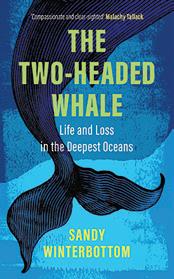
























As I type this wee column of mine, it is still October but the Xmas themed tatt is beginning to appear on the shelves of many shops, including our local farm shops.
Yep, we will soon be browsing around looking at organic eggs, meat and poultry with the sound of Noddy screaming “It’s Chrstimaaaaas” in our ears.
I expect that Noddy enjoys his annual royalties boost off course, just in time for the really cold winter nights ahead… lucky him!
DUCK!
That’s what we have had for the last few years due to pure laziness on my part.

A few pricks of the skin, bang it in the oven and leave it to do its own thing – simples!
(To quote those tall ratty things on TV).
Our pilgrimage to the local farm shop to place our festive food booking will be soon, and to be honest, our local farm shops are brilliant.
A great source and fantastic produce, lovely gift ideas and tree decorations– albeit no too cheap those…ach the tree’s worth it! - and then a good sit down with home baking and fab hot chocolate…sorted!
What could be better in the dark and cold days that a lovely warm and welcoming farm shop.
I hope you all have great farm shops to visit this coming winter, and to paraphrase a well kent Scots phrase, “lang may yer woodburners and lumbs reek”.
Slàinte, AtholeSyngenta vegetable Seeds welcomed more than 1700 guests to the company’s annual Fields of Innovation open days in Grootebroek, Netherlands, recently in September.

Fields of Innovation featured more than 550 varieties of 25 unique crops on the four-hectare site. Growers and guests from around the world discovered, tasted, and discussed new varieties with a team of experts in the field.
Visitors joined experts to discover the newest vegetable varieties from the R&D pipeline and experience the Plant Pathology Lab detailing the 12 to 20 years of research, trials and development by breeders and researchers to bring new varieties to grower fields.
For the first time, the event included a TechZone, featuring some cutting-edge technologies enabling farmers to be more productive, profitable and sustainable. Syngenta experts
showcased Interra® Scan, the Biodiversity Sensor and the EDAPHOLOG soil insect sensor.
Arend Schot, Syngenta Vegetable Seeds Head Europe, Africa, and Middle East, said: “This year we set an attendee record with people eager to learn more about our key varieties and other Syngenta innovations.
“This has become a major meeting point for growers and their customers, distributors
and our own breeders, and our product development and commercial teams,” he reported.
“Our tireless commitment to finding solutions for growers will never change. The technologies we showcased at Fields of Innovation are proof that we want to work handin-hand with growers to solve the challenges they face every season so we can become their true partner in their challenging work to feed the world.”
An innovative trial exploring if a new slurry additive can improve nutrient availability in digestate has shown a 20.3% increase in available nitrogen content and a 29% reduction in dry matter solids after the first year.
The new Digest-It slurry additive from Origin Fertilisers is a live liquid biological bacteria that has been used
in digestate for the first time and has been well proven to significantly reduce ammonia emissions and increase ammonium nitrogen levels in slurry. The trial took place at a 1.2MW anaerobic digestion plant in Lincolnshire.
The 20.3% increase in ammonium nitrogen was shown after a 12-week period following the application
of Digest-It. A further 29% reduction in oven dry solids has translated to the digestate being easier to pump, which in turn has reduced machinery wear and fuel use, along with shortening filling times.
As an outcome of reducing solid content, the digestate has a thinner consistency and is therefore easier for the plants to absorb following
application to the soil. Plants aren’t using as much energy to search for nitrogen, and nitrogen losses through volatilisation are reduced.
Callum Norman, speciality sales manager at Origin Fertilisers, who was involved in the trial, says that while the headline increases make excellent reading, the wider benefits of applying Digest-It shouldn’t be overlooked.

“The treated digestate had less nitrogen content than the untreated product. The upshot here is that the same amount
of land can have 13% more digestate spread on it before NVZ limits are reached, which could be hugely beneficial for growers on smaller acreages with excess digestate to spread.
“We are really pleased with the results of the trial. The environmental benefits, such as reduced volatilisation due to the conversion of ammonia into ammonium, and supplying good microbes to the soil, will be a huge benefit to all farms and help contribute towards agriculture reducing its emissions,” concludes Mr Norman.
With the winter wheat drilling window looming large – but potentially still at least a few weeks away for those growers with a severe black-grass burden – ADAMA has released new data which shows the addition of pendimethalin and/
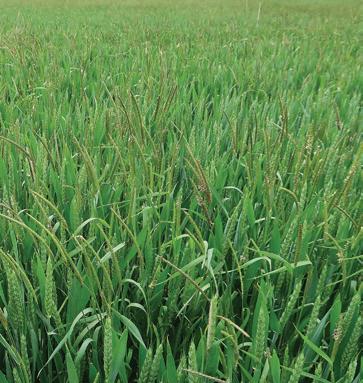
or diflufenican can deliver additional efficacy to some of the UK’s more popular herbicide co-packs offerings.
“As part of ADAMA’s remit to provide beneficial solutions to the problems faced by UK cereals growers, we recently


commissioned a series of trials to assess the efficacy of two popular pre-emergence herbicide copacks to determine how effective they are at controlling difficult grassweeds such as black-grass and ryegrass and to determine if their efficacy can be improved with the inclusion of additional tank mix partners,” explains ADAMA herbicide technical specialist, Dr Bill Lankford.
The first set of trials – to assess the impact of adding pendimethalin to an alconifen plus flufenacet and diflufenican co-pack – clearly demonstrated that the inclusion of Anthem (400g/l pendimethalin) improved black-grass control by reducing heading numbers by an average of 16%, with the benefit ranging from +3% to +26%.
“The same five independent trials also showed that adding pendimethalin as a tank mix partner helped to reduce the variability of black-grass control,” Dr Lankford adds, “with all five trials showing a significant uplift and consistency in protection.”
The trials also indicated that adding diflufenican to a tank mix of cinmethylin plus pendimethalin reduced the variability of blackgrass control.
“The addition of diflufenican to the mix also delivered a 10% reduction in heading numbers when used against flufenacet
resistant ryegrass,” Dr Lankford explains.
“What we’ve shown is that the inclusion of an extra active ingredient provides a useful boost to a pre-emergence
herbicide co-pack,” Dr Lankford summarises. “In a year when fuel and fertiliser costs remain high, and with crop values also remaining elevated, it makes sense for growers to
provide crops with the very best levels of weed control, with relatively cheap actives such as pendimethalin and diflufenican offering a viable return on investment.”
Selecting farm sprayer settings with the Syngenta Spray Assist App will ensure operators are always following best practice and could deliver up to 40% better results for autumn grass weed control, compared to some onfarm techniques.
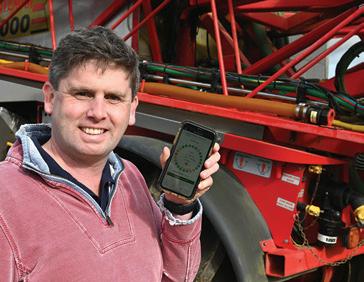
Results of Spray Assist trials conducted last autumn showed an average 25% improvement in black-grass control from the same herbicide treatment and application timing, by following the App’s recommendations for nozzle selection, speed and operating pressure in the prevailing weather conditions.
Syngenta application specialist, Harry Fordham, explained: “Spray Assist looks at the crop, the growth stage, treatment and weather forecast, to recommend the optimum nozzle selection that the sprayer operator has available, along with the advised water volume, pressure and speed, to achieve the best results possible.
“The algorithms used are based on a huge resource of
Syngenta trials data and nozzle manufacturers information. The App can make recommendations for 17 different crops with over 100 different treatments and timings. It will only make a recommendation from the nozzles and equipment that have been pre-programmed by the operator, so every calculation is specific to that farm and cropping.”
Harry pointed out that Spray Assist can draw on weather
information from multiple sources across the UK, Europe and the world to provide accurate predictions of wind and rainfall conditions up to five days in advance of an application. If the weather forecast changes, the App will adapt the advice provided.
Spray Assist is available to download now from the App Store and Google Play.
Leading vegetable handling equipment manufacturer Tong Engineering has announced its latest product development, which will see advanced optical sorting options available on all new models of its popular fieldloader machine, the FieldLoad PRO.
Designed to allow growers to effectively clean and load crop in-field and on-farm, the FieldLoad PRO is one of the latest Tong machines on offer with fully-integrated camera sorting facilities, further reducing labour requirements when processing crop straight from the field.

“With rising costs and an increasing need for growers to streamline their post-harvest operations to get tractors and trailers off the roads, carting less soil and generally minimising crop mileage and associated expenses, the demand for our FieldLoad PRO machine has continued to increase since its launch in 2018,” says Charlie Rich, Sales Director at Tong Engineering.
“Our flagship mobile grader, the Caretaker, has long been available with
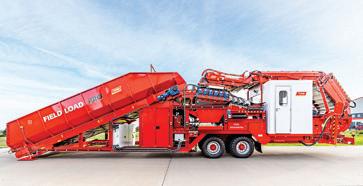
integrated optical sorting as a replacement of traditional manual inspection, with proven success and continued demand. However, with an increasing number of growers choosing the configuration of the FieldLoad PRO for maximum flexibility in loading crop straight into boxes, bulkers and bulk storage, the new option to incorporate optical stone and clod removal within one fully-integrated fieldloading machine brings an unrivalled post-harvest solution that ticks all the boxes,” explains Charlie.
Suitable for use on a wide range of root crops including potatoes, carrots, onions and more, the self-contained and compact FieldLoad PRO features a high capacity reception hopper feeding a choice of crop cleaning units including Tong’s renowned EasyClean separator available with AutoTouch HMI controls, as well as the company’s high-speed PU coil cleaning system and star cleaning units. Custom-built to suit grower’s exact specification, the FieldLoad PRO is built with a spacious 4-man inspection area as standard, with the new optical sorting option is offered
as an alternative to the standard inspection module.

“We have been working closely alongside optical sorting specialist TOMRA for many years and our recent Optical
Sorting LIVE event has provided a real insight into what can be achieved when integrating optical,” says Charlie. “The event has given customers throughout the UK and worldwide a chance
to see the TOMRA sorter in action at our new manufacturing facility, with the opportunity to run their own crop through the sorter. The results have been very impressive both in terms
of the amount of labour that can be saved at this stage of the post-harvest handling process, as well as the potential reduction in storage costs as only good crop is being stored.”

In order to avoid unnecessary yield penalties when late drilling winter wheat, it is key to select the right winter wheat variety.
Late drilling presents a unique set of challenges to the wheat crop as soils are cooler and wetter, so proceed with care and consideration in order to get the crop well established, says Limagrain UK’s Ron Granger.
“Delayed or late drilling of winter wheat considered to be from mid-October onwards is now common practice particularly for black-grass management, in a second wheat situation and for those who are drilling wheat after sugar beet or potatoes.”
“Although most of the varieties on the AHDB Recommended List can be drilled late, it is important to make a distinction by choosing varieties that will cope well, rather than be challenged by the situation.”
“Get it wrong, and you could be facing fairly substantial yield penalties – which are totally avoidable.”
“Characteristics of wheats that suit this slot are strong tillering and vigorous, combined with good rooting attributes and a semi prostrate growth habit in the winter,” he explains.
“Crops drilled later will not have been in the ground as long
as those drilled earlier in the autumn, so the chosen variety needs to be robust with a good tillering ability and quicker
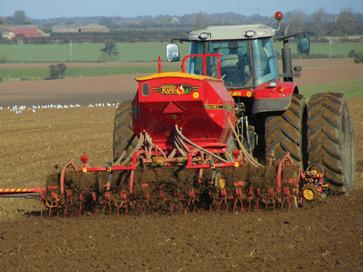
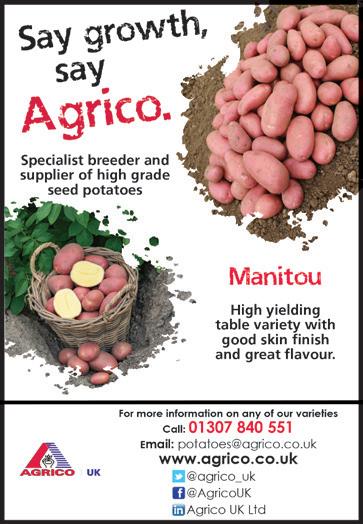
out of the blocks in the spring, once growing conditions are favourable.”
Mr Granger points out that this is especially important where there is black-grass as the variety needs to compete with the rapid growth of the blackgrass rather than sit and tiller flat to the ground where it will eventually be smothered.
For these reasons Mr Granger recommends LG Skyscraper and the new variety in the Limagrain portfolio, LG Redwald for late drilling slot.
One of Ireland’s leading fullservice fresh produce providers has this month completed a £1.5m investment as demand for its carrots continues to grow.

Meade Farm Group, which has grown from a small potato supplier to local shops to a grower, packer and distributor of fresh produce to retailers across Ireland, has this month increased its throughput by over a third.
The increased capacity has been achieved by Haith Group, which designed and installed a state-of-the art carrot grading and washing line at Mede’s facility in Lobinstown, County Meath.
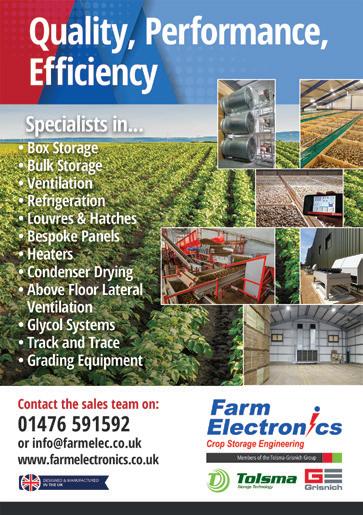
Taking six months to deliver, Haith’s full stainless steel line features two optical sorters, washing, de-stoning and polishing machinery.
Integrating optical grading from Newtec, which supplied a Celox optical sorter, the line is capable of handling 12 tonnes of carrot per hour.
The carrots enter the process form tipping trailers into a Haith supa-flow receiving hopper then pass through a Haith pre-soak immersion tank with integral destoner, which removes the heavy clay soil. A Haith SupaWash and MkIII Root Veg Polisher, with automatic rotation change for optimum brush life, follow before the field heat in the carrots’ core is lowered by a
Hydrocooler. Finally, the carrots are sorted by size and quality and enter one of seven channels.
“Meade Farm has been a valued customer for several years, and as they’ve grown, they’ve asked us to design and install increasingly sophisticated packing lines for them. Meade prides itself on delivering quality produce to its customers, and our vegetable handling machinery plays a key part in this,” says Duane Hill, managing director of the double Queen’s Award for Enterprise-winning company.
“Meade uses five of our root veg polishers, seven of our selfcleaning barrel washers and four Haith Rota-Tip box tipplers, and we are incredibly appreciative of their loyalty to us.”

improve the way they work,” he highlighted.
“Previous FSOOTY finalists remain firm friends and continue to share experiences, long after the competition is over.”
FSOOTY gives sprayer operators clear recognition for their highly important role, as well as enhancing their continuous professional development and industry position.

The healing effects of Manuka honey are well established and widely recognised. The NHS even recommends Manuka Medihoney as an effective treatment for wounds and burns.
Manuka honey comes from New Zealand and Australia, and is made by bees that feed on Manuka flowers, a plant in the tea tree and myrtle family. However, in a collaboration that crosses the globe, researchers from The James Hutton Institute have been examining the medical potential of honeys made from other crops to act as anti-microbial agents to fight against super-bugs.
have been able to pinpoint specific components in honey responsible for these superbug killing effects.
Dr McDougall said “The ability to identify these honey components opens the door to utilising Scottish crops such as heather for medical purposes. Further research would allow us to investigate the potential of other Scottish crops and isolate the most active components either from the honey or the original plant sources to use in wound-healing lotions or bandages.”
The Farm Sprayer Operator of the Year Award (FSOOTY) is now open for entry. The competition recognises the very best practice in sprayer operation, as well as providing a great opportunity for operators to share experiences and advance their learning.FSOOTY is hugely rewarding for everyone to enter and great fun to be involved in the camaraderie between sprayer operators, according to Syngenta Application Specialist, Scott Cockburn. “Everyone who enters has the same application challenges and frustrations, so there’s a huge amount to gain from sharing the solutions. One thing that’s repeated every year is that entrants find they learn something new from other operators and can
All the finalists win a trip for two to Cereals 2023 and are presented with their awards in the Sprays & Sprayers Arena. The overall winner claims a study tour to the awe inspiring Operators can enter FSOOTY 2023 direct on the Syngenta website - https:// www.syngenta.co.uk/fsooty - or through the dedicated application advice website, Ei Operator. Entering FSOOTY automatically gains NRoSO points. Farmers and agronomists can also nominate sprayer operators for entry on the Syngenta website.
Operators will also be able to enter the competition on the Syngenta stand at LAMMA in January. Entries close on 11 January 2023.
Recent studies by Dr Gordon McDougall, Head of Plant Biochemistry at the Institute and collaborators at Queen Margaret University and Nazarbayev University School of Medicine (NUSOM) in Kazakhstan have found that various honeys, including some originating from Scottish heathers, have the same anti-microbial activity as Manuka Medihoney.
By using the Hutton’s analytical know-how and studying the composition of honey made from a variety of crops, the researchers

Over the course of the research, NUSOM and the Hutton also identified that the non-sugar components of the honeys protected the immune response of human skin cells. Dr Pauline McLoone, principal investigator, said “Paired with the anti-microbial properties of honeys, this effect on skin cells could promote wound healing and further the use of natural, honey-based products in medical care”
The James Hutton Institute is a world-leading scientific research organisation working to resolve global challenges in food, climate, energy and water security. The Institute works in partnership with people, organisations and governments to enhance sustainable environmental, social and economic development to deliver practical solutions for our shared future. www.hutton.ac.uk
Over the last six years, change has come at us fast. We’ve seen the continuing effects of Brexit, the fallout from Covid, escalating pressure from the climate crisis, the conflict in Ukraine and resulting energy price surges.
Times of transformation can create a sense of overwhelm, but Philip Cosgrave, Yara’s Country Grassland Agronomist, is keen to remind farmers of something: Without change, there would be no new opportunities.
One such opportunity is the higher profile of food security. This issue has come to the fore thanks to a combination of events, not least the import challenges of Brexit, Covid ravaging the supply chains, and war in Europe. The government has now committed to producing a food security report every three years. The initial report, published last year, confirmed what many farmers already know: the nation isn’t as selfsufficient as it once was.
Self-sufficiency is particularly important when the international trade landscape is shifting as it is at the moment, but the steep climb to the UK’s climate targets makes a boost to the nation’s self-reliance even more vital.
But Philip is under no illusions about the size of the task: “The UK is a densely populated, small island, and land is not as plentiful as we might like, so feeding ourselves, whilst protecting the environment and ensuring farmers see some financial benefits, can be difficult.”
Precision pays Fuel scarcity and inflation have
nibbled away at profit margins, and Philip wants farmers to focus on two words: precision agronomy. “It’s been a buzz phrase for many years but is fast becoming the only way farmers can be sure to secure a good return for their efforts.”
Philip underlines the importance of taking inventory of all operations and taking time to fully understand the details of inputs and the resulting outcomes. That way, Philip says, “farmers can make informed decisions that will improve their return on investment.”
Harnessing scientific innovation allows for fine-tuning of outputs too, says Philip. For example, analysing outputs allows farmers to adjust nutrients and processes to optimise quality and yield.
This approach, of only adding what’s needed, is better for farmers’ wallets, but Philip is keen to emphasise its role in countryside stewardship too:

“Precise delivery maximises outputs without impacting our environment. Plus, looking after our soil fertility helps to secure future yields.”
Extreme weather events are an ever-increasing part of farming, from late frosts, to heatwaves, to flash flooding.
Philip underlines the importance of protecting yields with targeted, timely responses to extreme weather events: “Whilst we can’t control the weather, we can control how we react to it.”
Philip has huge respect for farmers’ strength and resilience – it’s woven into the sector’s heritage. For centuries farmers have turned challenges into
opportunities, and today’s farmers have access to technology and data that farmers of the past could never have dreamed of. Every farmer today has the power to innovate, Philip says.
“But using modern-day tools and understanding doesn’t mean we should ignore the past. Before World War II integrated farming systems were commonplace –arable sitting along livestock and some farmers are seeing the
benefits of returning to these systems.” These older systems often allow for reducing input costs as well as diversifying. Philip continues, “Innovation comes in many forms. Standing still and doing the same thing we’ve always done is no longer an option – we need to find ways of reducing costs, using land more efficiently, increasing our appeal to end users, and maximising emerging opportunities.”

Highland Fine Cheeses, maker of iconic brands such as Caboc and Strathdon Blue, is celebrating its two gold, one silver, and two bronze successes at two highly regarded award competitions, the first at the 2022 International Cheese and Dairy Awards (ICDA) held at the Staffordshire County Showgrounds in August, another at the recent Global Cheese Awards (GCA) in the Somerset town of Frome.
Judges at the 125-year-old former event, which attracts around 5,500 entries and 40,000 visitors, decided that the company’s Blue Murder, a bold, strongly flavoured cheese made with cows’ milk from the Highlands, was worthy of a ‘gold” award.
Another Highland Fine Cheeses product, Fat Cow, a Gruyere-style semi hard, washed rind cheese with a strong meaty aroma, delicate sweet flavour, and smooth texture, was deemed worthy of a ‘bronze’ award, as well as winning the same accolade in the Best Scottish Cheese category.
At the latter event, held annually in Somerset since 1861, Fat Cow topped the rind washed hard cheese category with a “gold” accolade, while Blue Murder won the “silver” award.
Owner Rory Stone, whose parents established the near-£2 million turnover company in the 1950s, said: “The ICDA and the GCA are amongst the world’s biggest platforms to champion world class cheese and dairy products, and are watched closely by retailers and food service companies all over the world, so it is a huge honour to be awarded these accolades.
“We are, I think rightly, proud of Blue Murder which we
have been developing over the past few years, and it is a huge tribute to our team here at Tain in Ross-shire, that it has appealed to the palates of two highly sophisticated judging panels.
“To win awards for our Fat Cow cheese, is also a fine tribute to all the hard work that goes into its production at our farm-based factory.”
The awards follow a series of major steps forward for the 14-strong business. From earlier this summer, its Morangie Brie, named after the Glen of Tranquillity, has been promoted by M&S at its outlets across London.
In addition, the company’s recently re-affirmed relationship with Kent-based dairy product giant, Rowcliffe, the UK’s leading importer and distributor of quality cheese and fine food, has led to Rory’s cheeses featuring in Waitrose selection boxes sold from its deli counters across the UK as part of the chain’s lockdowninspired support for artisanal cheesemakers.
Rowcliffe is now among Highland’s top five customers, taking 10 per cent of its output. Other major buyers include Co-op, Aldi, Lidl, Crest, Clark Speciality Foods, Braehead Foods and Williamson Food Service.
Other products in the Highland Fine Cheeses range – creamy Caboc, pungent, washed rind Minger, Skinny and Black Crowdie, Highland and Morangie Brie, Strathdon Blue and Tain Cheddar – have also won a number of national and international awards.
Until the turn of the century Highland Fine Cheeses focused
on distinctive Scottish cheeses such as Caboc and Crowdie for the domestic Scottish market. It now specialises in blue, brie and washed rind cheeses, which make up 90 per cent of its output.
Rory added: “Despite challenges in the form of soaring raw materials – milk prices have gone up by 60% - as well as energy and labour costs, we are now very well positioned to flourish in a greatly expanded territory.”

Food & drink market trade specialists visited Scotland recently to experience what sets Scotland’s red meat apart.
As part of a trade tour to meet food & drink producers and processors organised by Scotland’s trade and inward investment agency, Scottish Development International (SDI), 25 global and domestic
trade specialists heard first-hand from key industry contacts to understand what makes products from Scotland different.
Quality Meat Scotland (QMS) supported with visits to an Aberdeenshire beef farm and a processor near Edinburgh.
QMS Director of Market Development, Tom Gibson, said: “There’s no better way to
market our product than giving a first-hand experience of what is behind the Scotch Beef, Scotch Lamb and Specially Selected Pork brands. This was a really valuable opportunity to build relationships and demonstrate the ‘why’ to those who are helping sell our products across the world.”
Aberdeenshire beef farmer, David Barron, who is also vice-chair of the Scottish Beef Association, showcased animal welfare and sustainability on his farm, alongside a presentation from QMS Head of Industry Development, Bruce McConnachie.
At leading Scottish processors AK Stoddart in Broxburn, Sales Manager Brian Chapman and General Manager Brian Steven gave a tour to explain product sourcing and producer groups, processing systems, product selection for customers and an overview
of different cuts, customer specifications and dry aging.
QMS’ Mr Gibson followed this with further detail on carcase balance, the Scotch and Specially Selected Pork proposition in international markets and the role of QMS in developing new markets, potential international target markets for Scotch and the importance of exports to the Scottish economy.
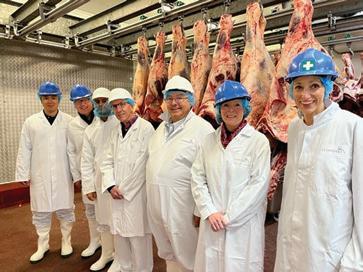
Ewen Cameron, Global Head of Trade, Consumer Industries, at SDI, said:
“We spent two very inspiring days meeting with companies and partners across Scotland with our trade specialist colleagues, 12 of whom are based overseas. It is so important when you are selling Scotland to have the opportunity to visit and hear firsthand from farmers, fisherman and processors about everything involved in producing highquality, premium Scottish food and drink.”

Seed potatoes from the UK are no longer allowed into the EU, and that is hitting Scottish businesses hard. Scotland’s seed potatoes are highly prized, sought after by farmers across the world because our scientists, our farmers, and our climate deliver diseasefree, reliable tubers. Before Brexit, 77,000 tonnes of seed potato left our shores – with 20,000 of those tonnes heading to European nations. There was outrage recently when Scottish farmers learned the EU ban on seed potatoes was a one-way deal and that some English growers were importing seed potatoes from Europe, rather than from their Scottish counterparts.
“The UK Government is allowing this loophole rather than standing strong for Scottish farmers. We think the trade deal should be reciprocal,” says the Vice President of the National Farmers’ Union of Scotland, Andrew Connon. “We need to sort it out, but it all comes down to politics. The UK Government is in denial to reality, whether it is seed potatoes, trade deals, the lack of labour, or the impact of fuel costs on food production.”
Between the River Tay and the Sidlaw Range sits East Mains Farm, where Andrew Skea specialises in heritage, organic, and conservation varieties which are hugely popular in Germany and Sweden.
“We used to sell 40 high value varieties, but we have lost our exports completely –half of our sales,” Andrew explains. “We used to have a domestic market of 500 million people. That’s been cut to 50 million. The UK market alone just isn’t enough to keep some varieties going.”
Andrew set up ‘The Potato House’, selling a range of organic and conservation seed potatoes directly to gardeners who appreciate the flavour and value of heritage varieties.
“We sold 250,000 seed potatoes last year. It no way makes up for the European trade we have lost, and we have cut our range significantly, but it is a welcome addition. I feel I’m due some luck,” Andrew says with a smile.
Ruth Watson is the founder of the Keep Scotland the Brand campaign.

A dynamic initiative, which will equip budding entrepreneurs for success in Scotland’s food & drink industry, is launching for a second year. Drawing on expertise from two Scottish academic institutions, the THRIVE programme will provide outstanding opportunities for young food & drink and rural SMEs, students, and graduates, while strengthening sustainable growth in Scotland’s food & drink and rural sector.
The programme is the result of a collaboration between Queen Margaret University and Scotland’s Rural College (SRUC). THRIVE is an ambitious
initiative which will provide food & drink and rural micro-SMEs, students and graduates with the specialist knowledge required to support their successful entry into the sector. The intensive two-day programme will equip new graduates, as well as people already working in foodassociated SMEs, with essential sessions run by food industry experts that will support the early stages of transition into, or within, the broader industry.
For further information on the THRIVE programme email; HelloSCFDI@qmu.ac.uk or foodanddrink@sruc.ac.uk.
Noble Foods has announced a six pence per dozen price increase for all its free-range and organic producers, beginning 8th October 2022.

The increase comes from the UK’s largest egg packer despite the challenging financial and retail climate. The six pence per dozen rise includes all Class A eggs (Extra Large, Large, Medium and Small grades) from all free-range and organic
producers in the Noble Foods group.
Reflecting on the increase, Graham Atkinson, Agriculture Director at Noble Foods said: “Our producers are facing turbulent cost pressures, many of which are a knock-on effect from global events. But the resulting inflation issue cannot be ignored. The support and attention must be with our producers, which is why this price increase is so necessary.
Because we operate long-lasting feed deals across our base, this increase reflects non-feed related
inflation elements. I hope it demonstrates our long-term intent to put our producers first.”
Food and Drink Federation (FDF) Scotland and Quality Meat Scotland (QMS) have
teamed up to develop a new food education resource to help young people learn about the
people and processes involved in getting quality food to the table.
Based on the familiar process of creating a burger and targeted at S1-3 pupils, ‘Make it With Meat’
will support interactive sessions that cover everything from the nutritional content of ingredients to product development, testing and labelling. Students will also hear about the important people and careers in our food chain on their journey to discovering more about the farm to fork process.
Offering a flexible approach, teachers can pick and choose the lessons that meet their teaching requirements using videos, PowerPoint and other resources. Each lesson has a ‘go further’ section which can be used in class, for at home learning or for fast finishers.
Trialled at Hawick High School in the Scottish Borders, Home Economics teacher Shona Murray commented on both the ease of use and positive reaction from the children:

“We were asked by QMS to trial the new Make it with Meat resource and we had the opportunity to give it a go with some of our S1 and S3 pupils. It’s great because everything is there
for you in the six lessons, from farming through to nutrition, and costing to careers.
“Depending on your preferences and stage of your
pupils, lessons can be selected and adapted as necessary. Doing the entire project as part of a block is, of course, also an option.
“Our S3 pupils did all six lessons and then designed their own burger, and they all thoroughly enjoyed the project.”
NESCAFÉ, Nestlé’s largest coffee brand and one of the world’s favourite coffees, has outlined its extensive plan to help make coffee farming more sustainable: the NESCAFÉ Plan 2030. The brand is working with coffee farmers to help them transition to regenerative agriculture while accelerating
its decade of work under the NESCAFÉ Plan.
The brand is investing over one billion Swiss francs by 2030 in the NESCAFÉ Plan 2030. This investment builds on the existing NESCAFÉ Plan as the brand expands its sustainability work. It is supported by Nestlé’s regenerative agriculture
financing following the Group’s commitment to accelerate the transition to a regenerative food system and ambition to achieve zero net greenhouse gas emissions.
“Climate change is putting coffee-growing areas under pressure,” said David Rennie, Head of Nestlé Coffee Brands.
“Building on 10 years’ experience of the NESCAFÉ Plan, we’re accelerating our work to help tackle climate change and address social and economic challenges in the NESCAFÉ value chains.”
Rising temperatures will reduce the area suitable for growing coffee by up to 50% by 2050. At the same time, around 125 million people depend on coffee for their livelihoods and an estimated 80% of coffeefarming families live at or below the poverty line[3]. Action is needed to ensure the long-term sustainability of coffee.
“As the world’s leading coffee brand, NESCAFÉ aims to have a real impact on coffee farming globally,” said Philipp Navratil, Head of Nestlé’s Coffee Strategic Business Unit. “We want coffee farmers to thrive as much as we want coffee to have a positive impact on the environment. Our actions can help drive change throughout the coffee industry.”


Uzbekistan’s new International Agriculture University, a partnership with the UK’s Royal Agricultural University (RAU), has officially opened in the nation’s capital Tashkent.
Just days after welcoming the first 200 students to its new courses, the grand opening ceremony took place attended by Uzbekistan’s Deputy Prime Minister Jamshid Khodjaev, Minister of Agriculture Aziz Voitov, as well as RAU ViceChancellor Professor Peter McCaffery and Dr Munira Aminova, Acting Rector of IAU.
After signing the Memorandum of Understanding between the two institutions, Mr Khodjaev and Professor McCaffery attended a ribbon cutting ceremony to officially open the new building, which has been named The Queen Elizabeth II Building in honour of Her Late Majesty Queen Elizabeth II who was also the Patron of the RAU.
Professor McCaffery and Mr Khodjaev then planted a tree to commemorate the opening and Professor McCaffery gave Mr Khodjaev a commemorative plaque to mark the partnership between the two institutions.
Speaking at the ceremony, at which the new first year students made a “student pledge” as part of their Matriculation ceremony, Professor McCaffery said: “Today’s launch of the International Agriculture University (IAU) opens up an exciting new chapter in our history.
“That the RAU was chosen as the founding partner by the Uzbekistan Ministry of Agriculture, against competitors from North America and Europe, bears testament to our mission, vision and approach to agricultural education.
“With the potential to exceed 3,000 students in three to five years, the RAU is uniquely placed to be ‘the UK’s International Agricultural University’. The surpluses generated - like those from our links with Chinawill go towards improving the experience of all our students, including Cirencester.”
The aim of the new International Agriculture University is to lead the reform of higher education in agriculture
in Uzbekistan and secure international recognition for agriculture’s role in Uzbekistan’s transitional economy and society.
The partnership will give IAU students an equivalent educational experience to that of students at the RAU, with IAU students accessing a blend of face to face and online lectures and resources, by franchising some of the RAU’s existing degree programmes, and developing new degrees and modules to suit Uzbekistan’s conditions and its international trade ambitions as the new university grows and develops.
Dr Aminova said: “Today we are planting a seed for the new knowledge, new generation of young and ambitious people, and

we hope this seed will grow big in the future and bear fruits. We want to give our students the best student experience, back them up with the critical thinking, analytical skills, knowledge, but also an empathy, a compassion and other soft skills.
“Two weeks ago, we welcomed our students to the IAU family. Today we are welcoming them to IAU’s home – the home that they will remember with joy and fond memories when they graduate. The home where they can engage into different activities and develop further your student union, and pitch your ideas and have other stimulating activities and pursue your goals together.”
 By Wendy Barrie
By Wendy Barrie
With lovely seasonal vegetables, homegrown or locally sourced, even my carnivore husband enjoys this lasagne. Vegetables will vary with availability - today’s version has parsnips, leek, carrots and peas. For this recipe we grew Eichdorfer Gelb, a yellow beet from 1809, instead of using pasta sheets – it’s really delicious.
Ingredients:
2 large carrots & parsnips
2 leeks – ours aren’t very large yet
A small handful of chanterelles – fresh or dried
1 head of broccoli, broken into florets
A cup of peas
Blackthorn sea salt & milled black pepper
A generous scrunch of dried/fresh marjoram leaves – still widely available just now
1 carton chopped tomatoes/pulp
Method:
• Rinse and peel roots. Cut in wedges.
2tsps pesto Drizzle of Supernature rapeseed oil Lasagne sheets or Eichdorfer Gelb beet, finely sliced on a mandolin
White sauce: 50g butter, 50g flour, 600mls milk, 1tsp of Galloway Lodge wholegrain mustard
150g mature farmhouse cheese, grated – this one is Carrick from the Ethical Dairy
• Drizzle a little oil in a wok or large frying pan and sauté roots to caramelise edges.
• Add leeks and mushrooms and toss in pan with seasoning.
• Add tomatoes, rinsing out the carton to add further tomato and a little extra liquid.
• Lid on and simmer until the sauce thickens a little. Add raw broccoli florets and peas. Set aside.
• Meanwhile make sauce by melting butter in a saucepan. Season with salt and pepper, add flour and bind together to make a roux. Gradually add milk, whisking with a balloon whisk to ensure a smooth incorporation as the sauce comes up to the boil. Once all the milk is added, add mustard and simmer for a couple of minutes to cook the flour and thicken the sauce. It should coat the back of your wooden spoon.
• Finally finely slice your beet or lay out sheets of dry lasagne.
• With all components ready, layer the tomato/veg mix, then thin slices of raw beet - or raw lasagne sheets – white sauce and repeat, finishing with a layer of beets and white sauce. The mix should be moist to hydrate and cook the pasta or beets you are using.
• Bake, covered with foil, for 45 minutes in a medium oven then remove cover.
• Scatter with grated cheese, increase oven temperature to 200°C and bake, uncovered, until the cheese topping is bubbling and beginning to colour.
Serves 4 with pickles or chutney and salad. Delicious re-heated the following day.
Scottish Thistle Award Regional Ambassador (2018/19) for Central, Tayside & Fife, Wendy Barrie www.wendybarrie.co.uk is a highly respected campaigner for local sustainable food, popular cookery show presenter and food writer.
Founder & Director of award-winning www.scottishfoodguide.scot & www.scottishcheesetrail.com Wendy is Leader in Scotland for Slow Food Ark of Taste & Member of Slow Food Cooks Alliance.

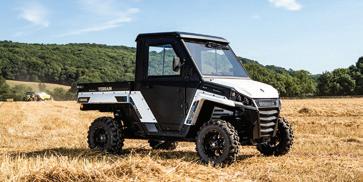
BRP is expanding its Can-Am off-road side by side vehicle (SSV) line-up with the addition of the new Can-Am Traxter 6x6 DPS HD10. This new unit delivers the functionality of a six-wheel drive vehicle to a workhorse SSV and will present new job opportunities in multiple sectors including farming, estate management, and facilities maintenance. This combination ensures the Traxter 6x6 DPS HD10 can handle everything from hauling machinery to transporting workers and equipment to job sites, while providing owners with the comfort, power and performance that is expected from a Can-Am Traxter.

The new SSV enhances the comfort and control of the original Can-Am Traxter with the help of its longer wheelbase and triple axel design, which spreads the weight of the vehicle so that it treads carefully across multiple terrains. This ability is complemented by the performance of the 82hp V-twin liquid cooled engine from Rotax® and ensures that no destination is out of reach.
The Can-Am Traxter 6x6 DPS HD10 also provides owners with class leading towing, payload and cargo capacity that come in at 1,360kg, 771kg and 454kg respectively. These capacities are aided by the extended cargo box, which allows it to carry more goods and equipment. The integrated design elements include the LinQ quick-attach system,
built-in anchors, tie-down points and recesses for easy box separator solutions, which make it easy to customise the vehicle for the job at hand.
In addition, its 40-litre fuel tank makes it a work-ready vehicle that can spend hours performing without the need to come in to refuel.
When it comes to the interior, the SSV’s roomy and intuitive cockpit has been designed by Can-Am’s R&D team with functionality and comfort in mind. This is highlighted by the cab pillars
being pushed forward, an opendash configuration, and a truckinspired VERSA-PRO bench
seat that accommodates up to three adults and flips up for additional space in the cab.
Now there is a 100% electric 4x4 utility vehicle that is truly built from the ground up for serious work. That is the promise from Corvus, Europe’s first manufacturer of 4x4 UTVs and the Terrain EX4 lives up to expectations. This is an electric 4x4 capable of successfully tackling the toughest working days thanks to its off-road capabilities. The engine is a 13kW AC induction 48V motor capable of hauling a payload capacity of 620kg and the EX4 has a towing capacity of 755kg in low and 479 kg in high. The cargo box is steel with a 300kg load capacity and there is more space for you and your gear with a front storage boot
and convenient under seat storage to keep the essentials handy.
The Terrain EX4 achieves 40km/h/25mph and can be driven on roads, making it ideal for a quiet, non-polluting everyday work vehicle. It offers high load capacity, lower maintenance and
high vehicle durability with the precision power needed for smooth or rough terrain. There is a dual power selector for ‘Range’ and ‘Power’ which allows you to select electronically the right driving mode for the most demanding jobs. With less maintenance and no
fuel costs, UTV electric vehicles are significantly more affordable and cost-effective than traditional petrol or diesel-powered vehicles. The 15kW lithium-ion battery on the EX4 is designed for quick and convenient charging.
From the start of its rapid acceleration, the EX4 is whisper-
quiet and as an off-road vehicle offers an enjoyable driving experience throughout the working day. With a ground clearance of 309mm and the choice of 4x4 and 4x2 power, even the most difficult terrain becomes accessible. All Terrain EX4 models are approved
to EU T1a standards and equipped with automotive safety windshield glass, three-point belts, indicators, headlamps and brake lights, horn, mirrors and windshield wipers.
There are three versions of the Terrain EX4 with a cab and other accessories available. Prices start
at £25,499.00 for the EX4 Base EPS, £26,499.00 for the EX4 Pro EPS and £28,499.00 for the EX4 CAB EPS. Colour choice is white, orange or green. Boss Offroad Vehicles Ltd has a dedicated UK Commercial Sales Team and extensive dealer network to assist with the purchase of the vehicle.
Honda’s UTV Pioneer 520 combines the benefits of side by sides and ATVs, marrying up safety and space found in side-by-sides with the nimble handling and a small, narrow footprint.

In 2015 Honda America launched the Pioneer 500, promising a true all-rounder that was as versatile as it was compact. A powerful workhorse, engineers behind the two-seater designed it to stand-up to tough off-roading and a wide variety of testing work environments where Honda’s legendary reputation for durability, quality, and reliability is demanded.
The key to the Pioneer’s enduring flexibility and allround ability has always been its layout. The 520 takes this to the next level with the introduction of a gas-assisted tilting rear bed. Measuring in at useful 29 inches in length, 38.7 inches in width and 9.8 inches high, the ample dimensions can swallow a multitude of items from multiple standard hay bales to buckets, crates and more. The ridged base design, three bed divider slots for ¾” partitions and five D-ring locations ensure the load stays secure regardless of the terrain.
Aiding this load carrying versatility is a tailgate that folds flush with the bed floor when open and integrates four cupholders, giving the operator somewhere to sit on a work break, or at the end of a hard days work.
Such useability has not come at the expense of durability, with the bed designed to carry loads of up to 204kg. The one-piece plastic item is hard wearing and features integrated taillights
for a more modern look. The monocoque shape and design of the rear bed weighs less than traditional steel items, aiding the 520’s handling for those seeking recreational fun.
This highly capable load lugging capacity is boosted further through an ample towing capacity. Capable of towing 454kg, the Pioneer 520’s overall load capacity of 658kg makes it a very useful tool for agricultural and commercial applications.
Designed to work hard, the range is led by the robust Mule Pro MX. Powered by a torque-laden 700cc CVT single-cylinder engine, the Pro MX offers 32.8 kW {45 PS} / 6,000 rpm, guaranteeing a funto-drive vehicle that can easily hail cargo for work or weekend fun. The spacious cargo bed is able to carry up to 700 lbs, making chores or hauling gear a breeze.
Measuring 110” long and 60” wide, with a wheelbase of 79”, the Mule Pro MX is the perfect mid-sized vehicle, offering superb manoeuvrability and mobility that ensures it can negotiate the tightest of trails. To maximise comfort, the all-terrain vehicle features doublewishbone suspension at the front and rear, enabling the Kawasaki to easily traverse obstacles and elevations with minimum effect on the chassis.
Kawasaki has focused on making the flagship Mule model as accessible and user-friendly as possible. Coming equipped with doors as standard, users will be protected from mud and puddles, while a 5.3 litre storage bin underneath the passenger seat ensures that there is plenty of space to securely store all of your belongings.
Bright digital instrumentation ensures you can always see essential information at a glance and the console also comes prepped for an accessory audio system.
The contoured bench seat complements the body and provides ample space and comfort for two adults at a time. Kawasaki’s high-grade Electric Power Steering (EPS) is speedsensitive, providing users with light steering at low speeds and
tightened steering at higher speeds.
Since its launch, the Kawasaki Mule range has established itself as one of the leaders in utility vehicles, used by farm workers, gamekeepers, construction workers and event workers across the globe.

When there’s a big job to do, the Ranger 1000 is the perfect partner to get it done. Thanks to its torquey ProStar 1000cc engine, providing ample low down power and its Pro-PVTi clutch system, delivering smooth drivability at low speeds, the Ranger 1000 gets on with the toughest jobs, regardless of the conditions.
Boasting a class-leading towing capacity of 1,134kg, the Polaris Ranger 1000 is engineered for work, offering impressive specifications throughout. With its 30.5cm of ground clearance and 25.4cm of suspension travel (front and rear) to rise above any obstacle, its impressive payload capacity of 454kg and a tight turning radius to stay agile in tight spaces, the Ranger 1000 is one of the most capable machines on the market. Factor in the multiple Lock & Ride mounting
locations as standard, to add key accessories needed, and you have one of the most versatile machines available too.
Inside, the capability and versatility continues. The cab features padded bench seats, a large glove box plus a lower dash bin, driver and passenger underseat storage and up to eight cup holders. With seamless accessory integration across Ranger Pro Shield cab system components and a pre-wired three-position Polaris Pulse electrical system under the hood, the Ranger 1000 ensures comfort and convenience all day long, no matter the conditions.
Available in Sage Green as standard, the Ranger 1000 is also available in a Nordic Pro special edition, featuring a glossy black pearl paint finish complemented by bright Velocity Blue springs, an in-cab heater and cab seal kit

fitted as standard along with 12inch black aluminium wheels and a Polaris PRO Heavy-Duty
2041kg winch for a helping hand in tricky situations. Starting at £15,499 excluding VAT
Yamaha has announced a range of modifications and additions to its ATV and side by side models with new colours, features, accessories, and technology, to offer agricultural operators’ greater choice and versatility.
The Kodiak 450 and 700 ATVs both offer the option of Electric Power Steering (EPS) and Diff-lock for greater stability on uneven ground. Special Edition (SE) specification models will offer alternative paint colours and all models will be supplied with a 10-year belt warranty and Datatool tracking devices free of charge.
Also new to the range is a revised Grizzly 700 ATV with MKII 686cc engine and upgraded 14-inch wheels. This combined with the Grizzly’s On-Command® 2WD/4WD drive system with Diff-lock makes it well suited to hill ground and wet conditions. The switchable drive system is operated using a switch on the handlebars to enable operators to move between 2- and 4-wheel drive as ground conditions change.
This coupled with Yamaha’s Ultramatic® CVT automatic transmission and independent long-travel adjustable suspension, makes the Grizzly easier to control and more comfortable on difficult terrain.
A new Wolverine RMAX 1000 side by side model will be launched in the UK in both SE and Limited Edition (LE) specifications. Both models benefit from a new VRX 45 winch, front bumper, interior lighting, dash mounted USB charger, and will retain Yamaha’s versatile D-Mode selector with sport, trail, and crawl modes.
The Wolverine RMAX LE is fitted with adjustable FOX 2 iQS suspension, and for the first time on a UTV this can be adjusted from within the cab. The LE model features a dash mounted control to adjust the ride quality based on the terrain. Operators can choose comfort, medium, or firm, with all controlled by a Bosch ECU and IP67-rated components.
Focussing on safety, Yamaha has introduced its speed
management key technology to the Wolverine RMAX LE. The key enables owners to limit the top speed to 25km/h without affecting power. This, Yamaha says, will protect both operators and machines in conditions where higher speeds are not required. The key can be removed by the owner to return the Wolverine RMAX to factory specification at any time.
Yamaha has also extended its commitment to operator safety by offering free ATV rider competency training from the European AllTerrain Vehicle Safety Institute (EASI®) to anyone purchasing a new Yamaha ATV. This training provides the necessary information and practical experience to operators, enabling the full features and performance of the ATV to be utilised safely in all conditions.

The first ever Welsh Agriculture Bill has been laid before the Senedd, paving the way for ambitious and transformational legislation to support farmers, sustainable food production, and to conserve and enhance the Welsh countryside, culture and language, Rural Affairs Minister Lesley Griffiths has announced.

The Bill also includes the Programme for Government commitment for a complete ban on the use of snares and glue traps. Wales will be the first country in the UK to introduce a complete ban.
This first ‘Made in Wales’ policy framework recognises the complementary objectives of supporting farmers in the sustainable production of food alongside taking action to respond to the climate and nature emergencies, contributing to thriving rural communities and keeping farmers on the land.
At its heart lies Sustainable Land Management which
establishes a policy and legislative framework aimed at ensuring farmers can carry on producing high quality food and agricultural goods for generations to come. Sustainable Land Management is based on four key objectives which are to produce foods and other goods in a sustainable manner, to mitigate and adapt to climate change, to maintain and enhance the resilience of our ecosystems and to conserve and enhance the Welsh countryside, culture, and to sustain the Welsh language and promote and facilitate its use
This Bill will introduce protection for agricultural tenants, ensuring they are not unfairly restricted from accessing financial assistance.
The Bill provides Welsh Ministers with the powers necessary to provide future support whilst also ensuring we can continue to support our farmers during a transition period, reflecting our Cooperation
Agreement commitment with Plaid Cymru.
Minister for Rural Affairs Lesley Griffiths said: “This historic Welsh Agriculture Bill not only impacts the agriculture sector, but everyone across Wales, from the food we eat, to how it has been grown, harvested, stored and prepared for sale. For the first time, we have the chance to build a system of support and legislation which works for our farmers, our sector, our land and our people.
“These are difficult and challenging times for our farmers. Climate change, rising costs, new trade deals and the war in Ukraine, are just some of the issues they face. This Bill provides a framework on which all future agricultural support will be delivered and outlines how we can keep farmers on the land, produce food sustainably and deal with the climate emergency.
“It also sets out how Wales will be the first country in the UK
to introduce a complete ban on the use of snares and glue traps. These devices catch animals indiscriminately, causing great deal of suffering, and they are not compatible with the high animal welfare standards we strive for here in Wales. A complete ban is the only way forward.
“In July I published the outline of our Sustainable Farming Scheme, and this Bill provides the framework on which all future agricultural support can be delivered.”
“I’m extremely proud of our farmers and the agriculture sector here in Wales. Through the provisions in the Bill, I want to ensure we can continue to support and encourage our farmers and producers to create and sustain a thriving agricultural sector.”
“I look forward to working with Senedd members during their consideration of the Agriculture (Wales) Bill over the coming months.”
4th generation farmer William Dandie works with his brother, father, and uncle to make 10,000 straw bales a year at the family’s farm near Edinburgh. 2,500 are used to bed 500 Limousin cross cattle, a process that has become far more efficient since they bought a KUHN bedding machine.

The farm immediately reduced straw usage and labour, with only two people needed compared to the four it took to bed out the herd by hand. The KUHN Primor 3570 machine is also able to distribute the straw more evenly throughout the shed. However, there is a further benefit that Mr Dandie has seen following his investment:
“We now sell directly to local butchers and so the look of the cattle and the shed is paramount because they post pictures on social media and use them in their butcheries. We therefore bed every other day, and that was taking a lot of man hours. I can’t believe we kept doing it by hand for so long,” he says.
The family is also pleased to be out of the dusty conditions. The move to a mechanised process has reduced dust levels thanks to the Cleanstraw dust control system on the Primor.
Available on new equipment or as a retrofit upgrade for existing machines, the Cleanstraw facility reduces dust in livestock buildings by applying a fine
mist of water to straw as it is distributed. It comprises a 64-litre water tank and three misting nozzles mounted at the exit of the straw blowing chute. The nozzles are fed by a pump which provides water at a flow rate to apply 1 litre of water per 100kg of straw, without slowing the machine’s normal performance.
Applying a mist of water at this rate, and in this way, eliminates excessive levels of airborne dust by reducing the amount of time that these particles remain suspended in the air. Trials have shown that the air in a typical livestock building will be dust-free within 30 seconds after straw-blowing with the Cleanstraw system has
ceased, compared to several minutes without the Cleanstraw facility.
“Adding a fine mist of water as straw exits the spreading chute means very little water is required. This preserves the straw’s absorbency potential, keeping it hygienic and also means the speed of operation is unaffected. This enables us to bed out the entire barn in an hour and a half.”
The Cleanstraw system is available on Kuhn’s Primor straw bedders that operate with the Polydrive hydraulically disengageable belt system that drives the feed rotor, and on the Profile Plus range of mixer wagons that have a bedding
capability. The system is automatically activated when the Polydrive is engaged and can also be armed or disabled via an in-cab switch.
By no longer expecting members of the team to be in with the cattle he is also protecting both.
“It was never really an issue being amongst the herd, but with the machine it is much easier and the cattle never appear in any way stressed when it’s working. This means we can minimise risk to both livestock and the team, make better use of the straw we have and improve the overall welfare of our cattle for the butchers who buy them.”
There were some concerns of moving to a mechanised process, but William, his brother, father, and uncle have all been very pleased with the outcome.
“You naturally feel like you don’t spend the same amount of time with the herd and when we took on the Primor we were concerned about stones getting into the machine, but we haven’t
had any issues and the stone strap works very well.”
The net result is that the family can sell more of the 10,000 bales they make each year to

generate extra income whilst also improving herd health on their own farm.

“We are finishing 400 head a year, so any economies we can
make count. The machine is in its third year, and we haven’t had any problems, so it has certainly been a worthwhile investment,” he concludes.

Ten companies have been awarded a total of £9.4 million to help Scottish industries reduce carbon emissions through decarbonisation and energy efficiency projects.
The recipients from the second round of the Scottish Industrial Energy Transformation Fund (SIETF) are predominantly involved in the manufacturing and food and drink sectors.
The projects include a more energy efficient dryer at a seaweed processing facility, whilst several brewers and whisky distilleries will also receive funding for projects that aim to reduce the emissions that are created during energyintensive manufacturing processes.
The projects awarded funding have the potential to reduce emissions by 40,482 tonnes of CO2 a year, the equivalent of the annual emissions from 17,000 households.
A further £160,000 has also been made available to conduct up to four engineering or feasibility studies into future projects that will aim to reduce emissions and increase efficiency within the sector by creating a pipeline of future projects.
First Minister Nicola Sturgeon announced the funding while visiting Graham’s Family Dairy, where previous SIETF funding allowed them to upgrade steam production and heat distribution infrastructure.
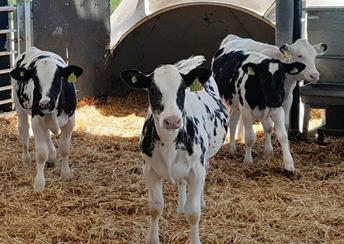
The First Minister said:
“Reducing emissions in our manufacturing sector will be a crucial step in ensuring Scotland reaches its net zero target by 2045.
“I am pleased that the Scottish Industrial Energy Transformation Fund continues to support companies across the sector to embrace decarbonisation, improve efficiency and reduce their impact on the environment.
“This week is Scotland’s Climate Week, which puts a renewed focus upon the ongoing climate emergency and our efforts to tackle it. And as households and businesses struggle with rising energy costs, it has never been more important to support industry to become more energy efficient.
“I welcome the work that the Fund has already supported and I hope that many more businesses will apply in the future.”
Up to £34 million of Scottish Government funding will be made available through the lifetime of the five-year SIETF, which runs until 2026. The third round of applications is now live.
Robert B Graham, Managing Director at Graham’s Family Dairy said:

“The SIETF programme has enabled us to accelerate our industrial decarbonisation programme, driving energy efficiencies and reducing waste. SIETF funding support has meant we have been able to deliver a number of process decarbonisation projects in parallel, to achieve scalable impact across our supply chain and share results to support Scottish industry & businesses with their journey to net zero.”
Peter Davison and Kieran Healey-Ryder from the Sustainability Leadership Team at Whyte & Mackay, which has
Biting and nuisance flies cause a lot of problems during the summer, especially on dairy farms, in calf units and more intensive beef systems. Areas that flies can effect are reduced live weight gain, mastitis, new forest disease and reduced yield. It is important to work out where your fly breeding grounds are, they are usually areas where dung and other forms of bedding can accumulate.
Parasitic wasps can be used to take a proactive, cost-effective approach that reduces the use of antibiotics and insecticides. This is a long-term approach to reduce your overall fly population and should be used in conjunction with other more traditional methods of fly control for the first few years.
Parasitic wasps are fly parasites, but they do not retain the characteristics that a wasp suggests. They are very small insects, approximately 2mm
in length and they only eat nuisance flies. Female wasps pierce the nuisance fly maggot pupae. They can lay up to 350 eggs per day and on hatching, the parasites subsequently eat the maggots. Over time, this cycle naturally reduces the nuisance fly population. Fly parasites should be introduced in areas where the breeding fly population is. For example, in standing muck areas that are not often disturbed like calving pens, calf sheds, straw yards, corners of cubicle sheds and additional areas of standing manure.
Timing is essential as fly populations increase over the season; a single fly can lead to hundreds of thousands later in the season if left to breed. One tube holds 240 wasps and treats 200m2, one tube costs roughly £34.00. Use of pour on will on average be reduced by 25% if the system is stuck to, as fly populations are significantly decreased.
secured second round funding, said:
“As whisky makers we believe in a sustainable future for what we do here on Jura. This Scottish Government programme is a galvanising platform for industry to come together and solve for a green future right across these islands.
“This grant will accelerate our journey towards a sustainable future for whisky making here on Jura.”
This is a Policy statement and relates to the 2021 pollutant emissions and waste transfers from SEPA-regulated industrial sites Official Statistics published at 9.30am on Tuesday 20 September 2022 and available on SEPA’s website.
Greenhouse gas emissions from SEPA regulated industrial sites fell by 5% between 2020 and 2021.
This continues the downward trend in greenhouse gas emissions since 2007.
Emissions figures reflect the continued impact of the pandemic on Scotland’s
industries in 2021, with the economy not fully recovering to pre-pandemic levels.
A major accidental release of fluorinated gases by Anglo Beef Processors in Perth is being investigated by SEPA. It is the second largest accidental release in the food and drink sector in Europe.

The Scottish Environment Protection Agency (SEPA) has published its Scottish Pollutant Release Inventory (SPRI) data for 2021.

SPRI provides a valuable picture of the amount of pollutants released in Scotland
from SEPA-regulated industrial sites. It is a publicly accessible electronic database and aims to provide information for policy makers, academics and the public about the pressure Scottish industry puts on the environment through greenhouse gas emissions. SPRI does not assess the compliance of the facilities or the health and environmental impact of the releases.
The latest data reveals greenhouse gas emissions fell by 5% between 2020 and 2021. This reduction continues the decreasing trend seen over the
last 15 years, with an overall drop of around 62% since 2007.
Global warming potential of greenhouse gases reported to SPRI since 2007 (kg CO2e).
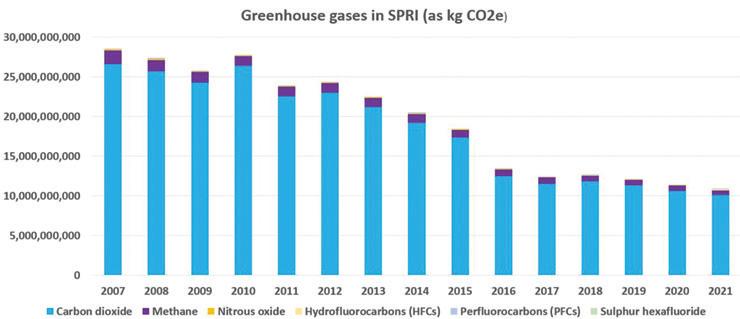
Table in notes to editors.
Ongoing impact of Covid-19 Around a third of the sites that report pollutant emissions to SPRI each year noted a significant difference in their 2021 data compared to 2020.
This is a similar proportion to previous years.
The economy in Scotland contracted by nearly 11% in 2020, as public health restrictions and changing behaviours in response to the coronavirus pandemic suppressed activity. There were particular falls in the construction, manufacturing, and mining and quarrying industries, and the economy as a whole did not recover to pre-pandemic levels until the beginning of 2022.
Whilst a number of sites mentioned that production (and hence emissions) had increased following a downturn during the pandemic in 2020, other sites mentioned that production did not return to pre-pandemic levels during 2021.
Jo Green, acting Chief Executive of SEPA, said:
“Scotland has a clear vision to become a Net Zero society, with ambitious plans for a just transition. The latest data from SEPA continues to see greenhouse gases from Scottish industry continue the long-term downward trend. These official statistics chart the progress we’ve made as a nation, but they also reflect the realism of a modern, Western European economy in transition.
“The data that SPRI holds is vital to helping us understand how changes are impacting on our environment both directly and

indirectly, ensuring Scotland can identify priority areas to reduce releases and track progress.
“As Scotland’s environmental regulator, SEPA’s firm focus remains on helping Scottish businesses innovate and continue to emerge stronger and more sustainably from the impacts of the pandemic. We’ve all got a role to play in tackling climate change and the continued reduction of greenhouse gas emissions from Scottish businesses is vital in helping our country reach net zero.”
Fluorinated greenhouse gases (F-gases) are a family of chemicals that contain fluorine. They are also powerful greenhouse gases that contribute to climate change.
In February 2022 SEPA identified a large accidental release of F-gases from a meat producer, Anglo Beef Processors UK, Ruthvenfield Rd, Inveralmond, Perth, when the site submitted its Scottish Pollutant Release Inventory (SPRI) data returns for 2021.
It is one of the largest accidental releases in the food and drink sector in Europe up to 2020 and represents 87% of the total HFC emissions from all sectors in Scotland for 2021. This resulted in a significant increase in this pollutant (around 112%) compared to 2020.

SEPA’s Carbon reduction, Energy and Industry team began an investigation into the cause, which was related to the site’s refrigeration system. This investigation is
currently ongoing and SEPA will determine whether any enforcement action is required as a result of its findings.
The site has now installed alternative refrigeration technologies.


A veteran climate campaigner has shared his extensive experience in the clean energy field with aspiring entrepreneurs in Aberdeen.
Dr Jeremy Leggett, Founder and Chief Executive of Highland Rewilding Ltd, is a world-renowned solar energy entrepreneur and, alongside Jackie Brierton, is the first Entrepreneur in Residence at Scotland’s Rural College (SRUC).


In a lecture to students at SRUC’s Craibstone Campus in Aberdeen, Dr Leggett shared the story of his journey from solar entrepreneur to the field of natural recovery and his rewilding developments in the Highlands.
Students also listened to his long history of support for action on climate change and the importance of looking for innovative green solutions.
After serving as Director of Science, Climate Campaign

at Greenpeace from 19891997, Dr Leggett founded international solar energy company Solarcentury and in 2006 set up SolarAid to facilitate the provision of solar energy in Africa. SolarAid received a Google Global Impact Award, a Guardian Sustainable Business Award and an Ashden Gold Award.
Dr Leggett, who was also winner of the Gothenburg Prize for Sustainable Development in 2015, said: “I have spent the last 30 years building international businesses which directly combat climate change using innovative technology through the creation of sustainable community networks.
“It’s great to be able to share the lessons I have learned, and am continuing to learn every day, with so many interested students who could be the next leaders of organisations building a thriving natural economy.”
With the current energy crisis and increased cost of living, most people are looking at options to save money, reduce costs and generate additional income. Consequently, there has been a noticeable revival in enquiries for farm scale renewables, as many farmers consider the best options to reduce reliance on the grid, minimise the impact of market volatility and increase energy security.
Increasing energy bills show that making the best use of onsite generation and offsetting your grid bought power can be a very attractive proposal. If you can match the technology to onsite demand and sell surplus to the grid, you can often see a good return on investment. Over the last year, the high export prices and power purchase agreements on offer have seen good payback periods for many developments.
Before installing any form of generation it is first prudent to assess options for reducing energy use, improving efficiency and making best use of your existing systems and grid connection. This can help to save money and ensure you are investing
in the right scale and type of renewables or storage options. Many banks and financial institutions also offer favourable loans and options for green or renewable energy projects.
Solar PV is one technology that is worth considering. If you have a demand that matches well with solar output, structurally sound south facing and unobstructed roof space, then it can be a prudent investment option and is usually classed as a permitted development from a planning point of view.
Depending on the site specifics, other forms of renewable generation may also be suitable and a welldesigned project will help to minimise greenhouse gas emissions, reduce dependence on the grid and provide economic opportunities.
For more information on practical efficiency measures and ways to reduce the farm carbon footprint, see www. farmingforabetterclimate. org Find us on Facebook or follow us on Twitter @ SACfarm4climate.
Farming for a Better Climate is funded by the Scottish Government

Buccleuch has announced that it has reached a landmark deal for investment in the Glenmuckloch pumped storage hydro (“PSH”) and windfarm project in Dumfries and Galloway.
Foresight Energy Infrastructure Partners (“FEIP”), Foresight Group’s flagship energy transition fund, is to invest in
Glenmuckloch and will lease the site with the aim of bringing the project to fruition.
The project, located at the disused opencast coal mine near Kirkconnel, Scotland, will see the construction of a colocated 1,600 MWh capacity PSH plant and a 33.6 MW wind farm. The investment will
Installing solar PV technology is a ‘no-brainer’ for farmers thinking about investing in long-term energy security and could pay for itself within two to three years, SAC Consulting has revealed.

Senior Renewables Consultant, John Farquhar, has reported a surge in interest from farmers looking to take advantage of this ‘low-risk, high reward’ investment. He explained that traditionally, solar panels would

return around 5p/kWh exported to the grid, but over the last three months, in response to rising electricity prices, he has seen this increase to over 15p/kWh.
He said: “Over the last three months our team has been receiving five to ten calls a week from farmers enquiring about solar PV installations. With the export tariff rate unlikely to drop for the foreseeable future, farmers could make their money back within two to three years, whereas before they8
enhance and aid the balancing of the UK power system enabling the integration of more renewable generation. Once constructed, the PSH plant will have a 1,600 MWh storage capacity which can be delivered at a rate of 210 MW per hour providing 8 hours of storage capacity. Utilising two
105 MW reversible hydroturbines, the site will store power during periods of excess energy supply and release stored energy at times of peak demand. The colocated wind farm will comprise of 8 x 4.2 MW turbines and will have the ability, via a direct connection, to power the PSH plant.
would have been looking at around seven years.
“Solar installations are very straightforward from a planning point of view, and we would suggest looking at roofmounting panels on sheds. Dairy farmers have traditionally been very quick to invest in solar, due to often high refrigeration costs, but we are seeing a spike in interest from livestock farms with lower input costs, looking to take advantage of selling electricity back into the grid.”
Energy systems provider Topling Limited explained that rising global demand for solar PV technology in recent

years has brought the costs of equipment and installation down to such low levels, that solar has almost become a commodity.
“Solar pricing has come down, but conversely electricity pricing has gone up, so you really are getting bang for your buck in terms of offsetting initial costs,” said Topling’s Tom McKay.
Farmers interested in learning more about the benefits of solar PV installations, as well as other types of renewable energy, can access further information via the Farming For a Better Climate website at www. farmingforabetterclimate.org.
Latest update from Fraser of Allander Institute finds the industry also generated an estimated £5.6bn in output and supported more than £2.5bn in gross value added (GVA)
Calls for UK and Scottish Governments to significantly improve data available on renewable energy sector in time for 2023 report
Scotland’s renewable energy industry and its supply chain supported more than 27,000 full time equivalent jobs and generated £5.6 billion of output in 2020, new figures released today (October 4) show.
Reporting on the latest available figures Strathclyde University’s Fraser of Allander Institute finds that onshore wind supported the most employment across the economy, with 10,120 full time equivalent (FTE) roles, followed by offshore wind (6,735 roles) and hydropower (4,395).
Including spill-over impacts, economic activity stimulated across the wider Scottish economy, onshore wind had the
largest output, generating nearly £2.5 billion, with offshore wind and hydropower both supporting more than £1.1 billion output.
The renewable energy sector is not currently defined in national statistics published by either the UK or Scottish Governments, so the size of the sector has been estimated using data published by the Office for National Statistics.
Using the latest available data from 2020, the report assesses the impact of the renewable energy sector and its spill-over impacts on Scotland’s supply chain and economy.
Claire Mack, Chief Executive at Scottish Renewables, said:
“The renewable energy sector in Scotland continues to go from strength to strength and this report from the Fraser of Allander Institute gives us an encouraging sign of how much the Scottish economy is benefiting from the work our members are doing as we transition to a fossil fuel free future.

As Farming Scotland goes to press, the consultation on the future Agriculture Bill draws to a close.
It is the next stage in making Scotland a global leader in sustainable and regenerative agriculture.
The consultation covers a range of key themes, including high quality food production, food security, vibrant rural areas, ensuring a fair income for farmers and nature restoration and protecting biodiversity.
In addition, the Agriculture Bill, expected in 2023, will make a significant contribution to the Scottish Government’s climate change plan which makes the commitment to reducing agricultural emissions by 31% by 2032.
These are issues that affect us all and that is why, in addition to the agriculture sector and rural communities, I have encouraged people from all walks of life across Scotland to contribute to the consultation and make their views known.
We have ambitious targets across the agriculture sector in terms of net zero goals and enabling the essential role of agriculture -
and we have the talent and skills to meet our aims.
Other proposals in the consultation are plans to develop resilient and thriving rural and island communities including financial support for rural development, the rural economy and modernising tenancies.
Ways to ensure Fair Work conditions, including the real Living Wage, are applied to all Scottish agricultural workers are also part of the consultation.
Livestock is an important part of the food chain and views have also been sought on making subsidy payments that establish minimum standards for animal health and welfare.
The fact is that over the past decade, agricultural output in Scotland has risen by 27% overall, to £2.7 billion in 2019 - excluding subsidy and we want to support the sector to grow in a sustainable way.
As part of the consultation process, people have been able to attend a series of online and in-person events and I am grateful to everyone who has taken part in the events and submitted their views.

Reid Hydraulic Services Ltd (RHS) have been appointed distributors for sales, service and parts for a range of Anaerobic Digestion equipment, including Vogelsang lobe pumps, Seepex progressive cavity pumps, Lowara pumping equipment, NOV MONO pumping equipment and ABB motors. RHS already has a presence in the Anaerobic Digestion market through their ability to design, supply and maintain hydraulic and pneumatic systems. These acquisitions further strengthen the product range and service that RHS can offer. The biggest asset that RHS can offer to the customer is the ability to perform complete overhauls on a range

of pumping equipment, which can save the customer time and money from unnecessarily having to replace with new. RHS also offer 24/7 on-site breakdown assistance meaning that in the event of a problem they can come to you day or night, vastly reducing downtime and increasing long term efficiency.
These new partnerships have allowed RHS to enhance their already large product range in the Anaerobic Digestion market that includes Layflat, Suction hose, Valves, Flanges, genuine BAUER fittings plus much more. RHS aim to provide a ‘one stop’ shop for all your Anaerobic digestion requirements.
For more information on the new range that RHS can offer, then do not hesitate to give them a call or visit their website. Tel 01674 820224 Website: www.rhs.uk.com.
 Reid Hydraulics office
Reid Hydraulics office


Records can now be annotated with weather, the start and finish times for each task, and the operator or team member who carried it out.
“There’s more to farm records than simply keeping track of progress, or analysing performance,” says Head of Product Camilla HayseldenAshby.“Farm assurance and new regulations, be they legal obligations or environmental requirements, also rely on good record-keeping. Assessors and watchdogs expect farmers to have quick and easy access
to this type of information,” Camilla points out.
The new features, now available on fieldmargin’s web, iOS and Android apps allow users to record wind speed, direction, temperature and other weather factors for each field task completed. Start and finish times for each operation can also be added, while the app will also record which user was responsible for completion of each task.
Data can be uploaded retrospectively, says Camilla.

“We’ve all been there – you’re
in such a rush to get something done before the weather changes that any delay – even the couple of minutes it takes to open the app and record the information there and then – feels like too much.”
Founded in the UK in 2014, fieldmargin is used by farmers in more than 170 countries, from Australia to Zimbabwe. Other recent new features include a costtracking tool, sub-field recording and nutrient management tools. Crop pesticide checking is in development.
They set out to prove that fully autonomous vehicles – and the specialist new careers roles required to build and operate them – could be the future of farming.
Six years on, they have not only met their objective, but scaled it up and this week the team behind the Hands Free Farm took the opportunity to reflect and celebrate.
On the fields of the 35-hectare robotic farm at Harper Adams University, and in the Agri EPI Midlands Innovation hub, researchers, sponsors and VIP guests united to celebrate the unique research, learning and teaching opportunities offered by the world-first autonomous agriculture project – and to look forward to the next steps in their sector transforming journey
A group of around 50 industry representatives and VIP guests were invited to mark six years since the launch of the Hands Free Hectare – the first project of its kind in the world to grow, tend and harvest a crop without operators in the driving seats or agronomists on the ground - at a special presentation at the AgriEPI Centre on the Harper Adams campus, before heading out to the now 35-hectare Hands Free Farm itself to see its autonomous tractors and combine harvester in operation while networking over a barbecue lunch.
The presentation was opened by Harper Adams ViceChancellor Professor Ken Sloan, who told attendees that the global reach of the project
had helped capture his interest in Harper Adams and its work while he was in his previous role at Monash University in Australia.
He added: “We are really keen to talk about the project –and not just what is happening now, but some of the next steps as well. As Kit has reminded
me, this is not something the University could have done in isolation – and I look forward to collaborating in the future.”
The project has been run in partnership between Harper Adams and Precision Decisions, along with the UK division of Australian precision agriculture specialist, Farmscan AG.




East Lothian butchers, John Gilmour Butchers, won two gold medals at the 2022 World Steak Challenge using prime Orkney beef.
The long-awaited event returned to Dublin’s Fire Steakhouse and Bar last week, where a panel of over 60 independent judges tested steaks from all over the world.
The prestigious meat competition, which showcases product quality, breed credentials and processing standards on an international stage, saw John Gilmour Butchers enter a sirloin, ribeye, and fillet from their Black Gold range, predominantly made up of Aberdeen-Angus.
The meat was sourced by the renowned butcher after analysing 1,000 cuts of beef, eventually
choosing two “incredible” and “world-class” pieces.
Remarkably, both stemmed from fourth-generation family farm Garson in Sandwick, owned by father-and-son team, Stewart and Gareth Wood.
The beef originated from two homebred 17-month-old Aberdeen-Angus steers, out of Sim-Luing heifers and sired by Skaill Legacy from Colin Davidson of Skaill.

The sirloin and ribeye won the highest honour, the World Steak Challenge gold medal.
Simon Gilmour, co-managing director of John Gilmour Butchers, said: “We are of course delighted at this recognition, but even more delighted at what this means for Scottish farming.
“We truly believe that our
partner farms produce the best that Scotland has to offer, and seeing it winning awards on a world stage just shows what we have on our doorstep, the Wood family at Garson farms are an excellent example of this.”
This beef was hung for a minimum of 60 days in a Himalayan salt chamber, producing some of the best beef available today in the UK.
A Japanese Wagyu was crowned the World’s Best Steak at the awards, sourced from an A4 grade, 30-month-old female.
Dan Gilmour, co-managing director of John Gilmour Butchers,
said: “We are incredibly proud to showcase the best of Scotland at the World Steak Challenge. We were up against competitors from all over the world, but our two gold medals show that Scotch beef is truly some of the best in the world.”

Writing on their Facebook page, Garson Farms said they were “absolutely delighted” at how their beef had fared against producers from all over the world, and were “very proud” that it won two gold medals.
“A big thanks to Gilmour Butchers for selecting our beef to go forward to this precious event,” they added.
Shetland Livestock Marketing Group (SLMG) says crucial new equipment aimed at stopping the spread of the condition will be installed.

Sheep being imported to the isles will be tested and treated by vets at the pier, as usual.
However, the owner, or importer, of the sheep will then be responsible for transporting the animal to the marts for dipping.
In February a ram imported from the mainland into a Shetland flock tested positive for sheep scab.
The infection spread into other animals on the holding.
This was the first time the infection has been identified in Shetland since 1994.
Sheep scab is said to be more common in mainland Scotland.
It is now recognised that sheep scab mites are resistant to injectable products, and can only be treated by dipping.
Veterinary surgeon Karis Johnson said: “We hope it can be understood that dipping sheep on import to Shetland has become the next essential step in helping to preserve Shetland’s animal health status.
“The recent introduction of sheep scab to Shetland came as a sharp reminder of how easily our status can be compromised.
“Despite this, the breach reiterated the excellent and prompt response the Shetland
Animal Health Scheme (SAHS) can coordinate to control such an outbreak, and should remind us of what a great resource we have in the scheme.
“It is therefore hoped all producers will do their utmost to comply with the new procedures to assist the SAHS in maintaining the high health status of Shetland’s stock.
“As ever, Shetland Vets are happy to assist with any queries or concerns you may have.”
Chairman of SLMG Cecil Eunson called on all producers importing sheep to the isles to use the dipping equipment.
“SLMG is 100 per cent behind this project and would encourage everyone to get involved,” he said.
NFU policy advisor Lorna Scott said February’s outbreak had come with a considerable cost.
“We had a nasty surprise earlier in the year with the scab outbreak, something that hadn’t happened in Shetland for decades.
“This caused significant cost, stress and work for all affected. The new dipping facility at the marts is really the only way we can do our best to ensure this doesn’t happen again.
“Shetland’s excellent animal health status is something to be protected and invested in.
“It adds a premium to our stock and means we don’t have many of the expensive and extremely
damaging issues faced by farmers down south.
“It is all of our responsibility to protect this status. The easiest way is to buy local stock as far as possible, and dip anything coming up, as well as isolating it and keeping a close eye for any symptoms.
“The vets are here to help if anyone has any concerns regarding their animals or the dipping procedure.”
Senior consultant of SRUC (Scotland’s Rural College) Graham Fraser urged producers
to “do their utmost” to protect the Shetland flock. “Hopefully everyone importing sheep will do their upmost to co-operate with these arrangement and ensure we keep Shetland free from scab and other diseases.
“I would also urge farmers and crofters to avoid importing female sheep into Shetlandunless it is critical to their business.
“Every additional female imported increases the risk of importing the devastating disease of Enzootic Abortion of Ewes (EAE).”
In association with
www.shetlandtimes.co.uk

Tel: 01595 742000
www.orcadian.co.uk
Tel: 01856 879000

This year marked a significant milestone for Fendt dealer Ross Agri Services Ltd. Managing Director Martin Ross joined the family business to work with his parents in 2000. Reflecting on his 22 of the 50 years he explained:

“Farming has changed, machinery has changed, and
technology has brought the biggest fundamental changes to agriculture in the 50 years we have been in business. I have had to adapt the service we offer our customers to react to the way technology is influencing the way they farm.”
Working with Fendt, he has had to adjust to the speed
of change faster than most. The AGCO group premium brand has been at the forefront of pioneering agricultural technology and has expected its dealers to keep pace.
“When I started, there were three questions I would ask a customer to specify on a new tractor. Do you want front
linkage, how many spool valves do you need, and what tyres would you like? Now I may as well be speaking a foreign language to some customers, if I were to list off all the various options that are available to them,” he says.
There is no doubt in his mind that the development of new technology is helping agriculture to be more sustainable and productive. However, he also recognises the impact this has had on the business and how it has challenged him, and his staff, to deliver an everdiversifying range of services to their customers.
“Our customers are having to run tractors for longer hours to see the return on the everincreasing investments they are expected to make. It is our job to make sure these hours are as stress free as possible. We are fortunate to have the Fendt franchise that offers 8,000 hour warranties, but, with the cost of tractors almost doubling in 20 years, many are looking for fixed costs to help manage their farming enterprises.”
Used Fendt tractors with as many as 10,000 hours are supplied with 12-month warranties which Mr Ross
suggests represents a shared commitment between manufacturer and dealer to deliver on their promises.
The service level expectation has seen Mr Ross choose to invest in staff who specialise in the technology
that has come to control the latest machines. However, this is not to the detriment of skilled engineers who offer welding and fabrication at Ross Agri Services’ St Cyrus base.


“Selling premium brands is one thing. We are never going to
be the cheapest and we are often unapologetic about being the most expensive. The value is in the aftersales service. We pride ourselves on being able to offer our customers a one stop shop, everything from manufacturer trained diagnostics to CNC
precision engineering. It is a challenge to move at the speed that technology is pushing agriculture, but we have made it our mission to work with the best brands and give our customers the support they need,” he concludes.

Offering healthcare services in livestock marts will help to take away the stigma associated with seeking help for physical and mental health issues within the agricultural community, research shows.
The study shows how farmers, particularly men, can frequently be resistant to seeking support, but putting doctors and nurses in a place where they meet and work with others regularly can help break down barriers.
Those who took part in the research said masculine traits, including pride, fear of being judged, or stoicism linked to their farming identity also prevented them seeking support.
Removing barriers such as time constraints, the need to change out of work clothes, the need to book and travel to an appointment, and thus take time off work, and other more subtle barriers such as mistrust of practitioners can help encourage farmers to get healthcare.
Researchers from the University of Exeter interviewed 90 people at 17 livestock marts in England, Northern Ireland, Scotland and Wales - 42 farmers, 27 auction operators, 15 individuals from support initiatives (including nurses) and 6 other mart stakeholders (such as chairpersons or trading standards officers). The age of
farmers ranged in age from 25 to 83, and six were women.
Of the 17 auction mart sites, two hosted permanent clinics, three hosted mobile clinics and four hosted ad hoc services.
Most interviewees said an illness or injury must be extremely bad before they looked for help.
Nurses, auction operators and farmer support organisation representatives interviewed said they believed that by aiding farmers to bypass the more structural issues, such as inconvenience, time constraints, work commitments, flexibility issues, appointment availability, and developing confidence in the service, stoicism as a determinant was weakened, and no longer acted as a barrier to help-seeking.
The majority of farmers interviewed viewed the placing of health hubs at auction marts positively.

Several farmers spoke proudly of the fact that farmers are known for not seeking help. Some farmers said they had continued to work for several hours with injuries later diagnosed as broken bones or torn ligaments. Some were reported to have continued to work for days before seeking help.
Many interviewees said farmers often went to the doctor because of pressure from a female relative. Those who were older (over 55) were considered
more likely to delay helpseeking.
Several farmers across a range of age groups, as well as auction operators, admitted to having experienced challenges with their mental health. Many stated a preference to talk to a rural chaplain, friends or family members before a professional.
Many of the farmers interviewed lived in rural or semirural locations and had to travel to local towns or villages to see a health professional. Because of the long hours they worked they were unable to take time out from animals or land. Some said the time and effort of having to change out of dirty work clothes was also off-putting, and doctors surgery opening hours did not match with the erratic nature of farming. They were more likely to put the welfare of their animals before their own.
Several commented on the lack of availability of appointments, particularly in the case of mental health services.
Dr Caroline Nye said: “Livestock auction marts continue to be entrenched in tradition but can also be spaces where outdated and potentially harmful behaviour can be challenged. We need to stop those in the agricultural community feeling reluctant to seek help and remove any shame or stigma they associate with seeing a doctor or nurse.
“Putting services in livestock marts can help to create positive attitudes towards health services. They can be used to show masculine behaviour not to see a doctor is not healthy through peer to peer persuasion in the places where farmers feel at home and part of their community.
“Often farmers will not go to the doctor for a multitude of reasons, but if the healthcare professional is brought to them then fewer barriers remain to their seeking help.”
Professor Matt Lobley said: “Much research on mental health in the farming community focuses on the extent and cause of problems. This is one of few pieces of work that considered how mental health support can be delivered to members of the farming community in a manner that is meaningful and accessible to them and which moves away from urban-centred models of health care support.”
One farmer support organization said 54 people passed through a clinic each market day. Other sites also reported a consistent flow, with between 2 and 17 attendees per day, depending on the type of service offered. The services are always staffed by nurses, although some might also employ other practitioners such as physiotherapists or podiatrists.
A live, in-person, AgriScot event has been absent from the farming calendar since it last took place in November 2019, and I’m sure we can all agree that, even in this age of rapid industry development, the operating landscape is vastly different to what it was even three years ago. That said, and with soaring input costs impacting the bottom line of many farming businesses, new innovations to help build resilience and increase efficiency will be at the heart of discussions at this year’s AgriScot. With our impressive programme of exhibitors and seminars, we hope to support those who attend one of the UK’s premier business events with their future planning and long-term success.
Despite providing opportunities to network with industry leaders and service providers, we must not overlook the importance of those more social connections. The long-awaited return of sorely missed events this year has demonstrated just how valuable it is to get off farm and meet up with friends, neighbours and likeminded individuals, to discuss business, but also to chat about life away from work.
AgriScot would not be possible without the longstanding support of our sponsors, trade stands and business partners, and I would like to take this opportunity to thank them for their unwavering support, even during times of disruption. Over 20 years on from the event which kick started it all, I look forward to opening the doors to Ingliston once again, and welcoming you all for a day of innovation, knowledge exchange, business and ultimately, for a celebration of our industry.

All Best Wishes.
Robert Neill, AgriScot Chairman

AgriScot takes place on Wednesday 16th November at the Royal Highland Centre, Ingliston and runs from 9am to 5.30pm. It is located within walking distance of Edinburgh airport, and just a short distance
by tram from Edinburgh City Centre and mainline rail networks. If travelling by road, car parking is free.
For those wishing to make the most of their visit to Edinburgh, a range of budget
and premium hotels are located next to the venue, including a Moxy, Travelodge, Holiday Inn Express, Premier Inn, Hilton by Hampton, Hilton Doubletree and Norton House Hotel.
With over 230 exhibitors attending there is something to suit every business and appeal to all farming sectors at AgriScot.
AgriScot is a trade focused event, where businesses come to meet farmers face-to-face, share expertise and new product offerings, which will benefit agricultural businesses and forge important relationships for years to come.

It is one of the main business events in the UK where farmers can grasp the opportunity to meet with suppliers, hear the latest in ag tech, from health care to machinery, and take advantage of the huge range of expertise on offer - all in one place.
With rising costs impacting farm businesses across the board, this year’s event will be primarily focused on what exhibitors can offer farmers, to help cut down on costs and increase overall farm efficiency.

Farmer John MacInnes, from the Isle of Iona, has been the Trade Stands Manager at AgriScot since joining the team at Rural Projects, who deliver the event, in 2001. He explained why exhibitors are so fundamental to the success of the day.
“The exhibitors have always been the most important part of AgriScot, they have provided the financial backing to allow us to offer such a fantastic free event and the quality of trade stands we deliver year on year, is testament to the brilliant businesses we have supporting the agricultural sector.
“Since the event evolved from DairyScot to AgriScot in 2001, there has been a progression away from dairy-only focussed trade
standards, to a wide range of exhibitors catering for all farming sectors.

“Ultimately our exhibitors are here to do business. They may have a new product to launch through suppliers and it is a good chance to make trade contacts as well as network with farmers. Agriculture is a people industry and people like to meet face-to-face to buy products and find out more about new technology, whatever may benefit their business.”.
It is not just about providing a strong line-up of trade stands but ensuring that there is good engagement from visitors on the day, to make the most of what is on offer. John explained that AgriScot has very high retention rates for exhibitors and the organising team strives to maintain those links year on year, but are also delighted to have some new exhibitors involved this year
“We were able to free up some space this year to accommodate 25 new exhibitors which is good as it freshens up our offering and allows us to showcase new products,” he continued. “We are hearing from exhibitors that keeping costs in check will be the big focus this year and visitors to AgriScot can expect to be offered advice and solutions to keeping costs down and driving efficiency.
“I would urge people swithering about whether to come along, to make the trip, as no matter what sector you’re in, you will discover something new and leave with learning points which will be worthwhile to your own business.”
A full list of exhibitors can be found at www.agriscot.com.

To find out more about AgriScot and to benefit from Fastrac entry, register for your free ticket at www.agriscot.com.

The seminar programme has been designed to tackle some of the big pressures facing farming businesses, and will include sessions on agricultural policy, recruiting staff, skills and training, business resilience, dairy, arable technologies and livestock identification to name a few.
The programme will run from 9.30am to 4.30pm with presentations, talks and discussions led by The Institute of Auctioneers and Appraisers in Scotland, ScotEID, NFU Scotland, Scottish Dairy Hub, QMS, Soil Essentials, Agri-Epi Centre, Moredun, Brodies, RBS, SAOS and a special workshop run by the Be Your Best Self programme.
Some sessions to look forward to as follows:
Business Resilience – ‘Legal and financial tools for navigating your business through economic uncertainty’ - Brodies LLP and Royal Bank of Scotland
Brodies LLP and Royal Bank of Scotland are partnering
to deliver a combined seminar offering legal and financial insight to assist you with navigating your business through the current economic challenges.
Royal Bank’s economic expert will set the scene by providing a macro perspective before focusing on the current outlook for farming businesses in Scotland. Roddy McLean, Director of Agriculture will provide insight into the measures farming businesses should be taking, and the support they can obtain in doing so.
Clive Phillips, Partner & Head of Rural Business at Brodies will then discuss the legal implications and potential opportunities that can be considered when facing such headwinds. Clive will offer a focus on farming business structures and diversification strategies that can be utilised.
Graeme Leith, Partner in Rural Business at Brodies will discuss legal aspects of participation in the green economy.
‘Future-proofing Farming’s Workforce’ - SAOS
Over the next decade Scottish farming faces a number of challenges including implementing climate-friendly farming, further improving productivity, increasing the adoption of new technology and replacing an ageing workforce.
In this seminar we want to explore with the audience how the sector can adapt to futureproof our workforce including attracting and recruiting new employees into agriculture, retain the existing workforce, develop their skills to embrace new opportunities and create next generation leaders within our industry.
Interactive panel session – The Scottish Dairy Hub and Kite Consulting
The Scottish Dairy Hub and Kite Consulting have joined forces, once again, to deliver an expert panel session at AgriScot, with speakers giving an insight to the short and long-term outlook, opportunities, and challenges
for Scottish dairy farmers. As in previous years, there will be an opportunity for dairy farmers and stakeholders to bring along their probing questions for the panel and listen to the latest market intel.
This year’s panel includes George Burgess Director of Agriculture & Rural Economy at Scottish Government, Paul UK Agricultural Director at Arla Foods. Sarah Simpson, Farm Director, Agri-Policy Specialist, and journalist and market analyst Chris Walkland. The panel has a wealth of experience on dairy issues at domestic, national, and international levels. Their knowledge and experience surrounding issues on Scottish Agriculture, Climate Change, Market Forces, and Dairy Supply Chains will ensure an insightful debate and make this a must attend event.
Following two successful events during the pandemic, the seminars will be live streamed for anyone unable to attend the event or wishing to watch back on-demand.
After months of deliberation and a host of impressive farms to choose from, the finalists for this year’s AgriScot awards have been announced and once again, the line-up is a fantastic showcase for the breadth of talent that spans across the country.
The 15 finalists across the Dairy, Arable, Sheep, Beef and Diversification categories were announced during a new live awards announcement that took place online on Thursday, October 6, hosted by the Scottish Farmer’s Ken Fletcher and AgriScot ‘s chairman Robert Neill.
Finalists range from the most northern point of the country in Shetland to the south in Dumfries and Galloway and the three finalists from each category will all be invited to AgriScot on the 16th
of November, where the winner from each will be announced.
The AgriScot Dairy Farm of the Year award for 2022 has thrown up two finalists from Dumfries and Galloway in the form of Allan Campbell of Cally Mains Farming Ltd and Willie Fleming of Hillhead Farm, and a third contender from Peeblesshire in Colin Laird of Blyth Farm. The award, which is sponsored by Cow Alert, was last year won by Alistair Logan of Holehouse Farm.
Two Berwickshire-based farmers are in the running for AgriScot’s Arable Farm of the Year award in the form of Colin McGregor of McGregor Farms and Neil White of Greenknowe Farm, with Stuart McNicol of Castleton Farm in North Berwick making up the final three. The award is
sponsored by SoilEssentials and supported by AHDB, and the current title is held by last year’s winner Bill Gray of Preston Hall farm.
The AgriScot Scottish Sheep and Beef Farm of the Year awards, sponsored by Thorntons Law LLP and supported by QMS, have delivered the furthest spread of contenders, with Aimee and Kirsty Budge of Bigton Farm on Shetland in the running for the Sheep category, joined in the final three by Calum McDiarmid of Mains of Murthly in Aberfeldy and completing the stretch south, Alan Cowen’s of Philiphaugh Farm in the Scottish Borders. Last year’s winner was Saughland Farm, run by previous farm manager Perter Eccles and flock manager Owen Gray.
In the running for AgriScot Beef Farm of the Year for 2022 are Harry Brown of Auchmaliddie Mains in Aberdeenshire, David and Ian Richardson from Upper Samieston Farm in Jedburgh and South-Ayrshire based farmer, James Young at Girvan Mains. The current title is held by Lamont and Daniel Hair of Drumbreddan Farm in Stranraer.
Completing the announcement of finalists are the three contenders for the AgriScot Diversified Farm of the Year 2022 award, which in its inaugural year in 2021, was won by Louise and Graeme Nicoll of Newton Farm Holidays. The award, which is supported by SAC Consulting, will be contested between Lucy and Robert Wilson of Wilson’s Farm Kitchen in the Scottish Borders, The Pollock

Family of Ardross Farm in Fife and Ross Neilson of What’s Fresh, in East Kilbride.
Willie Fleming farms in partnership with his parents, Robert and Margaret, and has grown the dairy herd from 100 cattle, when they first moved to Hillhead 20 years ago, to a herd of 365 Holstein cows today.
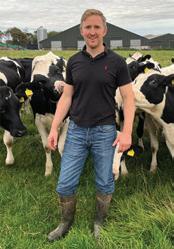

the crops grown include winter wheat, winter oilseed rape, winter barley, spring barley, spring beans and spring oats.
Extending over 240ha, Cally Mains Farm, in Gatehouse of Fleet, is a family business run by Allan, Janice and Robin Campbell and together they milk 500 cows, bringing on 350 plus youngstock. All cattle, a mix of Holstein and some Jerseys, are housed indoors and milked three times a day, by a team of four full-time members of staff and three part-time milkers.
This autumn, the Campbell’s will complete building a new fresh cow shed for 145 cows with an emphasis on cow comfort. They have a strict health policy in place, with a focus on maintaining a healthy environment for cows, youngstock and calves and work closely with vets to minimise antibiotic usage. The Campbell’s run a closed herd, with a weekly veterinary visit to monitor herd fertility and monthly health monitoring by their nutritionist.
Four years ago, they installed six Lely A5 robots which has led to significant improvements in milk production and overall cattle health. Their milking business is complemented by an elite genetics programme, with a focus on producing high yielding, efficient cows, who have a reduced carbon footprint. They have been using High PLI sires with the emphasis on producing progeny suited to robotic milking and with a longer lifespan.
Willie and his family are big supporters of RHET, hosting regular school visits and Willie is an active champion of the dairy sector, making videos for his social media, to educate and entertain the public about dairy.
Colin Laird, Blyth FarmsColin McGregor of McGregor Farms in Berwickshire took on the daily running of the family business in 1989 at the age of 21 when the farmed area was 300ha and specialised in pre-packed potato production. Over the past 23 years his business has been approached to contract farm nearby neighbouring land and there are now 15 agreements covering a managed area of 3,445ha.
Through improving organic matter and workability of the soil, over the past seven years Neil has increased his direct drilling rate to 90% and has recently bought a tracked combine to assist him in looking after his soils from harvest onwards. Introducing cover crops and clover leys have been two recent cropping changes on-farm and since 2014, Neil has been using drones as part of his management to allow for crop checking, drainage maps and establishment checks to be carried out.
Neil is passionate about spreading positive messages about the role productive farming has to play in conserving Scotland’s countryside and regularly extends invitations to industry stakeholders to come on to farm and writes a regular column for the Direct Driller magazine.
Peeblesshire-based Colin Laird runs Blythbridge Holsteins in partnership with his family, milking 540 cows daily, using 10 Lely A5 robots. The business has been built up over the past three generations and more recently saw the completion of a new dairy complex, constructed with the aim of maximising the potential of the Holstein breed.

The herd participates in weekly vet inspections to monitor fertility, and regular foot trimming, along with foot washers on the robots, has eliminated the need for antibiotics to treat lameness. This May, Blyth Farm opened its gates to the public and welcomed over 750 farming and non-farming visitors to explore the new dairy facility and to see other aspects of the farm. The family are also supporters of RHET, hosting school visits on the farm and regularly welcome international groups.
The arable operation predominantly grows winter wheat and oilseed rape, but winter barley, spring barley, spring oats, spring beans, potatoes and vining peas are also grown. Every farm has an individual rotation to suit its soil type, infrastructure and location, with Colin and his team focusing on building fertility and soil health to maximise yield and reduce risk.
The business is a LEAF Farm and all farms they are involved with are participants of environmental schemes. Precision Farming Technology is used extensively and there is regular soil sampling including organic matter testing and organic manures are utilised where possible.
Castleton Farm in North Berwick, run by Stuart McNicol, extends over 170ha, Castleton grows winter wheat, spring barley, spring beans and potatoes, with a recent addition to the operation of top fruit. Stuart and his family planted 1950 fruit trees this year, with plans to integrate the trees into the farm overtime for wholesale, juicing and cider.
Improving soil and future crop health is a top priority, prompting the introduction of cover crops as part of their rotation. This has allowed them to reintroduce sheep back into the operation to increase organic matter in the soil.
Berwickshire-based farmer Neil White of Greenknowe Farm runs an arable operation over 237ha and

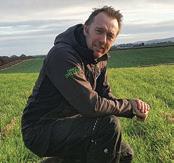

Engaging with the public is a key focus at Castleton and back in 2018, Stuart and his wife Jo opened coastal café, Drift – an

upcycled shipping container which welcomes 380k visitors a year. Together they have big plans to increase public engagement onfarm including hosting biodiversity tours to showcase farming’s relationship with nature.
at Mains of Murthly, Aberfeldy, which extends to over 244ha of Perthshire landscape, is about minimising input and maximising output by creating a more efficient system. Shepherd Ed Munt runs 1350 breeding ewes, 400 home bred ewe lambs and 25 tups, 12 of which are Innovis Aberfield and 13 terminals of either NZ Suffolk or Aberblacks.
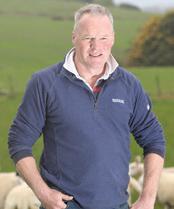
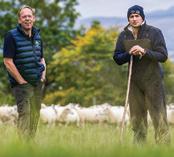
The whole system has changed over the past five years to become a predominantly grass based setup centred around rotational grazing, with divisional solar electric fence systems and Opico sward lifter improving the quality and volume of grass.
in the Scottish Borders, owned by Sir Michael Strang Steel and managed by Alan Cowens. It runs 2200 mainly North Country Cheviot ewes split into two flocks, shepherded by Alan Wilson and Scott Bell, and 120 Luing and Sim/ Luing cows.
Sisters Aimee and Kirsty Budge of Bigton Farm in Shetland, together run a mixed sheep and beef enterprise, alongside growing 60 acres of spring barley. They look after a 650-head flock which comprises of 300 Shetland cross Cheviot ewes which they put to a Suffolk ram to provide lambs for store and the fat market, and 350 pure Shetland ewes, which are put to either a Shetland or Cheviot ram and their offspring are kept for replacements.

The Budge’s have been working closely with their vet to develop a better health planning system for the farm and have a strict buying policy to complement Shetland’s high health status, with all incoming stock tested for CLA, dosed and dipped. No breeding females are purchased outside of Shetland and by being more selective in their replacements has allowed them to cull hard on less desirable traits, such as bad feet.
All ewes are condition scored every six weeks to both correct any problems, and to ensure all stock are improving and performing. When it comes to health, prevention is better than cure.
All lambs have traditionally been sold prime to the abattoir with the average weight being mid 19 kgs with normally U3L grade.
To grant ewes more grass in the ‘Golden period’, half of this year’s lambs will be sold store, with the remainder fattened on home turf. With the increase in costs of both energy and inputs, Mains of Murthly is looking at the best return for both staff and the farm. Reducing the winter costs is the aim of the farm.
Using a stick reader and electronic weighing crate allows them to record daily live weight gain and has enabled them to sell prime lambs at their optimum to allow for a much better return.
1000 hill type ewes are bred pure for replacements, sale ewe lambs, and wethers finished off forage crops. 500 hill type are crossed with the Blue Faced Leicester for the production of Cheviot Mule ewe lambs for replacements and sale. Wethers are finished on forage crops. These ewes are run as low input receiving no hard feed or silage over the winter and only receive feed blocks in the run up to lambing.
These ewes are all lambed outside in mid-April with the emphasis on a low-cost system. The NCC is the chosen breed for its hardiness, mothering abilities and quality of lamb they produce which sell at a premium. The flock is closed except the purchase of an odd stock tup.
The cattle complement the crop enterprise and keep the farm on a healthy rotation. And with a focus on sustainability, the family have constructed a new outdoor silage pit to cut down on plastic use and increase indoor capacity for bedding pens. Carbon audits, soil analytics and GPS technology have also been key to assessing the wider impact of the farm enterprise.
One of the steps the farm has taken to improve the system was by introducing the Ritchie Weigh Monitor, with cattle being weighed daily. Underperformers are quickly identified and removed from the herd, saving money on feed, and allowing only the highest quality animal to enter the food chain. Traceability is key, with digital software accelerating the monitoring process and translating as increased efficiencies. And, collaborating with their farm nutritionist and vet on a regular basis, Harry ensures that his animals are always in peak condition.
David and Ian Richardson, Upper Samieston FarmHarry Brown of Auchmaliddie Mains, Aberdeenshire, runs a herd of 200 predominantly Limousincross sucker cows and buys in 200 store cattle per annum to finish, fattening all animals on the 750acre farm, with an additional 200 acres of seasonal lets. Of the 400 cattle finished per year, around 30 home bred heifers are sold direct to the customer via farmers’ markets or doorstep deliveries, as Harry and his family work to foster local relationships, and share their story of how the meat is produced.
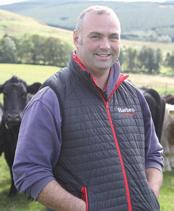

Father and son team, David and Ian Richardson of Upper Samieston Farm in Jedburgh, run a mixed beef and sheep enterprise comprising of 500 Texel cross ewes and 500 suckler cows, with calves sold as stores.
They run a tight 10-week calving block in the spring to ensure level batches for the store ring and this year calved 300 cows in the first four weeks. They run a relatively closed herd, breeding their own replacement females and some bulls, but the majority of calves are sold at six to seven months.
Alan Cowens – Philiphaugh Farm Philiphaugh Farm is a 2450 acre upland farm near SelkirkAimee and Kirsty Budge , Bigton Farm
Calum McDiarmid, Mains of MurthlyThe philosophy of Calum McDiarmid’s sheep enterprise
They have been selling stores at the top of the market with last year’s calves averaging £915 for bullocks and £880 for heifers. In order to optimise growing rates, mineral analysis is carried out on silage and summer grazing to help create a bespoke mineral management plan.
Improving animal welfare is key and the farm is part of the SAC Premium Cattle Health Scheme. All calves are pneumonia tested and plans are in place to remove the straw blower this winter in an attempt to cut down on respiratory problems.
James Young, Girvan Mains FarmYoung farms at Girvan Mains, with a 450-strong herd of beef cows and an additional 2000 –2500 stores. Angus, Saler and Limousin cows are run by Charolais bulls, with Angus and Salers put on heifers and first calvers. The system focuses on productivity, getting top quality beef-bred calves to finished weight as quickly as possible.
Investing in an anaerobic digester in 2016, and a ground source heat pump in 2019 for drying crop, primarily grass, which is then used in the enterprise’s TMR, further investing in a weight head and hydraulic cattle crushes has made it simpler and safer to work with larger numbers, as well as making it easy for the data collection, with poor performers identified and culled out. This has made his operation more efficient smf has allowed James to increase his finishing capacity by up to 400.
To maximise herd health, James works very closely with his veterinary team, and has

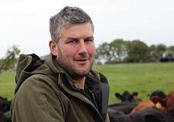
developed a vaccine specifically for his holdings as a way to reduce losses. Nutrition is central to the rearing process, but James maintains that correctly breeding animals in the first instance makes it easier to meet final market specifications.
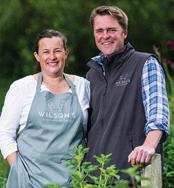
Robert Wilson, a key component of their vision is knowledge sharing and education. Established as an alternative route to market for some of their homegrown produce, the couple and their team now host farm tours and food experiences that revolve around seasonal ingredients from their farm, garden, and other trusted local producers. Whether it’s the 25 Mile Roast, Curry Nights or a private event with chosen menu, all can be enjoyed in the renovated Old Stable or quirky ‘Wee Tin Bothies’, which are upcycled grain silos.
Wilson’s Farm and Kitchen in the Scottish Borders exemplifies the story of the countryside, from field to fork. Run by Lucy and
With guests increasingly seeking out sustainable and local food choices, Lucy and Robert provide them with delicious dishes and an understanding about the provenance of the menu’s ingredients, which they feel will be key to the future of farming on a wider scale. Alongside Wilson’s Farm and Kitchen this tenanted family
South Ayrshire-based Jamesfarm has an arable enterprise and herd of pedigree Hereford cattle.
generations of the Neilson family; milking 450 cows through eight Lely robots, in East Kilbride.
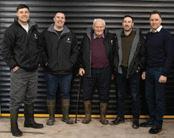
The family set up a new company called ‘What’s Fresh’ during the pandemic, to deliver fresh goods from independent producers to local customers. What’s Fresh continued to expand its offering and has recently invested in a new purpose-built milk bottling facility. The aim of What’s Fresh is to bottle their own quality, fresh milk and deliver to families and businesses.
organised by Watson Seeds, the hotly contested AgriScot silage competition welcomes samples from Beef and Dairy Clamps, Big Bale, and Young Farmer category, which can be submitted from any cut of silage.
Entries will then be whittled down to three finalists within each class, with the winners being announced during AgriScot, following a live forage analysis.
Ardross Farm is a tenanted mixed farm extending over 360 acres of beautiful coastal land in Fife. Contract farming an additional 800 acres and taking grass lets of 400 acres, the Pollock family rear Pasture for Life certified cattle and sheep, selling lamb, mutton and beef, as well as homegrown vegetables and honey, direct to the customer via their farm shop. They also sell wheat, barely, beans and oilseed rape on a commercial basis.
Set up in 2005, Ardross Farm has become a destination for locals, visitors and holiday makers alike, seeking quality homegrown produce. The connection between farm and consumer has been the keystone throughout the business’s growth, which now employs 18 locals, and customer feedback and insight continue to be at the heart of all decisions.
Committed to telling the positive stories of farming, Ardross Farm has a very active digital presence, working to promote the biodiversity, sustainability and traceability values of their enterprise, as well as agriculture in Scotland, via social media, e-newsletters and a brand-new website.
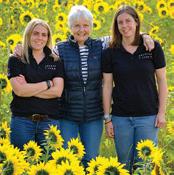
The new milk deliveries boast ultra-low food miles and reusable one litre glass bottles to cut down on single-use plastics and reduce emissions.
In addition to sustainability, customers are demanding more in terms of the provenance and traceability of their food. What’s Fresh can be transparent about where their milk is coming from and how it is processed, given that it only travels a few metres from the farm to the new dairy.
The AgriScot Business Skill final will take place at the event, supporting aspiring young professionals by providing them with the skills and networking opportunities required to mitigate and manage the many challenges facing rural and agricultural businesses.
The competition, which assesses individuals’ general business skills and awareness of agri-business issues, comes with a £1000 cash prize to help the successful candidate in the future. Open to those between the age of 18 and 25 years, this year applicants will explore “The importance of Agri-business managers developing more resilient businesses” with the winner announced at the event.
The Silage competition is a firm favourite with AgriScot delegates, gathering to hear expert commentary from the judging panel. Hugh McClymont will be entertaining crowds as ever this year, with his specialist commentary and nose for quality forage and will be joined for the first time by RHASS chairman and agronomist, Jim Warnock.
Mr Warnock said: “There has never been a more crucial time to secure high quality forage as it is the cheapest feed you will secure for your animals during the winter months. So much good grassland is lost by high infestation by aggressive weeds, as farmers tend to prioritise other land first. More time and effort must go towards the renewal of grass swards, but fundamental to that is soil analysis. By understanding and improving your soil PH, you will get a much better sward, and this will translate into better value on fertiliser spend and higher quality silage.”
The beef demonstration returns to AgriScot this November with its popular interactive format and this year will focus on efficiency and how famers can look to keep input costs in check throughout the winter.
The demonstration is sponsored by Quality Meat Scotland and organised by SAC Consulting and this year has partnered up with the Aberdeen Angus Society. There will be four Aberdeen Angus cattle brought into the ring of different weights and sizes, and the crowd will have the opportunity to use their buzzers to answer questions and give feedback. The cattle have been prepared by students at Oatridge College, as part of their training.
Gavin Hill explains more about the beef demonstration: “We know farmers will be interested in reducing costs through the winter because of the high inputs they are having to grapple with at the moment and we want to make sure cows being carried over the winter are being fed efficiently and discussions will ensue around cow size, cow condition, ideal feed and amounts of feed. As well as addressing cow efficiency, there will be a focus on emissions as these two things are linked.
“The real draw of the event is that we want it to be interactive,” he continued. “The cattle are marked A to D and the audience have access to button controls and they will be able to share feedback and vote based on questions shared on the screen. This has always proved a successful feature and in past years we have covered topics such as heifers calving at two versus three, and other years we have looked at different carcasses and the crowds have had to mark different parts of the cattle.”
Park Farm is a modern dairy operation run by three
With most farmers facing tighter profit margins against the backdrop of spiralling energy, feed, fuel and fertiliser prices, producing high quality forage will prove key to keeping feed costs down. Sponsored and
Kicking off at 11.30am in the main ring, it will once again be led by Gavin Hill of SAC Consulting, who will be joined by his colleague Leslie Wylie and Robert Gilchrist of the Aberdeen Angus Cattle Society. Together, they will be addressing issues such as calf efficiency, cow condition, feed intake and emissions reductions, to drive down the carbon side of the business.
With over £25,000 available in prize funds, the highest value of any event in the country, the Dairy Cattle Classes draw herds from across the UK and Ireland.
In addition to the traditional Ayrshire, Red and Whites, Holstein and Jersey categories, the dairy cattle show programme will also feature an ‘Any Other Dairy Breeds’ class, welcoming exhibitors of in-milk heifers and cows from the likes of Brown Swiss, British Friesian and Dairy Shorthorn varieties.
Judging of the dairy classes will culminate with the Super Heifer and Super Cow awards, each coming with a £1000 prize pot for the winning cattle.
Responsible for this year’s judging is Niels Erik Haahr, one of one of the top Holstein breeders in Denmark and running a herd of 600 cows. Mr Haahr also works with cattle across Europe, investing in highquality genetics from across the world.
Facebook - https://www. facebook.com/AgriScot/ Twitter - https://twitter.com/ agriscot LinkedIn - https://www.linkedin. com/agriscot
But we should not be complacent. With climate change here to stay, we must be prepared for the more normal wet and difficult conditions that Scottish farmers have to deal with.
Now is the time to look at your post-harvest grain-drying and storage capabilities to ensure that harvest 2023 runs smoothly with no expensive downtime cutting into your profit.
running at such high levels driving the increasing need to ‘tighten your belt’.
Now, more than ever, it is key that when making these hard decisions around upgrading or purchasing new grain handling equipment, they are the right decisions.
Harvest 2022 was generally good, even in Scotland, the prolonged dry weather enabled some farmers to finish in record time.
Do you need to upgrade your grain handling equipment? Should you be looking at replacing your ageing drier? Do you need additional storage capability?

All are hard and potentially expensive decisions to make, especially with ag inflation
Be sure that you take advantage of the expert advice available from suppliers, such as BDC Systems Ltd and its approved dealers.

BDC Systems has an extensive range of grain drying, handling, conveying, cleaning, storage, aeration and mill mix solutions from leading manufactures including, Aagaard, BM Silo, Gibbons Engineering, JKF,
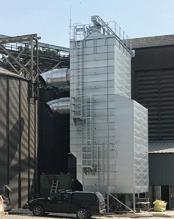
Kongskilde, Skandia Elevator, Soby, Svegma, and Zanin.
“Our ability to offer postharvest solutions from a range of leading manufacturers means, that unlike our perceived competitors, we are not limited to offering equipment from a single manufacturer,” explains John Wilson, BDC Systems’ Area Manager, Scotland and Northern England. “We can select the right equipment from the right manufacturer to deliver cost effective grain handling solutions that exactly meet the needs of our customers.”
By visiting the BDC Systems’ stand in the Lowland Hall at AgriScot, looking at its solutions on show, and taking advice from John Wilson and the BDC team you can be confident that you are making the right grain handling decisions.
For more info visit: https:// bdcsystems.com/
us Gold in the Royal Highland Technical Innovation Award.
The chutes are built with the safety of the user and comfort of the cow at the forefront of design. Hydraulic lift system brings the whole chute to your working height, with hydraulic leg winches, belly harnesses and head gate. The double belly harness system holds the cow securely without pushing the cow against the front head gate. B D Supplies also sell their own brand hoof block adhesive available as 178ml and 200ml tubes, this works with both wooden and rubber hoof blocks.
We also offer a comprehensive range of animal husbandry equipment including the Medi-Dart extension syringe for injecting cattle in the field.
Products are all available on our web shop or can be ordered over the phone.
We are always looking at bringing new products to the UK market and promoting products which we feel have a benefit in the UK farming industry.
We pride ourselves on customer service and to us ‘the customer does come first’.

has doubled its stand area at this year’s show, so enabling it to better exhibit its complete range of single, twin and triple auger diet feeders.
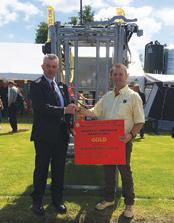
No two farms are the same, therefore it’s important that a wide range of specifications and options are available, so that BvL’s UK dealers and specialists can look at your needs and tailor a machine to meet those requirements.

Our unique strain of live, micro-encapsulated yeast has full EU approval across the species and is specially formulated for top dressing or TMR inclusion and is designed to help to maximise home produced forages and therefore increase feed intake and improve feed conversion, resulting in better liveweight gains, milk yields, carcass grades and quality.
Complementing this is a range of microbiological products to improve forage fermentation, handle the challenges of mycotoxins in feed and manage slurry.
The BvL V-MIX range of trailed diet feeders covers a wide range of machines, available in single, twin and triple augers variants and in capacity from 3.5m3 up to 46m3. At the heart of all BvL mixers are powerful mixing augers, with Hardox leading edges and adjustable knives. Twin and triple auger versions incorporate mixing wedges for a thorough and consistent mix, while the patented EDS (Exact Dosing System) discharge ensures an even forage discharge.
BD Supplies are a leading supplier in the UK of Animal husbandry and Cattle Hoof Trimming Equipment.
We can supply anything hoof trimming from a basic knife right through to the KVK hoof trimming chutes which won
With expansion into a thriving Biomass Wood Pellet delivery business, becoming fully BSL and Hetas registered and offering both bagged and bulk deliveries into the domestic and commercial market. With the investment into three lorries specifically designed to deliver bulk pellets in their optimum form has definitely been worthwhile for our expanding company.
We took the wood pellets on with the same ethos as the agricultural side of the businessQuality products which we believe in and trust rather than just price.
Completing our range is the highly popular Platinum range of mineral drenches which have seen faster finishing and significant improvements in health and fertility in both pedigree and commercial herds and flocks. For more information, contact Alec on 07718 905625
In a show of faith in AgriScot, diet feeder manufacturer BvL
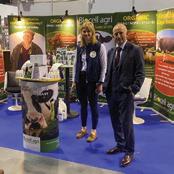
Available as an option and suitable for retro fitting onto older BvL diet feeders is the V-Connect mixer control. Using the control, the operator can easily monitor both auger speed and total revolutions, in addition to displaying and controlling mixer time. So instead of relying on PTO speed, by being able to monitor the actual auger speed the operator is able to achieve improved repeatability and ration consistency.
Other options include features such as doors on both the left and right hand side of the feeder for feeding flexibility and even simultaneous discharge to both sides. Additional discharge door options are available, as are discharge conveyors or elevators and new, highly powerful magnets to avoid metallic objects contaminating the ration.
Unique to BvL is the availability of special coatings
Biocell Agri are The Yeast Specialists.and hardened components for use with compact rations, or for more abrasive, higher dry matter rations, making this option particularly suited for beef cattle rations and large dairy herds. For further information, please contact Paul McUrich, BvL’s specialist for Scotland and northern England on 07810 040100 / paulmcurich@gmail.
com
market, DALBO UK’s market share has grown year on year. The most popular product sold in the UK by DALBO is the 12.3m Power Roll, closely followed by the 6.3 and 8.3m Maxiroll. The Maxiroll is commonly known as a ‘system’ roll as many attachments can be mounted to this frame enabling the machine to suit multiple applications. The most popular attachments are the hydraulically adjustable cracker boards and seeder units. One massive advantage of the Maxiroll is that the brackets necessary to take an attachment are always included in the ‘base’ machine, so it’s simple to add on an attachment.
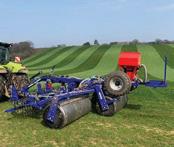
enabling it to be more than ‘just’ a roller.
DALBO has always been an innovative company as time after time it has launched market changing products. DALBO takes great pride in being at the forefront of technology and the introduction the snowflake Cambridge ring was a typical example of this. Offering the world market a 6 year guarantee on a Cambridge ring was unprecedented but the new snowflake design hasn’t disappointed.
We look forward to welcoming you onto our stand at Agriscot.

DALBO - where originality matters
dirty water and slurry spreading solutions; to spread slurry/waste/ dirty water from
Our range of dribble bars start at 6m and go up to 14m with single macerator on tanker models but with twin macerators on umbilical machines from 9m up to 15m. We can make a range of dribble bars that can mount onto a tanker but also can be removed and used as an umbilical machine.
Trailing shoes start at 6m up to 12m tanker mounted or umbilical mounted. Shallow injectors start from 3m up to 6m.
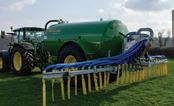
At DALBO we’re delighted to be back at AgriScot, Since DALBO UK was formed in 2010 the growth has been staggering. It’s very pleasing that, in such a competitive
A machine which we have seen great growth in over the last 18 months is our DALBO Greenline. The Greenline is fitted with ballast drums and comes in 6.3m & 8.3m. The ballast drums have a curved edge to prevent scuffing at the headlands, and like the Maxiroll can be fitted with attachments and seeder units
A new range introduced by Greencrop are Nurse tanks with a capacity from 30m3 up to 140m3. These are all built to customers specifications.
We can offer a range of other umbilical kit including, pumps, layflat reelers, splash plates, flow meters and monitoring systems, Oroflex hose. And a full range of dirty water spreading equipment.
Honda’s UTV Pioneer 520 combines the benefits of side by sides and ATVs, marrying up safety and space found in sideby-sides with the nimble handling and a small, narrow footprint.

In 2015 Honda America launched the Pioneer 500, promising a true all-rounder that was as versatile as it was compact. A powerful workhorse, engineers behind the two-seater designed it to stand-up to tough off-roading and a wide variety of testing work environments where Honda’s legendary reputation for durability, quality, and reliability is demanded.
The key to the Pioneer’s enduring flexibility and allround ability has always been its layout. The 520 takes this to the next level with the introduction of a gas-assisted tilting rear bed. Measuring in at useful 29 inches in length, 38.7 inches in width and 9.8 inches high, the ample dimensions can swallow a multitude of items from multiple standard hay bales to buckets, crates and more. The ridged base design, three bed divider slots for ¾” partitions and five D-ring locations ensure the load stays secure regardless of the terrain.
Aiding this load carrying versatility is a tailgate that folds flush with the bed floor when open and integrates four cupholders, giving the operator somewhere to sit on a work break, or at the end of a hard days work.
Such useability has not come at the expense of durability, with the bed designed to carry loads of up to 204kg. The one-piece
plastic item is hard wearing and features integrated taillights for a more modern look. The monocoque shape and design of the rear bed weighs less than traditional steel items, aiding the 520’s handling for those seeking recreational fun.
This highly capable load lugging capacity is boosted further through an ample towing capacity. Capable of towing 454kg, the Pioneer 520’s overall load capacity of 658kg makes it a very useful tool for agricultural and commercial applications.
mowers, tedders and rakes will be on show at AgriScot and product specialist Rhodri Jenkins says:
“Forage efficiency and quality is paramount to any livestock farm. Reducing impurities, increasing nutritional value, and speeding up the process of forage production is all part of KUHN’s Go Further with Your Forage campaign.”

Key to improving forage is the range of balers and baler/wrapper combinations that KUHN offers. In particular, the FBP 3135 with film binding stands out for the speed and precision it offers contractors and larger farms.
KUHN Farm Machinery has developed green harvest machinery to improve forage quality. The range of balers,

The KUHN system uses two standard 750mm stretch film rolls to fully encapsulate the bale. “As well as improving silage preservation and making the recycling of waste plastic easier, this system also reduces plastic usage by up to 30% by pre-stretching the wrapping film by 70% prior to application. Film loading is also quicker and easier as each roll weighs just 27kg, compared to the wider rolls which
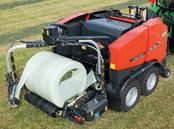
can weigh between 40-90 kg,” says Mr Jenkins.
The upgraded FBP 3135 twin satellite machine also uses KUHN’s IntelliWrap system with 3D wrapping, which wraps around the cylindrical surface of the bale first to exclude more air. This improves forage preservation and maintains bale shape for longer.
“The FBP 3135 BalePack can also be used with conventional net binding: switching between film and net binding is quick and simple as the two systems are separate, making it easy to switch from one system to the other for different crops,” he adds.
and VariPack Plus, offer variable bale chambers from 0.8m bales to 1.9m bales. The VariPack bale chamber uses three endless belts to ensure machine reliance from belt slips, and consistently well shaped, uniform bales.
Featuring a 25% wider crop flow and upgrades to the hydraulic system and the cab to match that of the KRONE BiG X wide body Forage Harvesters, the BiG X 530 meets the operators demands for performance and output.
The BiG X 530 features tried and tested KRONE technology such as the VariStream system to ensure consistently smooth crop flows and the MaxFlow chopping drum specifically designed to condition high-quality silage.
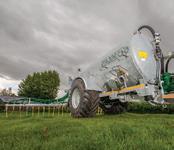
KRONE machines on display at AgriScot: EasyWrapper 150, VariPack Round Baler, BiG X 530 Forage Harvester, MX Forage Wagon, plus a selection of EasyCut Mowers, Vendro Tedders and Swadro Rakes.

We’re excited to present to you the world’s fastest singlearm wrapper, the EasyWrap 150. This mounted wrapper ensures operator comfort with automated functions for easy bale control and simple changes from transport to working positions. The EasyWrap 150 ensures effective bale rotation thanks to its two massive rollers, and is comfortable in wrapping bales up to 1,600kg.
Our recently upgraded high capacity belt balers, the VariPack
Kverneland focusses on feed management at Agriscot

Feed management will be at the forefront of many livestock producers minds this year, and Kverneland feeding specialist Dan Crowe says every kilo of
forage needs to count, heading into winter
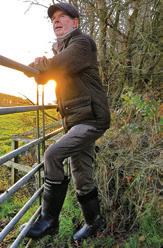
“We’ve taken a partnered approach to help our beef and dairy customers find the best solutions to improve their businesses, and to get the very best out of their investment in Kverneland machines,” he says. “That support extends from the smallest bale shredder to the largest self-propelled diet feeder.
An online touchscreen terminal will be available on the stand, linked to a 24 cubic metre 4.0 trailed feeder, to simulate office-based feed management and ration planning.

“Kverneland Siloking feeders can be equipped with Data-E feed management, which offers fast and efficient data transfer between the farm office and feed wagon, so that rations are fully utilised, and records are kept up to date,” he says.
Equipped with twin-lift conveyor and high capacity HD doors, the trailed 4.0 Siloking feeder is geared towards improving ration quality and ingredient uptake, putting precision into forage.
Precision is an increasingly important aspect of Kverneland’s latest twin-disc fertiliser spreaders too. Its GEOSPREAD system offers automatic section control across the full working width, and auto start-stop at headlands, to minimise overlaps.
The Exacta TL GEOSPREAD model can be supplied with an integrated hydraulic driveline, called intelligent Disc Control (iDC). Using a tractor’s Power
Beyond capability, iDC is able to deliver a more consistent disc speed, while delivering more fuel efficiency compared to a fixedspeed mechanical pto drive.
An 863 shredder-bedder, FRD 280 flail mower with hydraulic offset and the latest linkage-mounted 3232MT steeltined mower conditioner will also be on display.
Grass and slurry experts Major Equipment Ltd are returning to AgriScot 2022 with a selection of equipment from their extensive range of agricultural machinery. With products renowned for durability, reliability and easy operability, Major Equipment designs equipment with the owner in mind – machines strongly feature versatility and low running costs, deciding factors for farms and businesses looking to reduce maintenance bills and machine downtimes.
This is evident in the Cyclone Mower, an award winning rotary mower that bridges the gap between a traditional grass topper and flail mower. Designed to do the work of a flail, the Major Cyclone requires a 25% less power consumption than
 Join the KRONE UK team at this year’s AgriScot.
Join the KRONE UK team at this year’s AgriScot.
a typical flail, saving time and fuel costs for users. The heavy duty machine is increasingly the instrument of choice for clearing crop stubble, pasture topping, and land clearance in Scotland and around the world.
Major Equipment Ltd will also be showcasing a 2800LGP Slurry tanker complete with a 7.5m Dribble Bar. The MAJOR 7.5m Dribble Bar delivers slurry right where it’s needed. This low emissions slurry applicator has 30 outlets spaced 260mm apart for even and precise distribution of nutrients in long and short grass. The MAJOR dribble bar can be retrofitted onto any tanker make or model without fabrication.
Call to the Major stand at AgriScot to see the award-wining Cyclone Mowers and a selection of slurry tankers and slurry application systems. For more information call Major Equipment Ltd on 01524 850501 or visit www.major-equipment.com.

Mastek are based in Ireland and pride themselves on manufacturing high quality slurry application equipment. Mastek have two representatives in the UK and have dealers throughout the UK including a number of dealers in Scotland.
Mastek specialise in slurry tanker mounted low emission applicators, their most popular product being their professional

universal dribble bar (PUDB). The PUDB can be fitted to any make of tanker and features it’s own filling points, stone trap and sprung breakaway. The other big seller is the Micro Trailing Shoe which can be mounted to any tanker with suitable brackets. Mastek also sell a full lineup of Sepcom and Chior separation, pumping and mixing equipment. Separators can have multiple benefits from reducing storage capacity required, very little mixing required prior to spreading and no fibre left on the leaf of the growing plant.
McHale will be displaying a

wide range of machinery on our stand at this year’s AgriScot show taking place on November 16th. McHale will be showcasing their latest products by displaying the new McHale Fusion 4 range of integrated baler wrappers along with the new Pro Glide nonconditioner mower range.

In designing the Fusion 4, operator comfort and friendliness were at the forefront of the machine’s development. All machines in the Fusion 4 range deliver a number of new features with the higher end Fusion 4 Pro and Fusion 4 Plus being ISOBUS compatible allowing the operator to experience the highest level of customisation and machine performance.
The new Fusion 4 range introduces our most advanced pick-up featuring enhanced throughput, increased bale density and faster wrapping speeds. A focus has also been placed on operator comfort whilst still ensuring the reliability and

heavy-duty build quality that McHale is renowned for remains.
Following a direct request from the market, McHale’s design team have combined their specialist knowledge to develop this new range of non-conditioner mowers.
The McHale Pro Glide R310 is fitted with a 3m cutter bar to provide a cutting width of 3.1m using a 7-disc bed. The McHale Pro Glide R310 utilises proven technology from the conditioner mower range and benefits from a number of novel features which result in better ground following ability and quicker reaction times to changes in ground conditions.
The new R310 nonconditioner mower is equipped with a number of common features as standard such as unique patented ground following technology, adjustable ground pressure control and robust bed design which makes this mower a smart choice for farmers and contractors alike.
Merlo to Showcase FullyElectric Machine and New Multifarmer at Agriscot 2022
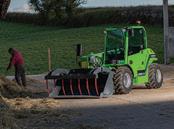
The all-new, fully electric eWorker is a completely fresh ground up design joining the existing comprehensive compact telescopic handler line up from Merlo. The development and launch of the eWorker through the last year have signified the commitment of the Merlo Group to sustainable, renewable energy. Green means more to Merlo than what we colour our machines.
On display at this year’s Agriscot show will be the eWorker 25.5-90 4WD model.
This compact unit packs a mighty punch with a 90kw electric motor, offering a maximum 2.5 ton lift capacity and a full lift height of 4.8 metres.
A maximum 8 hour run time ensures the eWorker can deliver throughout the working day before requiring a recharge. The 90 kw power unit offers terrific flexibility, great torque characteristics and power to spare for the most demanding of applications.
Zero emissions and silent operation will undoubtedly appeal to those working around livestock and in confined spaces, something which has not been possible before with diesel powered units.

Also on display will be the newly reimagined Multifarmer range. A telehandler with a rear PTO, the Multifarmer is the handiest tool in your arsenal. Equipped with an all-new Stage V engine, the Multifarmer is available with either a 7 or 9
metre reach on either a 3.4 or 4.4 tonne capacity. Rugged, hardy, versatile – the Multifarmer will make its Scottish static debut for Agriscot guests to view closeup, following a popular live demonstration at Tillage Live.
We look forward to welcoming you to the Merlo stand (145) in the Highland Hall at this year’s Agriscot on the 16th of November.
OPICO imports agricultural machinery to sell throughout a network of agricultural dealers. Founded over 50 years ago OPICO has introduced innovative machinery solutions

to UK farmers and contractors ever since and is the largest independent distributor of agricultural machinery in the UK.
The company is the UK importer for the following machinery brands: HE-VA, SKY, Strautmann, Maschio, Farm Droid and distributes grain dryers, mechanical weeding, grassland and arable equipment under its own OPICO brand.
At Agriscot 2022, OPICO will be located on block 190 and will have a Strautmann diet feeder and forage wagon, HE-VA and OPICO grassland machinery and Maschio flail mower and rotavator.
OPICO works with its suppliers to develop machines for UK conditions and is committed to support all machines throughout their working life. A full range of genuine wearing parts are also available from OPICO through their dealer network.
APECS Ltd. contacted Perry of Oakley about a new drier for their customer, Coppid Farming Enterprises Ltd. The Perry Savannah S414 continuous mixed flow grain drier was
selected drier as it is capable of 40tph, based on clean feed wheat at 750kg/m³, reducing moisture from 20% down to 15%. This model of grain drier is fitted with a pneumatically controlled shutter discharge, with phosphor bronze on all wearing parts. This ensures consistent movement of grain across the whole bed. The light grain & chaff recovery system was also purchased, which removes the need to clean out light grains and chaff from the drier exhaust plenum as its pneumatic flaps open periodically to allow this back into the drier column.
There are many heats sources available for the Perry model grain drier, such as kerosene, steam & biomass, but this drier was installed with LPG gas burners. Not only is LPG a cleaner fuel, it’s also easily controllable meaning high temperatures are consistently reached. This has been twinned with heavy duty furnace cowls
from 310 grade heat resistant stainless steel to suit the gas burner.
The grain column has a completely ledge-free design to reduce chaff & residue, with 3mm thick tapered air ducts for even air distribution and uniform drying across the grain column. APECS & Coppid Farming also opted to fit the Perry CentriKleens; a solution to dust and chaff problems. CentriKleens collect up to 95% of all visible dust & chaff.
The whole system, is controlled using a Perry 12” touch screen with a PLC program which is designed & programmed in house at Perry’s factory in Devon.
Perry grain driers come in a range of capacities and prices to fit all budgets. Enquire today about your next grain drier by contacting Perry of Oakley Ltd on +44(0)1404890300 or email sales@perryofoakley.co.uk

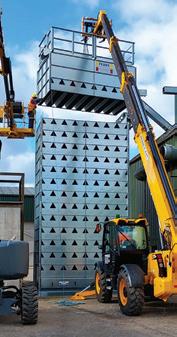
Pottinger have enjoyed much success when exhibiting at the AgriScot show and we look forward to its return. We welcome you to the stand where we will be displaying products from our grassland and arable range, these products include the new AMICO front tank and Rotocare crop care machine.
The AMICO front hopper offers the possibility to apply fertiliser, sow a cover crop, or do both at the same time. With capacities of 1,700 and 2,400 litres and a division of 60:40, a wide range of applications is guaranteed. The hopper is available with one or two metering units.
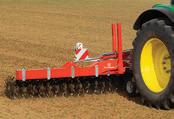
To ensure convenient operation, the AMICO front hopper is equipped with ISOBUS as standard. The material is applied using a single shoot process with a pressurised metering system. One or two metering units can be controlled site-specifically by the intelligent control system. Furthermore, the hopper can also be used with third-party equipment thanks to the ISOBUS control system.
The mechanical crop care machines complete our wide range of arable farming products. A key objective of mechanical crop care is to promote crop growth. To achieve this, competition from weeds and grasses must be kept to a minimum. By using our crop care machines, it is possible to avoid higher production and follow-up costs.
The new Rotocare rotary hoe conserves the crop and is rowindependent while delivering maximum output and low wear. In addition to its advantages for mechanical weed control, this machine is equipped for a wide range of other applications such as breaking up incrustations, incorporating fertiliser and aerating grassland. With working widths between 6.6 and 12.4 metres, driving speeds of 10 to 30 kph and low pulling power requirements,
the required tasks are completed promptly and cost-effectively.
Established in 1983, PWS are delighted to be back at Agriscot this year to showcase some of the equipment that we sell. It is always good to catch up with customers old and new and it gives us a chance to let everyone see what is new in our industry. We are the largest supplier of Power Washer’s in Scotland and with our team of service engineers we pride ourselves on providing a second to none backup service covering Scotland.
Power Washers come in many variations and we feel it is important to make sure that the customer gets the right machine for their job. We are happy to advise on what is required and to offer no obligation demonstrations on machines to ensure that the customer is happy before purchase. Over the last year we have been showcasing our range of electrically driven Power Washers and with the emphasis on getting away from using Fossil fuel these are proving very popular with many farms. However, the range of diesel / kerosene machines are still our most popular.
As well as Power Washers we also supply a range of heating and workshop equipment including – industrial, Space and cabinet heaters. We have a fantastic range of sweepers to cope with grain and potato sheds. Generators, Air Compressors and a full range of cleaning machines and detergents.

We are also happy to look after equipment that you may have that didn’t come from PWS.
Please pop on the stand and say hello and if you have any questions or enquiries the team will be delighted to speak to you.
V-Mac Silos will again be showcasing the latest development in the Bulk Storage sector. With spiralling animal feed costs its now more important than ever to ensure that you are protecting this increasing more valuable farm input.
With over 50 years’ experience in Silo manufacturing V-Mac Silos have a solution for every need. From storing 5 ton up to 100 ton, in a range of silo formats including their unique enclosed Silo design they really have all requirements covered.
This year they are delighted to be showcasing the very latest development in Silo monitoring, Lylogic’s SiloSpi. Developed by experts in the area of silo monitoring SiloSpi’s innovative design brings together perfectly the balance of accuracy and cost. The LvLogics, SiloSpi technology is being used successfully on a number of Irish livestock farms with V-Mac Silo installations on a range of different applications over the past 6 months.
Fergal Sherry, V-Mac Silo Sales Manager explains “we have been looking for a solution that uses smart technology to let a farmer know how much feed is in his silo for a long time.

Feed consumption can often be faster than expected and the meal bins can run out of stock. This puts severe pressure on feed compounders as they may have to schedule deliveries at short notice and often at weekends, thereby incurring extra costs and may find staff unavailable.
If feed supplies are interrupted, valuable animals will be under stress, performance will suffer and profitability on farm will be reduced. According to Fergal, a dairy farmer himself “It provides accuracy to within 3%, is cost efficient and allows the farmer to access valuable data on a range of devices using an easy to follow app.”

According to Barry Finnegan, CEO of Lvlogics, “Apart from showing farmers what’s in their feed silo, it can also monitor humidity, a key aspect in determining feed quality and helping protect your silo. It also removes the need for farmers to physically check the silo to see what’s in it, improving farm Safety.
Many new leys sown in August may be fit to graze now, but these newly sown swards require specific management practices to get the most from them.
There is a tendency to delay the initial grazing of these new leys, which leads to grass covers building up. Then, when animals graze them, there’s a high degree of sod pulling. This first grazing is important. New leys should be grazed as soon as the new roots are strong enough to withstand grazing. We can check for this by using our fingers to see if the root stays anchored in the ground when the plant is pulled.
Early grazing of these leys is important as it allows light into the base of the ley which will encourage tillering. A light grazing by calves, young stock or sheep is preferable. Bigger animals have more of a tendency to cause sod pull and poaching at this time of year. A first grazing can usually take place when the sward is at 6–8 cm’s in height.
Don’t be tempted to allow grass to build up on these new leys for a late cut of silage. This will inhibit tillering, resulting in more open swards which will be more susceptible to weed germination in the spring. Low winter covers will also benefit clover performance come spring.
If you haven’t soil tested before seeding, then it would be a good idea to do so before the spring. New leys are more productive and utilise nitrogen more efficiently but only if soil fertility is adequate. For more information please visit yara.co.uk/agronomy-advice/



 By Wendy Barrie
By Wendy Barrie
Scottish Thistle Award Regional Ambassador (2018/19) for Central, Tayside & Fife Director of Scottish Food Guide
Many years ago, when chief inspector for another national food guide, I was fortunate to visit a beautiful mansion, generally regarded as the oldest house on Arran, at that time run as a luxurious guesthouse. I shall always remember my first encounter with duck eggs, on their breakfast menu, Duck egg omelette, should the ladies oblige. Well they didn’t oblige that morning nonetheless
I had a five star breakfast and a fascination for ducks thereafter.
In days gone by, mixed farms reared ducks, hens and geese as part of the farming system, their foraging habits forming a natural cleansing of bugs and parasites, their egg production part of a healthy diet and income stream, and their meat perfect for a Sunday roast and the anticipation of leftovers to follow. Ducks’ favourite
food is snails so they are invaluable for rinsing gastropods from kitchen gardens and wet pastures. They can prevent vegetables becoming snail fodder and, as snails are host to liver fluke, ducks can eradicate the risk of liver fluke from pastures ensuring the land is safe for grazing animals. Their eggs have a stronger
flavour than hen eggs, their white noticeably more viscous and their richness perfect for savoury egg dishes.
My husband’s grandmother was a perfectionist in the kitchen: from butchering a whole hog for Christmas to baking bread and making cheese. I never met her
however she appeared quite an impressive matriarch and her kitchen table must have had tales to tell. In her world, it had to be duck eggs for cakes and pancakes and I must agree, once you’ve tried them you really notice the difference. They bring a certain luxury in depth of colour and flavour to any cake or omelette and the mere act of cracking through their heftier shell and plopping the generous contents into the mixing bowl give a promise of the treat awaiting you.
Nowadays it is quite a challenge to find free-range outdoor-reared poultry and many heritage breeds are endangered. Shetland still has its Shetland geese, ducks, Tappit and Papa Stour hens, all on Slow Food’s Ark of Taste, thanks to the devoted efforts of a couple of families on Shetland but they are few and far between. In the case of Shetland ducks, their ancestors would have been wild mallards and you can still see traces in the blue iridescence in their plumage. It is important to keep these rare breeds going; not only for their beauty and eating qualities but
also for their valuable genetics as these old breeds have far more resilience than many of the modern ones, often bred for one climate or one feed and much less adaptable when climate or the world economy changes our needs or affects supply chains.
Native and heritage ducks, as with other domesticated rare breeds, grow slowly and can flourish on food surplus, forage in nature and live on lower inputs, making them ideal for food production in these challenging times.
For us mainland inhabitants it is good to find your own local freerange source of ducks and support them. In our case, it’s a visit to Brand Family Farm, East Fortune.

Renowned for their Saddleback pigs, Hampshire Down sheep and free-range hen eggs, they are also one of a rare breed selling duck eggs from their mixed flock of Aylesbury, Khaki Campbell and Harlequin ducks, rambling around contentedly under the fruit trees.
From small beginnings when they returned from a sheep mart with an unplanned handful of ducks, they now have around sixty, living the good life in East Lothian.
Rearing ducks is generally less popular than rearing hens for egg production for although they provide a relatively steady supply, they are not as plentiful or consistent as hens. Thankfully this is not an issue for the Brand family as they have regular customers who adore their duck eggs and an award-winning Edinburgh chef who wouldn’t be without them and receives a regular order.
The glamorously white Aylesbury ducks may have originated down south but seem very happy by East Fortune and will lay throughout the winter months too. As the name suggests, the Khaki Campbell are a distinctive warm shade of tan, very good layers, more proficient foragers than the Aylesbury and dispatch any snails pronto. Like the other animals on their farm, they are heritage breeds and all Jane’s ducks are on the Rare Breeds Survival Trust Watchlist.
Ducks have been domesticated in the north since ancient times, long before hens, as they were easier to tame. Like geese they follow the first person they see when they are born. Us Scots have
a long tradition of eating duck eggs including waders, seagulls and eider ducks although some of these wild birds taste distinctly fishy from their diet of mussels and crabs. Not so the ducks at Brand Family Larder!
Their ducks are certainly very fond of Robert, one of Jane’s sons, who makes up their daily rations and kindly guided the flock as I tried to capture a good shot. Simpler to rear than geese who need water for mating and pasture for grazing, ducks are more accommodating; happy to have a splash in a paddling pool or natural pond and roam an orchard, copse or clearing, not requiring large fields. At dusk they all head indoors to a poly-tunnel, safe from predatory foxes.
Jane and her family have enlarged their farm shop considerably since my last visit, now with an additional farm building well-stocked with local rapeseed oils from Supernature, beeswax, jams and jellies, vegetables, the neighbouring farmer’s potatoes and of course their own eggs and meats. With two newly installed freezers, their free-range pork and lamb is available fresh or frozen. Jane is so enthusiastic she is even about to launch her first on-farm market, the East Fortune Market. Reinstating a little piece of history, Jane is inviting her suppliers to join her for a monthly market, from mid October onwards.
Before heading homewards, we bought her marvellous smoked Saddleback bacon to accompany our duck eggs for a scrumptious Sunday brunch. The remaining eggs were destined for a yellowy light sponge cake. When out and about in East Lothian why not stop by another pair of ducks, Malcolm and Fiona at Ducks Inn, Aberlady - the perfect way to round off your day with a delicious meal of local produce.
https://www.brandeastfortune. co.uk

https://www.ducks.co.uk
Wendy Barrie is a cook, campaigner for local sustainable food & food writer. Founder & Director of award-winning www.scottishfoodguide.scot & www.scottishcheesetrail.com. Wendy is Leader in Scotland for Slow Food Ark of Taste, a Cooks Alliance Member & Thistle Regional Ambassador. Her latest book, “Meadows: The Swedish Farmer & The Scottish Cook” co-written with her husband, Bosse Dahlgren, is available online & from selected farmshops.
2022 has proven a tough year for arable and livestock farmers. With higher costs, rising feed and fertiliser costs, dry weather, and labour shortages, we know that it’s been a challenge to commit to high volumes of packaging materials in recent months. So, to help overcome this we have been looking at how we can help the arable and livestock farming sector.
So, who are we?
NNZ have been supplying packaging to farming and agricultural industries for over 190 years, 5 years ago NNZ bought LBK packaging in Liverpool to further enhance our offer. As a BRCGS A grade supplier for storage and distribution into the food and feed channels, we are based locally but with the backing of a much larger international group, giving us the flexibility and network to really support you.

This means we have all the experience and knowledge to give you the exact packaging you need with helpful, efficient customer service and quick delivery.
At NNZ, we offer a wide range of products to make sure there is always something that will fit your needs, including printing your design onto bags.
Our paper sacks are supplied plain or printed; we can also print onto pp woven sacks for companies needing smaller print runs. We print these smaller runs in-house at our Liverpool site, to give companies opportunity to personalise their bags more flexibly.
available
We stock our most popular products, so they are available to order for smaller orders. For larger orders, call off orders can be made available subject to T&C’s. Sometimes this can mean next day delivery is an option if required when buying stocked items.
Some products you may be keen to explore with our team are below
• PP Woven and Paper sacks
• Feed bags and produce net bags

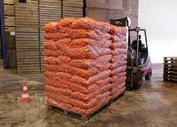



• Pallet netting
• Produce trays

• Net roll stock
Let us help ~RETHINK your packaging
With a growing consumer demand for purpose-driven products, companies, and organisations it is key to constantly revaluate your offer. So, with all the new options in our portfolio and as this year we are celebrating our 100year anniversary we have our #RETHINK – a free audit of all your packaging – to see how we can offer you more sustainable, impactful, dependable, and affordable packaging –protecting your produce whilst helping save our planet!
Plain or printed Wicketed netbag available with or without laminated mouth
Plain or printed polypropylene sacks, various sizes
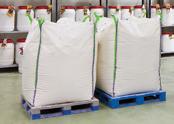
So why not give Craig or Gordon a call in our Glasgow office and see how we can help you with making the right choices for your business and our planet –let us help you #RETHINK your packaging!
Call us now: 0141 956 1992 Address: NNZ Innovation Centre Ainslie Road, Hillington Park Glasgow, G52 4RU Email: craig.farrell@lbkpackaging.co.uk, gordon.mcwilliam@lbkpackaging.co.uk
Author of five Sunday Times
Bestselling books and star of Channel 5’s highest rated factual series Our Yorkshire Farm, Amanda Owen is known to millions as The Yorkshire Shepherdess.

In Celebrating the Seasons, Amanda Owen shares funny and charming stories from across the farming year with her family and their many four-legged charges, from lambing in spring, to haymaking and shearing in summer and feeding the flock in midwinter. In this updated paperback edition, featuring additional material taking us up to February 2022, Amanda learns why pig-feeders are best left in situ, camps out overnight in a moorland sheep-fold and finds a new super-size friend for Tony the pony.
Part recipe book and part memoir, the paperback of Celebrating the Seasons includes 36 stunning photographs taken by Amanda showcasing the bleak and beautiful landscape she calls home, opening up a window into a life lived on one of the country’s highest, wildest moors - land so inaccessible that in places it can only be reached on foot.
About Amanda Owen
Amanda Owen grew up in Huddersfield, but was inspired by the James Herriot books to leave her town life behind and head to
the countryside. After a period of milking cows and working as a contract shepherdess and alpaca shearer, she eventually settled down in Swaledale, North Yorkshire, living and working in one of the highest and most remote places in England, where she has been for over 25 years.
Amanda now runs a two thousand acre hill farm in Swaledale in North Yorkshire, fifty miles from the nearest large town. She is a full time shepherdess tending a thousand sheep and nine children aged 5 to 21. Her life is dominated by the seasons, feeding, clipping, dipping, herding, rescuing and lambing her flock in one of the most remotely beautiful yet tough spots in the country.
Amanda is the mother of nine children, a passionate photographer and the author of the top ten bestsellers The Yorkshire Shepherdess, A Year in the Life of the Yorkshire Shepherdess, The Adventures of the Yorkshire Shepherdess, Tales from the Farm and Celebrating the Seasons, which was the biggest selling Hardback NonFiction title of 2022 and was shortlisted for Non-Fiction Lifestyle Book of the Year at the 2022 British Book Awards. She has also regularly appeared on TV in shows such as The Dales, Winter Walks, New Lives in the Wild, Springtime on the Farm and Our Yorkshire Farm.
Send an email to: mail@farmingscotlandmagazine.com telling us how many children Amanda has?
Remember to supply your name and contact number too!
Closing date is Friday 9th December. Good luck!
We have three signed books of Amanda Owens’ ‘The Yorkshire Shepherdess –Celebrating the seasons’ to be won!
Today Michael Arbuckle is a member of the NFU Scotland poultry working group and, in 2022, was a finalist for Producer of the Year at the National Egg & Poultry Awards, but this dedicated egg producer started his farming career at Lundie Castle Farm, Angus.


“My grandfather moved to Lundie Castle in 1945 from Fife, where the farm originally started. My father and uncle soon took on the farm and expanded it over the last few decades, specialising in fruit and veg, dairy and pigs. In 2004, I officially joined the farm, having completed my degree with honours from the Edinburgh Scottish Agricultural College. We own 600 acres here, with a further 350 acres contract farmed. Our farm is completely family-run.”
Michael and his family developed the land, with longevity being a key priority.
“I remember when I came back from university, dairy was the mainstay of the business,’ says Michael. ‘At the time the industry was struggling, and we needed to reinvest substantially to keep the enterprise going. The decision was taken to cease dairy production and we started a 200-strong beef breeding herd. I was continuously looking for Michael Arbuckle
another enterprise to replace the dairy gap in our business and free-range egg production seemed to fit perfectly. Working with hens and producing great quality eggs is far less labour intensive than our previous fruit business. Likewise, I wanted to avoid something that was overly reliant on good weather, fuel and fertiliser. I would like to think we run a more circular farming model, because we repurpose the manure from the poultry and cattle to help grow the crops we then use to feed the hens. Environmental stewardship is at the forefront of all decisions that I make now.”
Being a free-range producer adds another layer to Michael’s product, plus having a portfolio of income streams buffers the farm against the ebb and flow of seasons and markets.
“We proudly produce freerange eggs, which we supply to Noble Foods, alongside cereals such as oats, wheat, barley for malting and oil seed rape. We often house neighbouring farmers’ dairy calves in the winter too. There are five of us at Lundie Castle Farm. Three work with the hens, one looks after cereals and I help with everything I can.’
‘We’re pleased to be raising two breeds of hen. We have

32,000 Bovan Browns and 32,000 Lohmann LSL’s. The Bovans were selected for their egg size and excellent production. All egg producers might echo me when I say the Bovan is a fantastic bird to work with. Our flock of Lohmann LSL’s is also a stalwart breed. We were given the opportunity by Noble Foods to try the white hen, which produces white eggs, and have been extremely impressed with how they performed, even how they consume considerably less feed than a brown hen.
Although the price per egg is less for the white eggs, their phenomenal performance more than makes up for it, and we can’t stress enough how lovely they are to work with.”

Michael finds farming on the east coast of Scotland brings inherent advantages, but it’s not without its challenges.
“The Scottish climate is well suited to cereal and fruit production, with longer daylight hours compared to other parts of the UK and a cooler temperate, which means drought or water issues aren’t usually concerns. That’s something that I see being of greater value as our climate changes. We have great soil here on the east coast and good access links where we are based.’
‘Labour has certainly been one of the biggest challenges.
I’m no longer part of the fruit enterprise but we’ve found that labour for the fruit and veg industry has become extremely hard to come by. Likewise, it can be difficult to attract the right, skilled labour for poultry and cereal production. My focus is looking after my employees, it has never been more important. This present year is also going to be particularly challenging with ag inflation skyrocketing. All my eggs are on a feed tracker contract that has allowed the poultry business to remain profitable through these uncertain times, and the manure from the poultry is becoming ever more valuable as the price of artificial fertiliser has tripled, so that has helped keep the cereal production cost down.”
A key element of modern farming is embracing new technology where gains can be found and, in the current climate, reducing dependency on traditional power sources. Lindie Castle is investing in renewables as the next step.
“We already have 100KW of solar panels’, says Michael, ‘but I’m excited to start looking to potentially increase our reliance on green energy, with more panels or a small wind turbine for each 32,000-bird unit. These should further reduce
our need to bring in electricity from the grid. I’m a member of LEAF (Linking Environment and Farming), which means we leave a number of wild flower margins and, where possible, we link up habitats. This has tied in perfectly with the poultry enterprise, as planting more trees on our hen ranges is helping improve biodiversity levels on the farm. In the future, I also plan to take part in their Open Farm Sunday to help educate the wider public in what we are trying to achieve. I have also been involved in early discussions with Kipster in the Netherlands, regarding their novel barn units. It’s a fascinating concept with huge welfare and environmental benefits to help produce a more sustainable egg.”
Ultimately, Michael and his team are proud of their work and their product.
“Although we’re going through challenging times at an industry level,’ concludes Michael, ‘I’m ever confident that the tide will turn. Eggs are a fantastic source of affordable protein and nutrition, with a myriad of other health benefits. It is an extremely enjoyable and exciting industry to be part of, and I’m honestly very lucky to have such a dedicated team working with me.”
Janice Hopper is a freelance writer based in Aberdeen who’s written features, copy and social media text for a range of publications and clients. Her Scottish family travel blog, Scots2Travel.com, covers child-friendly short breaks, attractions and activities.
• Latest NFU Mutual claim statistics reveal rural thieves are now targeting farm pick-up trucks
• Farmers advised to fit security devices – even on vehicles over 10-years-old
• Cost of living crisis may be factor in rise in rural crime
Rural thieves are targeting farm pick-up trucks with more than twice as many of the farm workhorses being stolen each month than in 2021, warns NFU Mutual.
The leading rural insurer is alerting farmers to the new rural crime wave and advising them to fit additional security measures to their pick-ups – even on battered 10-year-old models.
Theft claims dealt with so far this year by NFU Mutual show that older Toyota Hilux and Mitsubishi L200 are the most regularly targeted pick-up models. The average age of L200s stolen so far in 2022 was 12 years, and 10 years for Hilux vehicles.
Thieves have also been targeting the upmarket VW Amarok while thefts of recent model Range Rovers have soared by over 50% a month compared with 2021.
Rural thieves are continuing to steal large numbers of Land Rover Defenders and their parts. NFU Mutual claim figures for the first nine months of 2022 show they
remain at the top of the chart for stolen 4 x 4 farm vehicles.
Bob Henderson, agricultural engineering specialist at NFU Mutual, said: “This is alarming news for the large number of farmers who use pick-up trucks as their workhorse vehicle to carry feed and tools around the farm and tow livestock trailers to market.
“For years thieves have targeted Defenders and older Land Rovers because of their high value and potential for resale as vehicles or parts. With prices of new and used replacement pick-ups rising fast thieves are now finding it worthwhile stealing pick-ups –even if they are over 10-years-old and battered from hard work on farms.”
DC Chris Piggott, who leads the agricultural vehicle theft unit at the National Vehicle Crime Intelligence Service (NaVCIS), said: “As well as being stolen for onward sale and financial gain, these vehicles are also being targeted by hare coursers with links to other forms of criminality.
“Many of these vehicles aren’t fitted with the immobilisers, trackers and alarms fitted to newer vehicles. Until now, this hasn’t been as much of a problem, but now that pick-ups are proving desirable to criminals, there’s an urgent need for farmers to improve security.
“It’s absolutely essential to ensure keys are always removed
and doors locked whenever you leave the vehicle. Keeping vehicles out of sight where possible and using mechanical devices like steering and pedal locks are also an effective deterrent for older models. Retrofitting alarms, immobilisers and tracking devices is also well worth considering.”
Bob Henderson added: “Sadly there’s little doubt that criminals will continue to target farms as the cost-of-living crisis bites hard this winter. A recent poll by NFU Mutual reveals that 89% of respondents believe rising inflation will lead to an increase in rural crime.
“Rural crime is about more than financial loss. Thefts of essential vehicles massively disrupt farm work and cause anxiety for families who are aware thieves are regularly checking over the place where they live and work. NFU Mutual is responding by helping those living and working in rural areas to prevent rural crime and by continuing to provide major support to enable dedicated police resources to tackle the issue.”
Last year NFU Mutual invested £430,000 in rural crime initiatives. This includes support for an agricultural vehicle theft unit at the National Vehicle Crime Intelligence Service (NaVCIS) which recovered stolen vehicles and farm machinery worth £2.6m last year. The unit delivers intelligence, training, and works
directly with police forces across the country to combat rural crime, in addition to joint international operations to seize stolen machinery from overseas.
NFU Mutual and NaVCIS farm pick-up security checklist:
• Remove keys when pick-ups are not in use and store them in a secure cabinet where possible
• Fit trackers and immobilisers to deter thieves and aid recovery of stolen pick-ups
• Consider using mechanical devices such as steering wheel and pedal locks to deter thieves
• Avoid leaving vehicles where they can be easily seen from near-by roads by criminals searching for theft opportunities

• Close and lock yard gates at night to deter drive-through thieves
• Check security lighting, alarms and cameras are working correctly and update if necessary
• Consider infrared beam alarms, CCTV and floodlighting to protect farmyards
• Join a local farm watch or rural watch group to keep updated about local rural crime trends and suspicious sightings
Detailed information on rural crime trends and advice on how to secure your property is available in NFU Mutual’s 2022 Rural Crime Report: www.nfumutual. co.uk/ruralcrime
The value of native beef genetics is rapidly growing, with breeds such as Aberdeen-Angus showing that they can tick the boxes at all tiers within the beef supply chain.
Better suited to grassbased, lower input systems than continental breeds, native genetics offer the potential to boost producer margins and support environmental goals, while delivering a consistently high-quality end product.
Robert Gilchrist, CEO at the Aberdeen-Angus Cattle Society, says as a result, the industry is seeing significant growth in their use.

“As subsidies drop off and input costs continue to rise, beef farmers have had to start looking at ways to enhance their resilience, which has resulted in a significant increase in native
breed BCMS registrations over the last 10 years.
“Aberdeen-Angus calf registrations have increased significantly and they’re now top of the list with 471,528 registrations in 2021. 4% growth has been seen in the last year, accounting for 24.41% of beef calves,” he says.

“More farmers are recognising that the lower input systems, where cattle can be predominantly finished off forage and grass-based diets, is a much more sustainable and financially viable way of producing beef, as the agricultural sector faces so much uncertainty.
“The nature of the reduced inputs required for an extensive beef system means they tend to have a lower cost of production and be more environmentally sustainable.”
Mr Gilchrist says the benefits extend much further than just farmers within the supply chain.
“From a consumer perspective, the intramuscular fat that native breeds offer provides the marbling which consumers desire, making it easier to cook. This gives a more consistent eating experience, which is fundamental in getting people to purchase beef on a regular basis,” he says.
Spiralling feed costs has recently highlighted major vulnerability within the meat supply chain, with pork and chicken heavily affected due to their reliance on concentrate feed. Mr Gilchrist believes that building a beef supply chain that focuses on producing meat from grass, is more resilient and sustainable.
“Beef is renowned for being a premium product and therefore
typically a more expensive option than white meat. However, if we can develop a more sustainable beef supply chain at all levels, then we will be better placed to compete with other proteins in the future,” adds Mr Gilchrist.
Legendary US rancher Lee Leachman has said Stabiliser cattle should become the standard suckler cow in the UK to help farmers measure up to the future challenges the industry is facing.
Mr Leachman is the CEO of Leachman Cattle of Colorado, one of the five largest seedstock
breeders in the US, and made the remarks this week while on a tour of farms in Scotland and Northern England.
He described Stabiliser as ‘the best kept secret in temperate regions’, adding that hybrid genetics suited the UK extremely well.
“Britain has particular requirements,” he said.
“Running cows on grass, over wintering them inside, feeding them low quality forage and still trying to produce shapely cattle. The best way to do that is by producing hybrid cows.
“Stabilisers thrive here. They produce well over a 95% calving rate so anything that does that must thrive.
“The shoe fits. Everyone breeds cows for different reasons, but if you’re looking at data and trying to make money, then hybrid genetics are the way forward. We don’t have many people stop using them once they start.”
Mr Leacham added that for the first time, society was demanding that cattle are productive, while at the same
time delivering for sustainability and the environment.
“Generally, cattle change slowly, but we are seeing rapid, managed change,” he said.
“Hybrid genetics are a game-changer and our breeders are continually moving to optimise production. This means moderately sized cows, better fertility, longevity, and better calves, which feed into everything, from lower carbon emissions to ease of care, eating quality and dollar profit.
“Hybrid production is normal in crop production, swine, and poultry. We’re using systems aligned with that in beef and I don’t think UK cattle farmers have any other source of feed efficiency tested, genomically evaluated composite genetics.”
Survey reveals beef and dairy producers rate animal health as number one care factor

British beef and dairy producers prioritise animal health as the number one care factor on their farms, ahead of milk and beef price, according to a new survey commissioned by feed supplier, KW Feeds.
While milk and beef prices came a close second, both beef and dairy producers also rate animal happiness as one of the most important care factors on their units.
Based on the average response from the total responses received, cow health was the most important factor for dairy farmers (18%), ahead of milk price (15%) and cow happiness at 14%. Beef producers scored similarly, with animal health at 20%, ahead of beef price and animal happiness, both at 16%.
“What this survey reveals, is that refreshingly our farmers are recognising the direct
correlation between a healthy, happy herd, and a profitable herd,” says KW Feeds ruminant technical manager Georgie Croxford.
The survey, commissioned to understand farmers attitudes to their herd, feeding and feed strategies, considering the
unprecedented price increases for feed and fertiliser during 2022, also reveals environmental considerations are becoming increasingly important.
The use of adaptive multipaddock grazing has seen an Oxfordshire farm maintain cattle growth rates without the need for supplementary feeding this summer.

FAI Farms farm manager, Silas Hedley-Lawrence, says adaptive multi-paddock (AMP) grazing, which is being trialled by FAI as part of a four-year project with McDonald’s UK and Ireland, has been invaluable during one of the hottest and driest summers on record.
He believes farmers interested in becoming more resilient to future weather extremes should consider AMP grazing - which involves ensuring there is no bare soil, leaving grass to grow longer, and grazing a high density of livestock in a defined area for a short period of time, followed by long rest periods.
“Some livestock farmers will graze grass right down to the ground before moving cattle on. For those that did that in May and early June of this year, everything
would have been grazed away and this was then followed by a period of no rain and subsequently, little to no grass growth,” says Mr Hedley-Lawrence.
“In comparison, the AMP grazing system aims to graze no more than 25% of what’s on offer during the spring, 50% in the summer and 75% in the winter, before moving cattle on,” he explains.
“This means that during the spring the pasture barely notices it’s been grazed and the annual grass growth curve is not negatively impacted right from the start of the growing season.
“For example, we had very little rain between June and September. But, because we leave a lot of grass behind, what’s left has carried on photosynthesising. The roots have also managed to access retained moisture in the top layers of the soil due to the insulating and cooling effect of the longer residual.”
As well as stimulating grass growth, this system of grazing enables farmers to trap more moisture when it does rain, adds Mr Hedley-Lawrence.
“In more standard grazing management systems, where pastures were left looking more like a golf course during the summer, rainfall would have been relatively ineffective, due to most of it evaporating off the bare and hot ground, or running off into watercourses due to the hard baked soil.”
He adds: “But in our fields because we’re leaving half of the grass behind, it’s a dense mat with deeper root structures. This means when we do get any moisture, we’ve been able to hold onto most of it as the residual stops evaporation, and maintains soil structure and temperature to aid with infiltration rates.”
The resilience of the AMP grazing system is also evident in cattle growth rates, says Mr Hedley-Lawrence.
From a Scottish farming perspective, the UK Government signed up to a one-sided post-Brexit trade deal with New Zealand that offered little gain for us but plenty for farmers there writes NFU Scotland Vice President Robin Traquair.


That made a meeting between NFU Scotland, Quality Meat Scotland and Beef & Lamb New Zealand (B&LNZ) on a Borders farm earlier this year an intriguing prospect.
The team included Andrew Morrison, Chair of B&LNZ who farms on the South Island with his wife Lisa and farms 1030 hectares of breeding and finishing units spread between Southland and Otago.
Upon being elected, Morrison is keen to advocate the strength of the global red meat sector in an everdemanding protein market alongside encouraging a competitive advantage in the production of natural grassfed hormone and antibiotic free sheep and beef.
The party also included staff members whose job it is to establish contacts to open
up trade for NZ beef and lamb in the UK and Europe. That is a job that will have one eye on the increased market access NZ will gain over time to the UK market.
As we approached Robert Neill’s Upper Nisbet farm in the Scottish Borders, the countryside was in full bloom and the crops and livestock were looking fantastic with the expectancy of good yields ahead.
As we got out the cars, Andrew Morrison looked upon the beautiful landscape with a wry smile and asked ‘why do you guys need subsidies?’.
That prompted a frank discussion on the differences in production systems between our two countries. Income support given to farmers in Scotland benefits not only the farmer, but the wider agri-food industry and countryside. Our current system is designed to be a socio-economic boost to the rural community, and this will carry on in our relentless lobbying of Westminster and Holyrood.
Following this, we visited Saughland Farm by
kind permission of Richard Callander. We were shown around by livestock manager, Owen Gray. With a flock of 1,500 Romney and Aberfield genetic ewes. Easy lambing and carcase quality are at the forefront of Gray’s team. New fencing had been installed to facilitate block grazing with laneways to ease handling.
The timing of this visit sat well given the UK Government’s increasing appetite for Global Free Trade Agreements.
Personally, I have no doubt that by the end of this tumultuous and historic (for all the wrong reasons) Parliament, we shall have many more Free Trade Agreements with the likes of Canada and India on the horizon.
We will be challenged by imports from the likes of New Zealand, but there are also opportunities to learn from our competitors where we can face them head on in the global market.
As Andrew Morrison said, ‘the red meat sector is stronger if we are able to work with others so effective collaboration is vital.’
Elanco Animal Health has launched Hemicell™ XT, a new nutrient-sparing enzyme, to its range for pig and poultry producers.
This gut-health enhancing supplement supports nutrient uptake and has the potential to reduce overall feed costs due to the improved utilisation of dietary energy.
Agustina Rodriguez, Elanco technical nutritionist consultant, explains that while there is a temptation to remove the number of ingredients in rations to save costs, it can be false economy in the long-term.
Most plant-based raw materials contain ß-mannans, undigestible fibres that monogastric livestock cannot

breakdown. When ß-mannans are found in a ration, energy that should be used for growth, is diverted towards a Feed-Induced Immune Response (FIIR), impairing bird performance potential.
Hemicell™ XT offers a solution and advanced formulation compared to existing market options. “The energy-sparing enzyme performs in the same way as Hemicell™ HT,” says Ms Rodriguez. “But it contains an upgraded carrier that is proven to further enhance diet quality.”
“This change to the formulation allows for improved flowability and mixing within a ration. It results in a larger, more uniform particle size, offering
greater uniformity and reduced dust during application.
Hemicell™ XT also has an enzyme concentration 2.25 times higher than the original Hemicell™ HT formulation. This accommodates a wide range of application methods, including within complete feeds, premix and speciality mixes.
“In the current climate, the use of Hemicell™ HT in premixed ration formulations is less convenient. But the increased concentration and therefore lower dose of Hemicell™ XT means it takes up half the storage and transportation space as the original Hemicell™ HT formulation, increasing the flexibility” concludes Ms Rodriguez.
Beef and dairy farmers should consider using diagnostic tests and past worm history in the runup to housing cattle to assess the parasite risk on their farm and plan a treatment strategy.
Leading vet Andrew Biggs from the Vale Vet Group, Devon, says farmers need to move away from the formulaic way of worming by the calendar through the grazing season. Instead, they should take an evidence-based approach using diagnostic tests
at strategic times to assess risk, disease status and the need for treatment.
Mr Biggs said: “Over the years, there have been a lot of wasted treatments which have cost the farmer and added pressure to resistance selection.”
The four main parasites to be aware of that pose a risk to cattle are:
• Gutworms, particularly Ostertagia

• Fluke
• Lice.
Mr Biggs says the main diagnostics tests farmers can use to help identify the parasite risk and the need for treatment include:
1. Faecal Egg Count (FEC) tests - commonly performed on pooled samples from 6 to 10 animals. FEC helps farmers identify and monitor parasite burdens in their stock. However, disease can occur before eggs are passed in the faeces (pre-patent infection) and is common in lungworm. FEC tests are also not as sensitive for fluke.
2. Liver fluke ELISA antibody blood test - useful in springborn calves before housing and indicates immune exposure and, therefore, presence of active fluke infection on your farm. However, older cattle may well have historic antibodies circulating but does not indicate they are immune.
3. Fluke coproantigen ELISA faecal testing - can detect the presence of fluke a few weeks before fluke egg counts, but might not be useful if fluke burdens are low.
4. Post-mortem feedbackBecause fluke can be difficult to detect and survive in cattle and sheep for some considerable time, slaughterhouse or postmortem reports can also give useful feedback.
Mr Biggs added: “It’s best to discuss which tests to use with your vet so you can develop a bespoke worm and fluke control strategy and only use the most appropriate products, if needed, at the most appropriate time for your farm. This should be based on the risks identified by the diagnostic tests throughout the season.

Should worms be detected, housing is an opportune time to treat animals, said Vet Ally Ward from Zoetis.
“At housing, you bring animals together and place them

I’ve just retired out of Northvet Veterinary Group. Qualifying from the Dick Vet 40yrs ago next year. I worked “down south” for the first 9 years before coming home where I’ve worked for the last 30yrs. I consider myself very lucky to have worked in the vet profession. It’s been interesting, at times challenging but overall, basically good fun.
I was looking up an old diary of what I did on my first day in my first job at Turnbull & Muir in Hawick. A calf with pneumonia, a ewe with a bad eye and a dog called Tara with pyometra that needed operated on to remove her womb. So not a lot has changed case wise! I remember Tara’s owner was a director of Lyle and Scott and gave me a jumper in appreciation of getting her on the mend, I thought Wow! That’s generous. Whilst various clients have shown their appreciation in various ways over the years that remains the only jumper I was given!
However, there are so many things that have changed. Size of the cattle would be one, as I started out, continental breeds were just coming in and cow size has got bigger and bigger. Funny how now the trend will be to get them smaller again!
Housing of cattle has gone from tied byres to mostly slatted courts in Orkney, you can argue the welfare implications of both systems but tied byres were good. Labour intensive though. Number of people on farms is another, where has everyone gone! Mechanisation of so many manual jobs means that there are less folk about, in many cases just a one-man band. So, less opportunities for social interactions and food around farm kitchen tables!
Time is the other factor that has disappeared, everyone is busy. No longer can we say we’ll be out sometime today; a time is needed. We are more efficient as a result, but I feel something is lost.
In the practice the gender of vets has changed! 30 yrs ago at Northvet we had 30% female vets, 70% male vets now it’s the other way around. So, equality has prevailed over time!
There are lots of improvements in diagnostics, preventions and treatments of course. Looking back in my diary the use of Strinacin tablets, Aureomycin puffers, Parentrovite injections are now names from the past. Tracherine used to be the only respiratory vaccine now it’s gone and now
it’s hard to keep up with all the vaccines available.
The biggest improvements in getting farm animals better in my time is down to the simplest of things, pain relief and fluid therapy. So, whilst we might have ground up 30 aspirin twice a day for a cow years ago and drenched her with a bottle of water, it was a hassle, not easy, and didn’t get done. So, the advent of non-steroidal antiinflammatories in an injectable form which gives pain relief and the Aggers pump which allows you to easily put large volumes of fluid into the rumen have provided basic nursing care which makes a huge difference to outcomes.
It’s fun to look back to the old days and some of what went on thankfully still does, time slows as you get out to the north isles and in North Ronaldsay “you’ll come in for a cup of tea” is still a euphemism for something far more heart-warming!
My last visit at 5.00pm last Friday was to a tup. On leaving the shed I realised I’d left my stethoscope in the pen. Quick as a flash the farmer quipped “It doesn’t matter – you’ll not need it again!”……..I went back and got it….. you never know!
in close proximity with shared airspace, which aids disease transmission. It can also be a stressful time due to the change in housing, diet and mixing of groups.”
“If you think about managing parasites now and conducting tests to identify the risk, it will ease the pressure on stock at housing and help ensure they are as productive as they can be,” she added.
Any animal that has had a grazing season is at risk of carrying worms, particularly first-season grazing animals whose immunity hasn’t had time to build up. And even though the weather for many parts of the UK has been dry, the parasite risk is still there, according to reports from the Zoetis Parasite Watch Scheme.
Mrs Ward advises farmers to be aware of lungworm if firstseason grazing cattle are not vaccinated.
“With lungworm, the margins of error in terms of the number of parasites to cause an outbreak are much lower, and lungworm numbers can suddenly explode especially in warm wet autumn weather resulting in severe disease outbreaks.”
“If parasites are detected in your beef cattle, your animal health advisor will be able to give you the best advice on which products to choose;
CYDECTIN TriclaMox PourOn is one option. It contains moxidectin and triclabendazole in a convenient rain-fast pour-on formulation. The moxidectin will treat stomach worms, lungworm and control chewing and sucking lice. The triclabendazole gives a good spectrum of activity against late immature and adult fluke,” said Mrs Ward.

A new project aims to help farmers and crofters improve retention rates and avoid penalties because of missing ear tags in sheep and cattle.
Researchers at Scotland’s Rural College (SRUC) are investigating what makes applying ear tags difficult and what causes ear tags to fall out.
They are looking to speak to a range of farmers and crofters, including both those who have issues with ear tag losses and those who don’t, to find out how to avoid these problems.
The team, led by Dr Kate Lamont and Dr Sam Beechener, is looking for answers to a variety of questions about people’s experiences with ear tags, including whether they find locating the tag in the ear a problem, if there is a breed of cattle or sheep that seems more prone to ear tag loss, or whether a particular type of fence, field boundary or even type of tag causes more problems.
They are also interested in finding out if farmers and crofters are unclear about when and how many animals need to be tagged, or if they think ear tagging is an unwelcome
labour/cost expense which isn’t a priority.
Dr Sam Beechener said: “There are lots of ways for farmers and crofters to have their say. It can be via a quick chat on the phone, a text or an email, or by sending photos, completing an online survey, or even a site visit where they can point out what the problem is and where on the farm or croft it occurs.”
The project is funded by the Scottish Government which
is trying to establish how big a problem ear tag loss is for smaller enterprises, what the causes are, and importantly, what could be done to help.
Data gathered will be used to provide information about how to prevent losses and avoid penalties arising from missing ear tags.
For more information, call 07714 528850 or email: eartagloss@sruc.ac.uk
Dairy and beef farmers across the UK are being urged to draw up plans to make the most of this year’s ‘mixed bag’ silage.
Lientjie Colahan, technical sales support at Lallemand Animal Nutrition, is urging farmers to get their silage tested and plan winter diets accordingly following one of the hottest and driest summers on record.
The plea comes as the Met Office confirmed 2022 is the
driest year since 1976 and the UK’s warmest year on record.
“It’s really a mixed bag this year in terms of forage quality and availability so it’s important for farmers to get their silage analysed so they can draw up plans to maximise the value of the forage available to them,” says Mrs Colahan.
“Some farmers have got very dry silage, which could influence intakes; some will be short of silage
for the winter having produced lower volumes; and others have been forced to start feeding their winter feedstocks early due to a lack of grass growth.”
In many cases, farmers will be faced with high dry matter (DM) silage, which Mrs Colahan likens to eating a dry breakfast cereal without any milk.
“Steps will need to be taken to improve forage palatability to ensure adequate feed intake,” she says.
Dairy farmers have been urged to “get ahead of the curve” when it comes to implementing technical efficiency measures to help reduce their carbon footprint, instead of waiting for policy to catch up.

This was one of the takehome messages delivered to around 70 farmers who attended an open-farm dairy day organised by SAC Consulting, part of Scotland’s Rural College (SRUC), in Wigtownshire. The ‘Chewing the Cud About Dairy Cows and Carbon’ event centred around equipping farmers with knowledge and tools to practically implement on their farm, which would help reduce

emissions and drive overall productivity.
During visits to different workshops over the course of the day, farmers heard from a range of experts offering advice on improving soil health and nutrient management planning, to calf rearing, feed efficiency and renewables opportunities.
The workshops took place on the host farm Culscadden, where Peter and Sarah Simpson have built up their milking herd to 1,000 cows, breeding all their own replacements and selling 750 Angus beef cross calves to Marks and Spencer, annually.
“Climate change is massively important to us as
a society and to us as farmers who are going to have to farm in the new environment and we have a role to play in reducing our emissions and being part of
the solution, both in terms of sequestration and reducing our own emissions,” said Sarah.
“The dairy sector not only produces milk, but we produce
The Scottish Dairy Hub and Kite Consulting are running their popular question and answer seminar at AgriScot, Ingliston, Edinburgh on 16th November 2022.
After a year’s absence, Becki Leach, Senior Consultant at Kite will be co-chairing this year’s debate with Stuart Martin, Manager of the Scottish Dairy Hub.
The Scottish Dairy Hub and Kite will deliver an expert panel to discuss the issues of the day. Both organisations have joined forces again to put on a single event which will ensure key speakers will give an insight to the short and long-term outlook, opportunities, and challenges for Scottish dairy farmers. As in previous years, there will be an opportunity for dairy farmers and stakeholders to bring along their probing questions for the panel and listen to the latest market intel.
This year’s panel includes, Paul Savage UK Director of UK Agricultural Team Member at Arla Foods. Sarah Simpson, Farm Director, Agri-Policy Specialist, and journalist & market analyst Chris Walkland. The panel has a wealth of experience on dairy issues at domestic, national, and international levels. Their knowledge and experience surrounding issues on Scottish Agriculture, Climate Change, Market Forces, and Dairy Supply Chains will ensure an insightful debate and make this a must attend event
The Scottish Dairy Hub’s key role is to answer the questions of dairy farmers and we want to give them an opportunity to ask questions directly to industry figures they may hear about but may not have a direct line for. Collaborating again with Kite will ensure a highly informative event for all that attend.
To ensure you have your questions put to the panel please email your thoughts to info@scottishdairyhub. org.uk in advance of the event. Mark your email Agriscot 2022.
Becki is senior consultant at Kite who work across the dairy supply chain with farmers, processors, retailers, and allied industry she adds:
“There are some prominent issues on the horizon for dairy farmers in Scotland and this is a fantastic opportunity to understand and discuss these with an expert panel”
The event will run upstairs in seminar Room 1 (above main entrance), Highland Hall, Ingliston, at AgriScot from 1.00pm –2.00pm and is free to attend. After the event, the audience are encouraged to have further discussions with both Becki and Stuart on the Kite exhibition stand in the main hall.
The SCOTTISH DAIRY HUB offers dairy farmers and service providers a free signposting service connecting the dairy sector throughout Scotland. Visit our website to view all the latest information on our noticeboard and events page www.scottishdairyhub.org.uk

Tel: 03454 755110 Mob: 07500 766083 Email: lnfo@scottishdairyhub.org.uk
over 25 per cent of Scotland’s beef. We see real opportunities that we can provide, in producing a climate friendly solution to what the supply chain requires.”
Dumfries and Galloway based consultant, Lorna Galloway, told farmers that with the changes coming in agricultural policy: carbon audits, soil sampling, and nutrient management plans will soon become part of routine compliance with regulations.
“My advice to you is to get ahead of the curve and get to grips with the information you are going to be gathering before we are in a position where it is compulsory,” she said.
For any further information on the event or for advice for your dairy operation, please contact Dairy Consultant Lorna MacPherson on lorna. macpherson@sac.co.uk or 07760 990901.
Dairy farmers should brace themselves for ‘the perfect storm’ when it comes to silage quality this winter, with second cut results flagging palatability and digestibility issues.
Although the results were hugely variable in terms of quality, averages highlighted issues with fermentation and fibre levels, despite generally adequate protein and energy levels.
Mole Valley Farmers’ Senior Nutritionist Dr Robin Hawkey said figures to the end of August showed silages, on average, were high in fibre with an average digestibility (D) value of 67.2.
Results also showed a lactic acid to Volatile Fatty Acid (VFA) ratio of 2:1, with the ideal being 5:1. This could make silages prone to heating and secondary fermentation, causing palatability issues.
To help the situation, Dr Hawkey urged farmers growing maize to harvest it in a timely manner to avoid adding to the problem with high fibre maize. He also suggested managing feed ingredients carefully to ensure the rumen bugs remained in optimum condition and could make the most out of the silage.
“Live yeast cultures can help make the rumen fire on all cylinders,” he said. “If you have done a silage analysis and results show a dry matter (DM) in excess of 35-40% and a ratio of lactate to VFA of less than three, silage face management and moving across it quickly will be critical. The face will spoil quicker if the fermentation is not as good,” he added.

Forage stocks are also of increasing concern. Dr Hawkey said farmers should speak to their nutritionist to discuss forage-extending products, or alternatively call the team today on 01566 780261.
Dairy farm profits doubled in the milk year to 2021/22 and are set to continue improving this year – although soaring input costs remain a concern to all producers.
Farm accountant Old Mill unveiled its annual milk cost of production report at the Dairy Show on 5 October. It shows that average comparable farm profits among its clients* increased to £371/cow in the year to 31 March 2022, driven by a combination of slightly firmer milk prices and lower production costs.
“The year ending 31 March 2022 seems a long time ago,” says Dan Heal, rural accountant at Old Mill. “There have been a
lot of changes since then, but from these times of market volatility taking a reflective look at business performance has never been more critical.”
Milk income in 2021/22 increased by £80/cow, year-onyear, with modest price increases offset by lower yields, driven by a desire to reduce production costs. “Good forage growing conditions meant a plentiful supply of high quality forage, leading to lower concentrate feed rates,” says Mr Heal. “The grazing season lasted well into the autumn, shortening the winter housing period. As a result, variable costs related to labour, bedding, power and machinery all fell.”
Even so, there remained a marked difference between the top and bottom 10% of producers, with the gap widening by £137 to £1,234/cow. Of this, £541 related to income; although top 10% yields were 1,334 litres/cow lower, income was higher. Production costs were £693/cow lower among the top 10%, mainly attributed to feed, labour, power and machinery. “There is a high focus on efficiency for the top 10% of herds. In contrast, more work is being done in a less efficient manner among the bottom 10%, which is not generating a return.” However, much of this could be attributed to less efficient setups, likely requiring investment to change.
To celebrate the return of Golden Shears world sheep shearing championships to the Royal Highland Show in 2023, the Royal Highland and Agricultural Society of Scotland (RHASS) is launching a large-scale public art campaign across Scotland, titled ‘Flock to the Show’.
The campaign will feature over 30 specially designed sheep sculptures forming a free discovery trail for local people and visitors of all ages across Scotland to explore, enjoy and learn about Scotland’s long history of sheep farming as well as challenges faced by the sector in 2022.

Each sculpture will be sponsored by local businesses, community groups and education organisations. They will tour across Scotland to form 4 unique trails in both rural and urban locations during AprilMay 2023.
They will be decorated by local artists, raising awareness of emerging Scottish artistic talent. Interested artists can apply online at royalhighlandshow.org
If all the sculptures are visited, prizes such as tickets to the 2023 Royal Highland Show and the chance to present a prize there will be on offer.
The flock shall return to the Royal Highland Show during the Golden Shears in June 2023, which will be the only time the public will see the sculptures together in one place.
Following the Golden Shears, the flock will be
auctioned at a special event to raise funds that will support the Royal Highland & Agricultural Society of Scotland Bicentennial Fund, which will fund projects dedicated to sustainability in the rural sector.
The flock will then scatter and find new homes across the world, ensuring a fitting legacy for the Golden Shears.
To find out more about Flock to the Show and how to get involved, visit royalhighlandshow.org.
The 2022 cohort of National Sheep Association (NSA) Next Generation Ambassadors drew their programme to a close last week following their final engaging session in Northumberland.
Having come together at the start of the year the group of 13 young sheep farmers from all corners of the UK has taken part in a series of four ‘delivery sessions’. These interactive training meetings
have included classroom activities, practical sessions, farm walks and site visits, and have challenged the group to think objectively about their own businesses and the wider farming industry.
Enjoying their final gathering the group appreciated the kind hospitality of Hexham Auction Mart as their base for inspirational theory sessions on dealing with change and
promoting personal growth followed by advice on business planning. And the group were especially interested by excellent farm tours with 2017 NSA North Sheep hosts David Smith and family from West Shields Farm, Tow Law, County Durham and future 2023 NSA North Sheep hosts J.E Woodman & Son at their Bradford House Farm near Ponteland in Northumberland.
NSA Next Generation Ambassador Perry Parkinson from Dumfries comments: “I’ve loved every minute of the Ambassador programme. I’ve made friends for life and learnt so much at each session. It has
been an honour and a privilege to be part of.”
The NSA Next Generation Ambassador programme is now in its eighth year, having passed on valuable experience and knowledge to more than 80 of the UK’s finest young sheep farmers. It is an important part of NSA’s wider Next Generation initiative; a dedicated area of work designed to encourage and support sheep farmers and service providers of the future.
For more information on the NSA Next Generation programme visit the NSA Next Generation website.
Gloucestershire (UK), 27th September 2022 - Lister, one of the UK’s leading manufacturers of horse clipping equipment, adds the all-new Wahl Admire to its range.
The successor to the muchloved Wahl Adore, the Wahl Admire has an advanced lithiumion battery, providing powerful trimming performance.

Offering 120-minutes of supreme performance and the flexibility to run corded or cordless, the Wahl Admire offers endless trimming without compromise.
Designed, developed, and manufactured in Wahl Germany, the Wahl Admire has been designed with the user in mind. An ergonomic and lightweight design ensures complete comfort whilst trimming. Powerful yet
quiet. The Admire can take on any challenge. Whether that’s tidying the face or trimming fetlocks, the Admire is the perfect addition to the toolkit.
The Wahl Admire is available now.
The long-awaited Scottish Agriculture Bill consultation has now been published. Despite the length of time waiting, there is still considerable uncertainty. Whilst many may have expected more in-depth measures and answers from the paper, this consultation must be seen as an enabling tool to provide Scottish Ministers the powers to implement measures and initiatives going forward. The value of having a defined starting point in terms of progression and aspiration is recognised. We advocate for practical solutions which can be implemented on all farms to ensure a standard level of conformity whilst ensuring all farm businesses can benefit not only for food production but the many other objectives of Scottish agriculture.
Our farmers and crofters deserve the recognition and reward for their role in producing high quality food in terms of animal health and welfare and nutritional value at the very least. Not only are they custodians of the globally envied Scottish landscape, but they also strive for bettering their
own enterprise in line with Government policy time and time again. Thus, the main opportunity going forward is continuing to build successful and profitable businesses which will stand the test of time whilst improving public trust and aligning with climate change mitigation and halting biodiversity decline. This is one of the very few opportunities to make a difference to our national farming policy and we cannot afford to get it wrong.
NSA Scotland invite members and sheep industry supporters to their inaugural Lamb for St Andrews Day Dinner which will take place on Wednesday 30th November 2022 at the MacDonald Inchyra Hotel, Falkirk, FK2 0YB. Should any member wish to book tickets for the event, please visit the NSA Scottish Region website to do so. Please note that tickets will only be available online and if you have any queries, contact NSA Scottish Region Coordinator Grace Reid who will be able to assist where possible grace@nationalsheep.org. uk / 07787 142858.

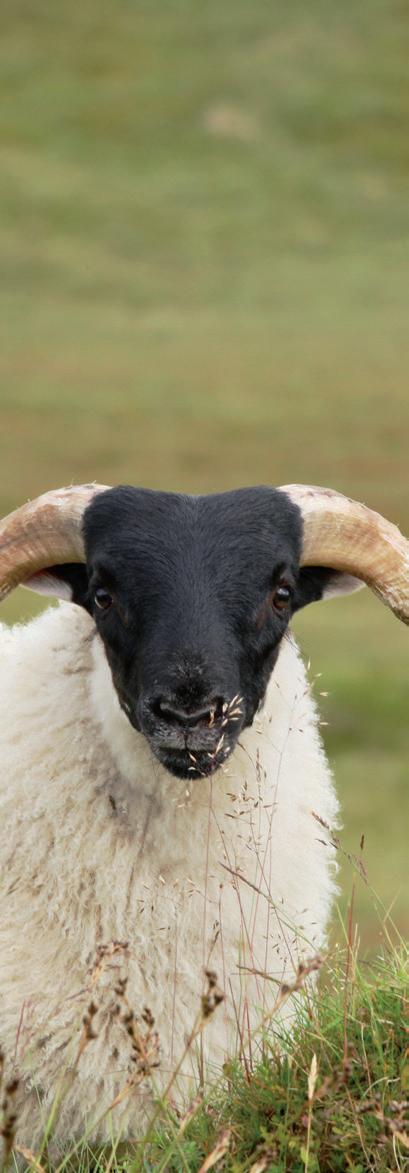
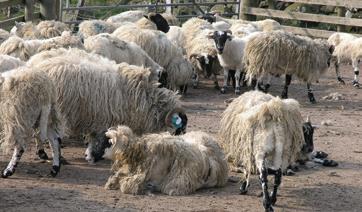
Farmers are reminded about the importance of testing incoming sheep for scab to avoid introducing a costly issue and administering unnecessary treatments.
The Sheep Scab Blood ELISA test detects antibodies that sheep produce in response to infection as quickly as two weeks following exposure.
Farmers bringing sheep onto the farm are advised to quarantine the flock for 3-4 weeks and test 12 animals from each group after two weeks using the blood test. The test costs about £84 for 12 animals. The test will indicate whether the group of sheep has been exposed to scab and whether treatment is necessary, explained Independent Sheep Consultant Lesley Stubbings.
“You cannot tell simply by looking at sheep if they are carrying scab mites. Clinical sheep scab can take weeks, if not months, to present itself, by which time much of the flock can be infected.
“The Sheep Scab ELISA test means scab can’t hide from us anymore. It makes it much easier for farmers to use the right product at the right time, knocking sheep scab on the head,” she added.
Ms Stubbings says using medicines simply as insurance or ‘just in case’ leads to problems with resistance,
but it is also expensive and often doesn’t provide the required control.
“By testing, farmers can be sure whether they need to treat or not,” she said.
Treatments to Control Scab
Farmers can treat sheep scab in two ways:
1. Using an injectable group 3-ML such as CYDECTIN 2% LA has been proven to treat scab infestations and prevent re-infestations for 60 days from a single injection.
2. Plunge dipping using an organophosphate (OP) dip.
Ms Stubbings says the treatment choice comes down to the most practical method for the farmer, ensuring every animal is treated correctly.
“The main thing when treating for scab is that you do it properly, whether using an injectable or a dip. There’s no reason why you shouldn’t use an injectable, providing it is used properly, meaning the correct dose is administered and all the animals are treated. It is a practical option when there’s only a small number of sheep to treat or if there aren’t the facilities for dipping,” she added.

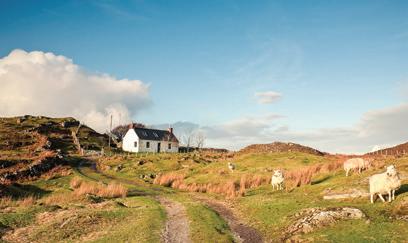

It had been widely referred to as a consultation on the agriculture bill, but it is actually a consultation on vague “Proposals for a New Agriculture Bill”. In other words, after deliberating for 6 years, Scottish Government offer no draft bill to refer to and we are told that there will not be a consultation on a bill or on the secondary legislation needed for implementation. There is no clear plan on how stakeholders and the public will be involved in taking this forward.
This consultation has been received with various degrees of hostility, ranging from exasperation to contempt. Producers met together soon after its release to discuss how out of touch Scottish Government must be and how appalling the engagement has been. It is the angriest I have seen agriculture stakeholders –anger at being kept in the dark at a time when there are many uncertainties such as the cost of living, fuel prices, feed availability, external markets and so on. We don’t
need more uncertainty. And as the Agriculture and Rural Development stakeholder group set up by Scottish Government wasn’t convened for 9 months –during the critical period of the formation of agriculture policy leading to the consultation – producers continue to meet and will be advising government on what is needed.
I would, however, mention some of the positives that are coming from the bottom up whilst Scottish Government is dragging its feet. Work that is going on behind the scenes, many organisations, including ourselves, with limited capacity, trying to do the work for the government. Organisations coming together to discuss potential ideas for mechanisms where those have not yet been put forward by government. The engagement and cooperation within the sector and between different grassroots organisations. There are a lot of good things going on –they are just not coming from the top.
As September began, the GB Standard Pig Price (SPP) came within a fraction of the £2/kg dwt mark having posted a 29th consecutive weekly increase, according to the latest market commentary from Quality Meat Scotland (QMS). Over this period, prices have rebounded by 45%, moving 28% above last year and the five-year average.
Nevertheless, QMS Market Intelligence Manager, Iain Macdonald says it should be noted that production costs are estimated to have remained well above current farmgate price levels, maintaining a longrunning margin squeeze which began in late 2020.

Meanwhile, although carcase weights have slipped behind year earlier levels for the first time since March 2020, they are increasing again, along with the proportion of standard carcases weighing over 104.9kg.
“In the nine summers since the SPP was introduced in 2014, this is only the third time that prices have trended higher in August, the other two years being 2016 and 2019, when a shortage of pork in China drove the global pork market higher.
“This year it has come despite a large increase in UK pigmeat supply during the first seven months, with higher exports to the EU unable to offset a reduction in trade with China, the impact of higher carcase weights on domestic production and increased imports,” highlights Mr Macdonald.
As we move into the autumn, while pig slaughter numbers tend to rise seasonally at GB level, there is some expectation of tighter pig supply than last year, driven by a reduction in the pig herd in response to the severe pressure on producer finances.
“Unfortunately, we have not had pig census results for
Scotland since June 2021, but English census results can at least provide some indication of the situation at GB level.
By December 2021, England’s sow herd was already showing a year-on-year decline of 7%, but this had accelerated to 17% by June 2022, with fattening pig numbers going from an 11% year-on-year increase last December to a 1.4% decline by June 2022,” explains Mr Macdonald.
After a small increase in slaughter of 1% above 2021 levels during the first half of 2022 at GB abattoirs, there was a 4% decline through July and August combined. However, an ongoing labour supply challenge may have also factored.
While the pace of price upturn slowed in GB, the EU average grade E carcase price rose by 9% in seven weeks, although a forecast for Germany suggests that the market is levelling off again.
EU prices have reached 183p/kg, meaning a 9.5% price lead for the GB SPP, down from 20% at the beginning of August and 32% a year earlier. EU slaughter numbers declined by 3% in the first half of 2022 and are expected to tighten further given that the EU Commission is forecasting a 5% decline in EU pigmeat production in 2022.
“This could limit competition from cheap imports this autumn,” Mr Macdonald states.
Market prices have been holding up in both the UK and EU despite challenges in exporting pork to China. According to the EU Commission, combined EU and UK export volumes to China contracted by 60% in the first half of 2022, only partially offset by growth to other markets, including the Philippines, Japan, Korea, Australia, the USA and Ukraine. Indeed, overall exports
to destinations outside the EU and UK trade area fell by 25%.
In China, pig and pork prices jumped higher between June and July and have started to increase again in September as the midautumn festival and Chinese National Day holidays approach. While Ministry of Agriculture data points to a strong year-onyear increase in pork production of 8% in the first half of 2022, breeding sow numbers were down 5% year-on-year in July and slaughter fell back, 3.5% below 2021.
“Meanwhile, with imports down 65% on 2021 and exports rising, overall market supply is likely to be tightening,” highlights Mr Macdonald.
As a result, the Chinese Government is releasing pork from the national reserve in an attempt at limiting price inflation. At wholesale markets, pork prices have approached 31 yuan/kg and £3.85/kg, compared to around 21 yuan/kg (£2.50/kg) in the first half of June. For pig producers, farmgate prices are approaching 23 yuan/kg (£2.85/ kg).
“Although covid-19 control measures may be making it harder to access the Chinese market, there will still be significant opportunities for exporters that are shipping to customers there,” maintains Mr Macdonald.
Tight supply has also been a feature of the pork market in the US, with production in the year-to-date running 3% lower than in 2021. While pig prices have fallen back sharply from the peaks reached in August, they are still 10% higher than last year. Having recently been trading at a significant premium to GB farmgate prices, the US barrows and gilts price has fallen below the GB SPP in September, equivalent to 185p/kg.
Farmgate prices have also risen in Brazil and Canada this year, but to a lesser extent and they are currently trading well below GB levels, at around 140p/kg. In autumn 2021, prices in both countries had tended to run higher than in the US and EU. As of July, the USDA was also expecting supply to tighten in Brazil and Canada this year.
“While supply has been falling this year in many large producing nations with producer margins squeezed by sharply higher feed costs, the OECDFAO Agricultural Outlook has forecast that global consumption will continue to recover from the African Swine Fever Shock of 2019 and 2020.
“Given that household finances are also coming under pressure across large parts of the world, and that pork tends to be a more affordable protein, expectations of firm demand are unsurprising. By 2031, global pork consumption is projected to be 7% higher than in 2022,” concludes Mr Macdonald.
Abbey Machinery are an agriculture technology company located in Nenagh, Tipperary, Ireland who specialize in manufacturing “Total Cow” solutions for farmers. As part of the total cow solution, Abbey provides an expert feed management system, supporting the progressive on farm enterprises, while providing a consistent mix for any herd number and raising the performance of the herd.
Abbey Diet Feeders are ideal for customers wishing for extra capacity with stability and quality of mix without extra height. Included in the range are a variety of Vertical Auger Diet Feeders, Paddle Feeders and Static Feeders. Included in the Vertical Auger Feeders range

are Single, Double and TriAuger models with a capacity from 8m3 to 33.5m3 - these can all be tailored for individual requirements with optional extras.
Abbey Diet Feeders have a low power requirement and are key to saving operators’ time. For example, a farm with 1000 cows can save 10 hours a week by incorporating an Abbey feeder into their programme. Abbey Diet Feeders also contribute to a sustainable farming programme. Feeders can help reduce high emissions of ammonia by balancing fermentable energy in the feed, thereby helping to reduce carbon emissions on the farm.
Feeders feature Digi-Star weighing systems for feed
accuracy, heavy duty COMER gearboxes, and either 15mm or 22mm augers for premium mix quality. The unique tub design
of Abbey Diet Feeders results in complete movement of feed for a well-mixed, easily digestible mix for your herd.
Consistency is the key to a good ration mix and no two farms are the same. Therefore it’s important that a wide range of specifications and options are available, so that machines can be tailored to meet those requirements.

It’s 40 years since Bernard van Lengerich Maschinenfabrick (BvL) introduced the first vertical feed mixer wagon to the market, during which time the company has grown to become one of the world’s leading manufacturers of diet mixers.
Today, the BvL V-MIX range of trailed diet feeders covers a wide range of machines, available in single, twin and triple auger
variants and in capacity from 3.5m³ up to 46m³. In addition there are the increasingly popular V-M<IX DRIVE single and twin auger self-propelled models with capacities from 11m3 up to 21m³. Instead of cutting, these use a combing action to loosen the silage from the clamp which helps avoid damage and helps preserve feed quality.
At the heart of all BvL mixers are powerful mixing augers, with Hardox leading edges and adjustable knives. Twin and triple auger versions incorporate mixing wedges for a thorough and consistent mix.
A unique feature of all BvL diet mixers is the patented
EDS (Exact Dosing System) discharge. This is designed to provide consistent, even forage discharge that is deposited in a loose swath. With doors on both the left and right hand side of the feeder, this provides complete feeding flexibility and even allows for the mix to be deposited on both sides simultaneously. A wide range of additional discharge door options are available, as is a discharge conveyor on all models.
A new feature on the V-MIX DRIVE is a creep speed function that allows fine control of the speed when filling and discharging. A new automatic nixing system is also now standard which at the push of a button allows the mixing time and auger speed to be set to help ensure a consistent ration mix every time. When the mixing time has elapsed, the augers automatically shut off and engine speed reduced.

The Conor vertical feeder is the result of extensive field testing and its unique design ensures that even the toughest of bales are mixed quickly and efficiently. The design of the auger and the shape and angle of the tub allow a mixing process that is gentle on the fibre and is fast and exact in the mixing of all fodder components. The design of the auger ensures the ration is cut uniform and square. This increases the rumen “scraping” effect which increases saliva production which increases feed intake which increases milk yield. The mixing auger and tub are perfectly matched to give fast and homogenous mixing. The blades are positioned to give a uniform cut along the length of the blade, this reduces blade wear and fuel consumption.
Through the use of a Conor diet feeder you can achieve increased milk production per kg of feed and improved beef yield. You will be feeding a total mixed ration which improves digestibility in the rumen allowing
cattle to extract more nutrients from their food and produce more milk or beef. The gentle mixing process produces a better ration for your cattle. The position of the large one metre wide discharge doors on the corners of the tub

is the optimum position for the even distribution of the ration. This gives even product flow and consistent fodder discharge and prevents fodder accumulation.
The tub has a sloped welded spill ring, this prevents forage from staying on the top of the feeder and it gives strength and stability. The tub and auger are
made from the higher grade S355 steel, this reduces wear and increases the lifetime of the feeder. The Conor feeder has long forward positioned counter
knives. These help reduce material travelling around the tub at the beginning of mixing while also producing a wave effect during the mixing process.
With its range of Vertical Auger and MixMax paddle type feeders, Hi-Spec Engineering Co Ltd offers one of the widest ranges of diet feeders on the market.
A particular feature of HiSpec diet feeders is the wide range of options, with various feed-out options available, ensuring they can be adapted to suit all types of building and feeding system.
The Hi-Spec Vertical Auger range of feeders is available in both single and twin auger variants and sizes from 7m³ to 32m³.
A specific feature of the HiSpec range is its ability to quickly and efficiently incorporate complete bales into the mix, due to the unique knife arrangement, which also allows the Vertical Auger mixer to be used with lower horsepower tractors. The Vertical Auger range uses a low

pitch mixing and chopping auger that creates a simple cycle action and is fitted with eight selfsharpening knives one of which runs close to the body of the Vertical Feeder. This ensures that once the mix is drawn up by the auger, as it falls back down the side it continues to be chopped and mixed, ensuring a quick and thorough mix can be consistently achieved.
The wide range of options includes various discharge outlet positions or a variable height hydraulic chute or Cross Conveyor with elevator. It can also be specified with the Digi-Star TMR Tracker fully programmable electronic weighing system.
The Hi-Spec MixMax range of paddle type feeders range in size from 10m3 up to 24m³, and are designed to be flexible, sturdy and economical, with a
long lasting and simple design that ensures low running costs and low maintenance.
MixMax paddle feeders use the Hi-Spec Feed-Flo mixing system that features a single angled rotor arms to provide thorough end-to-end mixing
and a light fluffy ration without the need for multiple augers. The mix is discharged through a hydraulically operated door through a teaser roller that makes it easy to adjust the flow rate and provide an even, consistent feedout.

KUHN has filled the gap between its PROFILE S and L range of trailed mixer wagons with the PROFILE M series. Fitting neatly between the narrow- and wide-bodied machines, and aimed at mediumsized farms, the M series will be produced from 2023 onwards in five mixing capacities from 16 to 25m³.
The 20m³ capacity machine has an overall height of less than 3 metres, making it well suited to housing with lower access.
The largest machine in the range at 25m³ can feed 200 cows in a single pass, making it perfectly positioned for the average UK dairy herd which is estimated at 212.
Two feed out options are available, a cross conveyor in the CM model can be positioned at the front of the machine, and a chute or tilting slide conveyor is offered on the DM models. Plus models are specified with a straw blowing turbine capable of blowing 158kg of straw up to 18
metres per minute, and all models can be upgraded by adding a selection of tub extensions.
All models in the range feature KUHN’s patented 5 load cell weighing system that is well suited to both small and fullload mixtures. This is coupled to KUHN’s unique C-DRIVE system which, with a 1.10 metre distribution door, offers fast and well-balanced distribution of forage.
The twin augers can be specified with KUHN’s long-life K-NOX coating. This increases the life of the auger by up to six times by acting as a corrosion resistant layer to protect against the abrasion of acidic silica contained in forage.
For farms looking to distribute forage into troughs or raised feeders, FLEXILIFT can be specified. This tilting cross conveyor will distribute forage evenly and does not protrude from the body of the mixer wagon.

As herd numbers have grown, Carlisle-based Bowe Dairy Farming has increased feeding efficiency with a triple auger, 40 cubic metre capacity Kverneland Siloking 4.0 feeder.


“It’s not just the size,” explains George Bowe, who runs the 900-cow, 1750-acre Chalk Lodge Farm alongside his dad, Michael. “Mixing quality and unloading performance is also important for cow intake and milk production. It needs to be done quickly and efficiently.”
Replacing a 36-cubic metre model for the larger, 40-cube System 1000+ model supplied by RC Dalgleish saw one key option chosen to boost efficiency – that of HD doors.

“We had small doors on the corners of the tub, and we feed directly on-floor, not into troughs,” explains George. “We wanted
larger, wider doors, but they needed to be on the sides of the tub. This lets us unload faster, and much closer to the feed barriers.”
He says a pair of HD doors on the left-side of the System 1000+ 4535 feeder has halved unloading times.
“I’m really impressed with the unloading speed,” he says. “Our smaller feeder used to take around 30 minutes to unload a full mix, and now this bigger model empties in just 15 minutes. This saves time and diesel, and also means each ration spends
less time inside the feeder, and more time in front of the cows.”
Mixing around 40 tonnes of feed each day, grass silage forms the lion’s share of the ration, with straights added as required.
“Mixing times are unchanged, and that really doesn’t take long with a T6.180 tractor,” he says.
“The T6 offers a good mix of size and power for the feeder,
and I feel that we’ve got the balance about right.”
Cameras make it easier to see in and around the tub, and with two steered axles, the 9.9m overall length of the feeder is easy to manage.
“It turns really well, and doesn’t need a lot of space, though we couldn’t go higher, as we have low overhanging roof space on the corner of some sheds,” he says.
Harry West (Prees) Ltd are the sole importers of the Italian built Seko diet feeder range for the whole of the UK & Ireland.
The Seko range of diet feeders is possibly the most comprehensive line up of models produced and offered in Europe. From tub mixers, horizontal mixers, trailed, static and self propelled there is a size and model to suit all needs and applications. The whole range is imported and distributed in the UK via the Harry West (Prees) Ltd dealer network. www.harrywest. co.uk
The Seko Sam 7 Unifeed range of trailed Diet Feeders have models from 5 to 30 cubic metre capacity requiring tractors from 30 -170HP. Models of the horizontal mixer are also available in both stationary and self propelled machines.

Seko Diet Feeders have the ability to chop any kind of fibrous material including bales of silage, hay or straw and to quickly and homogeneously mix ingredients thanks to their “Double Mix” system. They give excellent results even with very moist material that equivalent machines would struggle with. The simple but effective design provides greater reliability, reduced maintenance and a longer machine life. Low horsepower requirements reduce wear and tear and running costs.
The range are equipped with two augers with four convergent windings rotating towards the centre with star shaped blades on their periphery. These and the centre counter blades quickly chop any fibrous materials. A large bale
of forage can be broken down in 4 to 5 minutes. The system produces a standard mix 99% perfect in less than 10 minutes and this feed results in an improved animal performance superior to that achieved by an alternative feeder.
The many options available on this range include onboard weigh system capable of interfacing with a PC, onboard crane loading, rear loading shovel, onboard silage tiller and the Vulcan series equipped with powerful blowers for bedding.

The Seko Tiger range of “Tub Mixers” are available from 9 to 45 cubic metre models. The wide range chopping- mixer models in the Tiger series offers the most complete and versatile solutions for feed preparation on farms with dairy and fattening cattle. With trailed machines, static and self propelled versions of the Tiger we can meet the demands of feeding and aim to achieve the best results both in terms of production and health of the animals.

Chopping and mixing are developed through augers designed with high resistant materials, heavier gauge with a helicoidal profile, these augers determine the smooth movement

of the products from the base to the top, keeping the mix extremely soft. The augers are equipped with special sabre-profiled blades which interact with the counter blades put diagonally in the box,
assuring a precise chop of entire bales of forage and straw.
Various feed outlets are available, conveyors and direct chutes. Choice of control systems and weighing facilities are also available.
For over 80 years Strautmann have been building their expertise in livestock feeding. Since late 2021, all Strautmann Verti-Mix diet feeder wagons have been equipped with new IMS (Intensive Mixing System) auger.

Previously, Strautmann’s tried and tested Vario2 auger consisted of 900 stepped segments, welded to each other to form a particularly solid and robust mixing auger. However, in order to further improve mixing efficiency and to extend the service life, Strautmann have changed the auger’s geometry.
The 900 steps have become 600 steps and the number of steps has increased meaning the ration is both rotated and tumbled. Increasing the number and flattening the steps between the auger elements improves
the tumbling action, providing a homogeneous mix faster, whilst using less power and creating less wear.
Strautmann Verti-Mix wagons range from a single auger with capacity of 7.5m twin to a triple auger machine with 45m³capacity. The mixing tub design is also patented and provides the container with additional rigidity but it also adds flexibility, by enabling attachments to be added, increasing the capacity of the mixing tub. The double auger 2401 (capacity 19m³ – 24m³) is the most popular model in the UK and is typically suitable to feed out between 190 and 240 animals.

Once the mix has been processed it is all about feeding out, many discharge options are available to suit individual
needs – from single and double doors to a cross conveyor or a V conveyor designed to feed over a feed barrier or into a trough.
Various weighing options are available and, through Strautmann’s selected partner status, the popular CowConnect


plug and play weighing and feeding app can be specified.
All Strautmann diet feeders are backed up by strong and reliable support, both from the network of Strautmann dealers and by OPICO’s dedicated technical support team.

Nominations for Lantra Scotland’s 2023 ALBAS, the Awards for Land-based and Aquaculture Skills, are now open.
Employers, colleges and schools, delivering learning in landbased and aquaculture, are being asked to help Lantra recognise and promote those working in the sector, by nominating their top candidates.
The ALBAS celebrate the achievements of individuals, organisations and partnerships, providing trainees of all ages with a springboard to succeed in their careers and encouraging businesses to invest in the next generation.
This year, industry categories cover agriculture, animal care, aquaculture, equine, environmental conservation, fisheries management, game and wildlife, horticulture, land-based engineering and trees and timber.
As well as prizes for Overall Winner, Runner-up and Modern Apprentice of the Year, there are also prizes for Higher Education, School Pupil and Secondary Schools, CARAS (Council for Awards of Agricultural Societies), Jean’s Jam for inspirational tutor, the Tam Tod Trophy for outstanding young learner, and the Anna Murray Award for Partnership Working.
You can nominate yourself, someone else, a school or a partnership at https://www. scotland.lantra.co.uk/hownominate-person-school-orproject-our-albas
Deadline for entries is Friday 9th December and winners will be announced at a prestigious evening ceremony in the DoubleTree by Hilton Dunblane Hydro on Thursday 9th March 2023.
Call Lantra Scotland on 01738 310364, email scotland@lantra. co.uk or visit www.scotland. lantra.co.uk/learner-year
RSABI will be promoting its Help for Heating grant throughout the autumn and winter months. This grant is open to people in Scottish agriculture who are struggling financially, with payments starting at £300 to help with the cost of heating their homes.
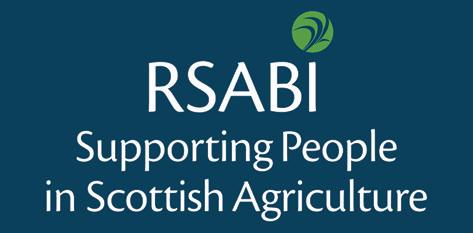
RSABI has already seen a significant uptake in their Help for Heating support in light of rising energy prices and the cost-of-living increases.
RSABI’s Chris McVey explains more:
“Our Help for Heating grants start at £300 but can be significantly more, depending on different circumstances and people who contact us may find they are eligible for other forms of support when they contact the team.
“Oil is very often used by those living in cottages and
older, rural properties and we are particularly keen to raise awareness of our Help for Heating grant to help with kerosene and other ways of heating.
“I would urge anyone in Scottish agriculture who is struggling to heat their home, or who are worried about their situation to get in touch with our friendly and professional team. We help a wide range of people involved in agriculture, from working farmers to those
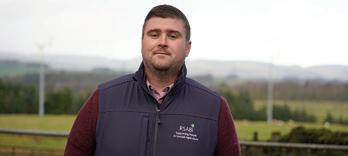

who have retired from the industry. All support is offered in confidence.”
RSABI can also offer a range of other support, including a free counselling service for people feeling overwhelmed, and can be contacted 24 hours a day by calling their freephone helpline number 0808 1234 555 or using the webchat service on its website. Email enquiries to helpline@rsabi. org.uk are responded to during working hours.
www.farmingscotlandmagazine.com
RSABI’s helpline is open every day of the year from 7am to 11pm on 0300 111 4166. Visit www.rsabi.org.uk for more information on support provided.Chris McVey
If you’re a horse owner, you’ll know just how much the weather can impact their diet, turnout routine, and overall quality of life. So, as the seasons start to change and the weather gets colder, there are a few key things to start changing or incorporating into your horse’s daily routine.
To help you keep your horse happy and healthy whatever the weather, the equine enthusiasts at Horse & Country have shared their top tips for autumn and winter care.
If you tend to visit your horse a little later in the day, then you may want to adjust your routine to suit the shorter sunlight hours during winter. Try to make your visits as early in the morning as possible, so that if you ever run into any complications or your horse has a health issue, you can deal with it during daylight. It might be a bit of a struggle getting up earlier on cold, dark mornings, but this will allow you to set your horse up for the day with the right shelter, rug, food, and water that they’ll need.

It can also be incredibly useful to reach out to fellow liveries or other local owners, be that via social media or simply by chatting over the fence at neighbouring fields and stables. This way, you can enlist a fellow owner’s help for short-term care or even assistance if you’re unable to reach your horses in an emergency (for example, due to illness or adverse weather).
When grass is less readily available due to waterlogged or frozen ground, it’s important to provide your horse with plenty of its own forage. In fact, forage — meaning good quality grass or hay that is dust- and mould-free — should make up at least half of a horse’s daily intake. Not only is forage an important source of
fibre that contributes to a healthy digestive system, but it also helps to encourage natural foraging behaviour. Horses have evolved to graze and chew for as long as 14 to 20 hours a day, and doing so produces enough saliva to buffer the large amount of stomach acid they need to digest tough plant material (Equine Behaviourist). Chewing forage can indirectly keep them warm, too: breaking down the fibre creates heat, helping to maintain their core body temperature.
Don’t forget that it can be a little harder to monitor your horse’s nutritional needs and body weight when using forage alone. If you’re concerned about your horse losing weight during the colder months, then including bucket feed alongside their forage can help you maintain the necessary calories in their diet. It’s also wise to add a balancer or vitamin and mineral supplement to their forage so you can be sure that they receive a balanced diet that contains all the nutrients they need.
To keep on top of your horse’s weight all year round, you may want to learn how to do body condition scoring and use a weight tape every few weeks. This way, even if you see your horse every day and are less likely to notice any difference, you can still have an objective record of how healthy your horse is as their exercise and diet change with the seasons.
While you might associate plenty of fresh water with warmer weather, staying hydrated is just as important in winter as it is in summer. Adult horses can drink anywhere from 24 to 40 litres of water every single day, depending on the moisture content of their food and their activity level (The British Horse Society). Providing them with access to lots of fresh water is therefore crucial, and in winter always check that your
troughs or the taps in your stable haven’t frozen and made the water inaccessible. Break up any ice that has formed and keep an emergency supply in containers in a warm spot just in case. You may also want to fill their buckets with warm (but not hot) water to help stop it from freezing during particularly cold nights.
Protect them from the elements Whatever the season calls for, it’s crucial to adapt your horse’s environment to the weather. While you may turn them out for the whole of spring and summer, when it gets colder, they may have to spend more time in the stable to avoid low temperatures, snow, or the field becoming poached and muddy from prolonged rain. Try to keep your stables in good condition all year round, as your horse will have a much better quality of life if they live in a clean, dry, draught-free, and wellventilated environment.
Even in winter, it’s still important for horses to get regular exercise and mental stimulation, and not spend too much time in the stable. However, when they’re getting exercise outdoors, always provide shelter for your horses year-round, as this can act as shade from the sun as well as protection from cold winds and rain. It’s also important to give them a dry, solid surface to stand or lie down on, as wet, cold, and muddy ground can make them ill over time.
When temperatures really drop, remember that old,
underweight, and fully clipped horses will need a rug as they are more vulnerable to the cold.
If you’re turning your horse out for the winter, they’ll need a rug with plenty of insulation and a waterproof outer layer. However, if they’re stabled, they can wear a less heavy-duty, quilted rug. Especially when worn in the stable, just make sure that their rug is breathable and moisturewicking, as this can help prevent infections and allow your horse to sweat without catching a chill.
If you think you’ll struggle to keep up with visits during the colder months, it may be worth considering keeping your horse at full livery. Especially if you have multiple horses and a busy schedule, booking them into a fully managed yard for the winter can sometimes be the best decision for you both. Full livery should include mucking out, grooming, turning out, and exercising as agreed upon with the owner, meaning that your horse will be looked after to a very high standard.
As a result, this makes full livery quite an investment, but it means you can still ensure the best possible care for your horse even when your schedule gets in the way. Just be sure to research and perhaps visit the yard beforehand, so you know that you’re trusting your horse to a reputable establishment with well-trained onsite staff.

The loss of precious hedgerow habitats in Scotland would have worsened at a much faster rate had it not been for the popularity of pheasant shooting.
That is the view of Scotland’s professional Gamekeeping body as the nation celebrates National Hedgerow Week, which begins on Monday 10th.

Fruit and blossom-rich hedges are a treasured part of Britain’s landscape, demarcating field boundaries and acting as vital ecosystems in their own right.
However, changes to postwar farming incentives, to boost food production, led to 50% of the UK’s hedges being torn up or lost due to lack of management.
Refuges for wildlife, today they are being re-assessed as vital to Net Zero plans, given their ability to sequester carbon and to reduce air pollution.
And gamekeepers in Scotland say the loss would have been accelerated had it not been for game shoots planting new hedges to provide cover for
pheasant and partridge shooting.
“Had it not been for shoots, more hedges would have gone from Scotland’s landscape by now. Unless there has been a reason or an incentive to plant or manage hedges, they have tended to be ripped up, which is really sad, given their huge value,” said Scottish Gamekeepers Association
Chairman Alex Hogg, MBE, who has planted and managed hectares of privately funded hedgerows where he works in the Scottish Borders.
Pheasants and partridges nest and shelter in warm grasses at
hedge bases, benefitting from the insect food source as well as berries and seeds.
That helps to retain birds ahead of the shooting season, which is worth millions to the rural economy.
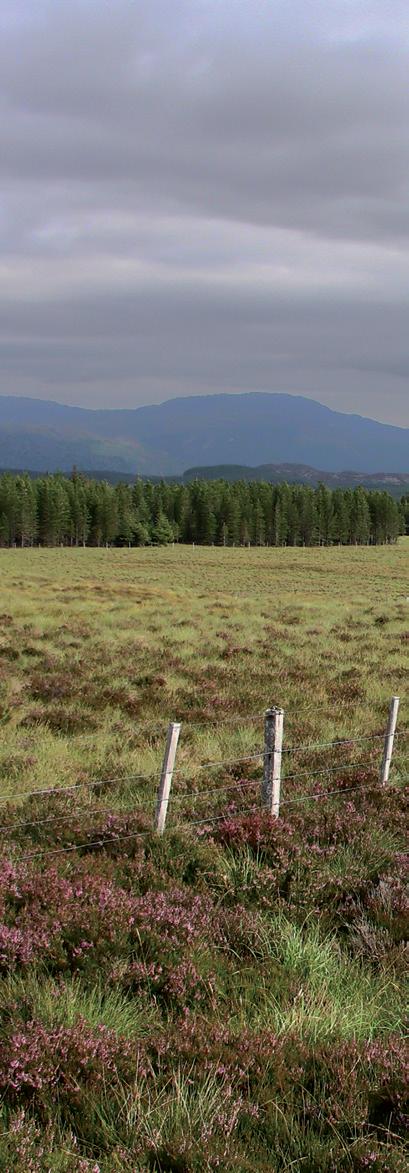
 By Stephen Young, Head of Policy at Scottish Land & Estates
By Stephen Young, Head of Policy at Scottish Land & Estates
Often running the risk of sounding like something of a broken record, it is fair to say that Scottish Land & Estates has been vexed over recent years by the lack of progress and detail of what comes next for Scottish agriculture and land management.
support farmers and land managers will have to make the changes necessary for the future.
Located in a rural yet accessible location close to Glasgow is an attractive area of woodland, split into several parcels of amenity land.

For sale as a whole or in three separate lots, Woodlands at Foreside is 43.98 Ha (108.67 Acres) in total and presents the potential to develop woodland structures, natural habitats and biodiversity interests.
Situated one mile north west of the village of Neilston on the outskirts of Glasgow, the land benefits from being close to amenities and enjoying some panoramic views across the beautiful countrysideThe three individual parcels of woodland, which are all similar in composition, were planted at the same time under a single
grant scheme. They comprise mixed, mainly native broadleaved woodlands with designed open ground with a developing ground flora which combine to provide an interesting variety of habitats for a range of woodland birds. Parts of the woodland are bounded by established hedgerows adding to the habitat diversity.
Woodlands at Foreside, by Neilston, Glasgow is for sale through Galbraith as a whole for offers over £440,000, or in three lots as follows:
• Lot 1: 19.89 (Ha) 49.15 (Acres) – offers over £200,000
• Lot 2: 15.43 (Ha) 38.13 (Acres) – offers over £130,000
• Lot 3: 8.66 (Ha) 21.40 (Acres) – offers over £110,000
Therefore, the recent launch of the Agriculture Bill consultation could perhaps have been the pivotal moment when our long-held unease was finally assuaged – instead, it appears to have galvanised the sector in demanding a change in gear from government.
In our initial reaction to the consultation, SLE welcomed the fact that it had finally arrived but said that we would need to examine the fine print in due course. For many organisations, the absence of precise detail in the consultation is what is causing the major issue.
Our organisation published our updated #Route2050 policy paper at the Royal Highland Show in June and we set out why we believed 50% of payments should be made to support active farming businesses, with the additional support available for measures to improve biodiversity, carbon sequestration and wider natural capital.

The government appears to be broadly aligned with this thinking, with four tiers covering direct and indirect payments, but the consultation is very light on the detail of exactly how this will be delivered and what
Indeed, such was the disquiet across the sector that it compelled 18 farming and rural organisations to meet to discuss both the lack of clarity and engagement being offered by government and the vacuum of information from the Agriculture Reform Implementation Oversight Board (ARIOB).
With the conclusion of the transition period looming by the end of 2024, we were also surprised that the recent programme for government announced by the First Minister at Holyrood made no mention of the agriculture bill that will follow the newly launched consultation.
That being the case, it can only be assumed that the September 2023 programme for government will include agriculture in the legislative programme – leaving 15 months maximum for a Bill to be introduced, amended and passed and then for farmers and land managers to know what steps they have to take to almost instantly comply with new support mechanisms.
For more information
:
In a tough economic period that is already going to stretch the viability of many of our farming businesses, it seems we have a rocky path ahead with agricultural reform – and we may run out of road following years of unwarranted delay.
A national strategy has been published setting out a route map for beavers in Scotland over the coming decades.

The development of Scotland’s Beaver Strategy 2022-2045 has involved more than 50 stakeholder organisations, representing one of the most ambitious and forward-looking approaches to managing and conserving a species ever carried out in Britain.
The strategy will steer wider efforts to identify and actively expand the population to new catchments, alongside appropriate management and mitigation, following the Scottish Government’s change in policy to encourage wider beaver restoration.
It sets out plans to empower and support communities to maximise the environmental and wider benefits of beavers, while minimising negative impacts through effective management and mitigation.
The strategy highlights the need for ongoing research and monitoring of the beaver population and its effects to inform and improve management
as the population expands, using existing and new techniques and technologies. This will also help identify how people, and ecosystems, can most benefit from the presence of beavers.
The strategy was developed collaboratively under a process designed and led by the International Union for
Conservation of Nature (IUCN) Conservation Planning Specialist Group (CPSG).
A cross-stakeholder organising team including representatives from NatureScot, National Farmers Union of Scotland, Scottish Wildlife Trust, Scottish Land & Estates and the Royal Zoological Society of Scotland helped to steer
the process, and the document was produced through the direct involvement of stakeholder groups and individuals from a wide variety of sectors.
A new Scottish Beaver Advisory Group, made up of key organisations, will now work together to help take the strategy forward.

Galbraith is delighted to bring to the market Woodside Farm, an attractive traditional farmhouse with extensive pasture land situated in an idyllic setting, surrounded by the beautiful countryside of Dumfries & Galloway and close to the coast.

The property has just under 23 acres of grazing land in lot 1, with further land available for purchase in lots 2 and 3.
Rebecca Reed of Galbraith, who is handling the sale, said: “Woodside Farm offers a wonderful opportunity to modernise the farmhouse and
create an absolutely superb family home. The setting couldn’t be nicer – surrounded by the tranquil rolling farmland of the region yet easily accessible to local amenities while the River Nith close by leads down to the sea and there are lovely beaches about half an hour away at Powillimount and Sandyhills. The purchasers could create a varied smallholding with a good amount of pasture land, or could perhaps keep ponies. This is an excellent opportunity to create a superb home in a beautiful setting.”
Woodside Farmhouse is situated in an elevated south facing position. The living room on the first floor takes advantage of the views towards the river Nith, Glencaple and to the Solway Firth. The farmhouse as currently configured has two reception rooms, three bedrooms (one with walk-in wardrobe), family bathroom, shower room, kitchen, utility room, separate store room and office.
Whilst the property does require modernisation throughout, it offers spacious accommodation which could be easily adapted to suit modern tastes.
The extensive steading buildings are a mixture of modern and traditional construction and are suitable for a variety of purposes. The land is currently grazed on a seasonal grazing licence. There are no leases presently on the land, and it is available to purchase with vacant possession. The sale is divided into three lots, offering the potential to acquire a more sizeable landholding if desired.
To the side and front of the farmhouse is a good size garden which is mainly laid to lawn with a decking area and mature shrubbery.
There are currently plans for an afforestation project around the property. Draft plans will be available on request and potential purchasers will be offered the opportunity to comment on the consultation relating to the project.
The property is sold with a prohibition on the purchaser objecting to any planting proposals on the adjoining and neighbouring land. For more information contact Galbraith.

Woodside Farm is for sale through Galbraith in three lots as follows:
Lot 1 – Woodside farmhouse, farm steading and land which measures in total 22.89 acres (9.26 hectares), including the farm steading and farmhouse. Offers over £550,000.
Lot 2 - 37.86 acres (15.32 hectares) Offers over £225,000.

Lot 3 - 5.98 acres (2.42 hectares) Offers over £50,000.

Fox predation can have significant local impacts on livestock and endangered ground-nesting birds and hares. However, current political activity in Scotland could severely reduce the ability to control fox numbers, including a review into the potential ban on the use of snares.
The use of snares is a contentious topic, but modern humane cable restraints as they are now termed are far removed from the crude, cruel and indiscriminate snares of the past. Welfare aspects must be front and centre of all predator control, backed by operator registration and accreditation.
The Game and Wildlife Conservation Trust (GWCT) has done a huge amount of work on improvements to snares including safety stop positioning, double swivels and breakaway sections that considerably reduce welfare risk and capture of non-target species such as deer and badgers. Research,
development and operator training is ongoing.
The Trust’s professional advisors work hard to ensure that all legal aspects are adhered to, that snare operators understand their responsibilities, that what they use is fully humane and that it conforms to current animal welfare legislation. These requirements were introduced in the Wildlife and Natural Environment (WANE) Act in 2011 and have ensured that Scotland has the most stringent restrictions on snaring in the UK. As part of the legislation, 5-year reviews show a decreasing number of incidents in use of illegal snares and illegal snaring in Scotland. We know that cases investigated by the Crown Office and Procurator Fiscal Service point towards deliberate use of snares by untrained users rather than recklessness by trained users.
Further constraints placed on predator control intended to support ground-nesting birds, hares and livestock will
erode the ability to manage both for conservation and economic reasons and, once enacted, legislation in the arena of wildlife management will be challenging if not impossible to reverse.
The Scottish Government has indicated that a flexible management approach is needed for management of our natural environment and with biodiversity currently in crisis, we question whether this is the right time to be closing off any options that might aid its recovery. GWCT has undertaken to work with stakeholders across the farming and land management sectors to ensure that all options remain available and fully compliant with welfare requirements whilst continuing to provide for conservation and economic good.
The latest GWCT film on the design and use of humane cable restraints is available at: https://www.gwct.org.uk/ blogs/news/2022/ september/video-what-is-ahumane-cable-restraint/

The purpose of the Scottish Government Woodland Planting Grants is to support the creation of new woodland, which will bring economic, environmental, and social benefits. Its overall aim is meet the UK’s target to increase woodland cover, help mitigate climate change by reducing greenhouse gas emissions through carbon sequestration and restore ‘lost’ habitats. The grant also aims to support a sustainable forest industry by providing a reliable timber supply and support rural development through local businesses and farm diversification.
Here Sarah Radcliffe, Forestry & Woodland Manager at H&H Land & Estates discusses the scheme options:
“Depending on the species you want to plant and the size of the woodland there are in total nine different grant types available. With the exception of the Small or Farm Woodlands and Native Broadleaves type where the minimum block size is 0.25 hectares, for all other grant types of the minimum block size is 2 hectares.
The grant is split into three parts:
* Tree planting is being paid per hectare
Additional capital items such as fences and gates are paid per item
* An annual maintenance payment for five years
The planting payments rates vary from £560 per hectare for lowdensity broadleaves to £2,880 per hectare for productive broadleaves (£2,160 per hectare for diverse conifer). Maintenance payments vary from £96 per hectare for
the low-density broadleaves to £528 per hectare for productive broadleaves (£400 per hectare for Small or Farm Woodlands).
Lastly, we have the Woodland Carbon Code which is a voluntary carbon standard for UK woodland creation projects. The code generates independently verified carbon units and is backed by the government and internationally recognised for its high standards of sustainable forest management. A new native woodland can capture 400 -500 tonnes of CO2 (tCO2e/ ha) over 100 years which is why they are so vital globally for reducing the levels of carbon in the atmosphere. The carbon from your woodland can be sold in the form of Woodland Carbon Units and recently buyers have been receiving £5 - £15/tCO2e for carbon units captured and verified by the WCC. There is no minimum size and there is a streamlined process for woods of less than 5 hectares.
The payments available for these schemes is good news
for people looking to create woodland areas, and I would advise anyone who has land they think might be suitable for woodland, to investigate these schemes and opportunities.”
If you would like any further information or advice about the any of the schemes, please contact Sarah via e-mail at sarah. radcliffe@hhlandestates.co.uk or call on 01228 406602.
Six new studies have received £3 million to demonstrate how UK treescapes can be expanded effectively
Trees capture greenhouse gas emissions, reduce flooding, support biodiversity and improve the wellbeing of people
Increasing and improving woodlands and tree cover will help us adapt to climate change and are a vital step to meet the UK commitment of net zero emissions by 2050
Six major research projects will explore the most effective
ways to expand the UK’s trees, hedgerows, woodlands and forests in rural and urban settings.
Forests and other treescapes account for 13 per cent of the UK’s land surface, and capture approximately 21 million
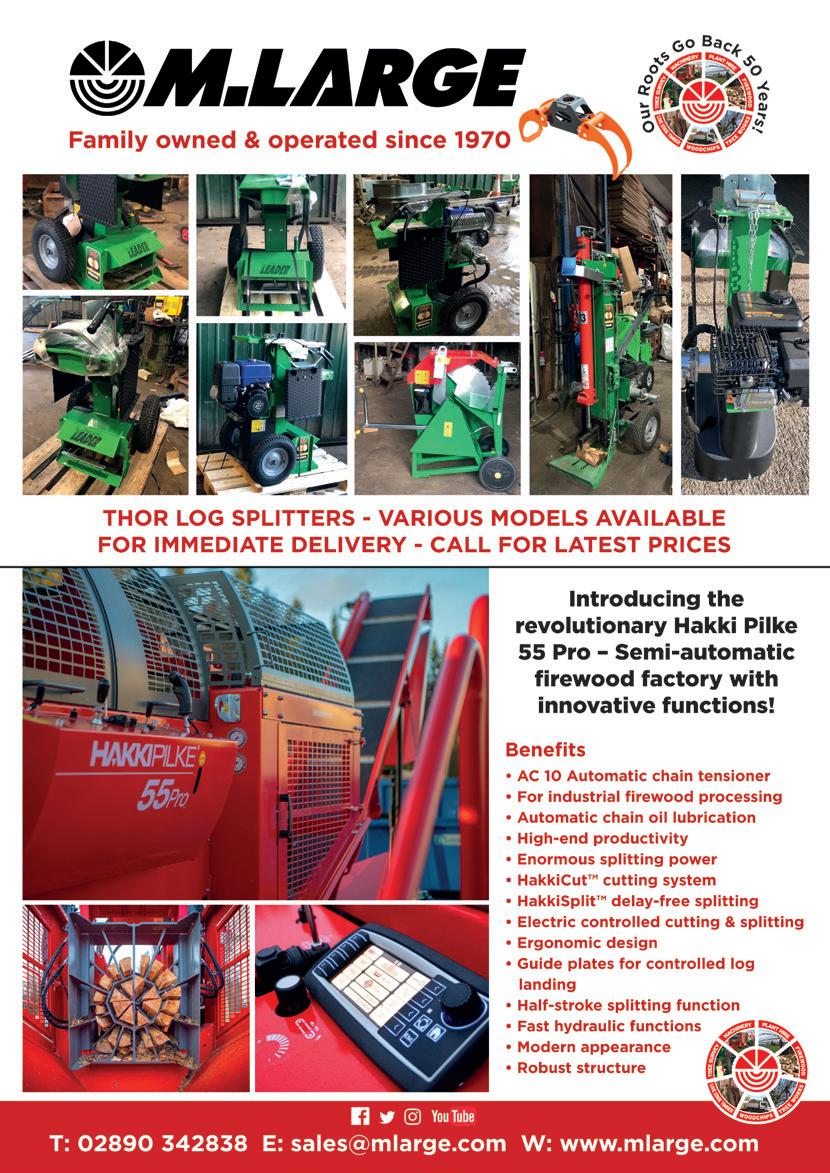
tonnes of carbon dioxide a year*, providing an important contribution to the UK’s goal of reaching net zero carbon emissions by 2050. They also reduce flooding, improve biodiversity, reduce pollution and benefit people’s wellbeing.
The six interdisciplinary studies announced have received a share of £3 million funding over the next two years from UK Research and Innovation.
Each project will improve our understanding of the composition of treescapes in the UK, and their value to people and the planet.
The research will also support the Government’s ambition to increase tree cover across the country.
The six projects will:
• Investigate new approaches to woodland expansion, including natural colonisation.
• Develop practical tools for farmers to support the expansion of tree planting on agricultural land.
• Study the development of agroforestry, which is the growing of trees alongside crops and livestock farming
on the same land, in rural areas and surrounding towns and cities.
• Establish a web-based tool that will map the risk of woodland and farmland damage caused by deer.
• Establish how to bridge the gap between national objectives of net zero and tree planting targets, and how to practically achieve that at a local level.
• Understand the potential to diversify the composition of tree species in woodland to increase resilience to climate change, pests and diseases.

Involving multi-disciplinary teams led by six research institutes, the studies are part of the £15.6 million Future of UK Treescapes programme.
The programme is designed to answer the ‘what, where, how and for whom’ of treescape expansion and will help us to better safeguard our trees, woods and forests. The research will also investigate the importance of tree expansion in urban spaces, why we connect with woodlands, and how we encourage landowners and farmers to plant more trees.
It has been a very busy year for Scottish Forestry’s tree health team who have the job of helping to protect Scotland’s forests and woodlands from a growing number of tree pests and diseases.
A big part of their job is to carry out surveillance and monitoring of our woodlands to spot diseases.
So far this year, over one million hectares of woodland have been surveyed by the team.
Along with keeping alert for a range of other tree pests and diseases, the agency’s tree health experts are keeping a watchful eye on larch trees which are under attack from a disease called Phytophthora ramorum.
This disease has been found in Scotland since 2002 on a range of species in horticultural settings.
Since 2009 it has increasingly affected forests containing larch in the south and west of Scotland, where the wetter and warmer climate is
known to be favourable for the disease.
There is good news though. As a result of the actions set out in the current P. ramorum Action Plan, the disease appears to be under control across most of Scotland.
The main surveillance programme is run by Scottish Forestry with the support of Forestry and Land Scotland and Forest Research.

However, citizen science is also proving to be very useful with many foresters and members of the public reporting potential tree infections through the TreeAlert portal.
James Nott, Head of Tree Health at Scottish Forestry said: “We can all do our bit to help stop pests and diseases spreading, whether you are a forester or a member of the public.

“Tree diseases can be spread on machinery, vehicles, clothing, bike tyres and even on dogs paws, so everyone should Keep it Clean before visiting a forest.”
More information, including the updated map on disease spread of P. ramorum and a link to the Scottish Forestry larch action plan can be found here : https://forestry.gov.scot/sustainable-forestry/tree-health/ tree-pests-and-diseases/phytophthora-ramorum
LAMMA returns to the NEC Birmingham on 10 and 11 January 2023 with its renowned combination of agricultural machinery and technology, panel debates and opportunities to gain CPD points.

While the big names in agricultural machinery and technology will be showcasing their kit – many using the event to launch new products or updates – LAMMA is also
an opportunity for fledgling manufacturers to be seen.
One example for 2023 is Stephen Davies, winner of the LAMMA Young Engineer Award 2022 who will be heading back to the Show at the NEC Birmingham exhibiting his award-winning DTEC 200 feeding and mixing bucket.

When attached to a small tractor or telehandler the DTEC 200 allows accurate mixing and
delivery of feed rations to cattle. At just 2m wide it is believed to be the first such product suitable and commercially viable for small farms. It impressed the 2022 judging panel for its role in improving feed efficiency.
Since winning the award, Stephen who is based at Llanymynech in Powys, Wales, has been continuing to develop the feed bucket alongside other engineering projects.
“I split my time between working on machinery repairs –anything from gear box rebuilds to fabrication work – and developing the bucket,” says Stephen. “I have also started buying in some used buckets to recondition or service and sell on to customers. It helps with cashflow and also with improving my knowledge and experience of different feed buckets.”
Developments to the DTEC 200 have included moving the gearbox to the outside. “It is still fully protected but moving its position has freed up space inside to increase capacity,” he explains. “Also the position of the hydraulic cylinders has been improved along with the size of the paddles on the mixing rotor, although I’m still perfecting the angle of the paddles. I have also added a short discharge chute on the left hand side which means the telehandler or tractor doesn’t have to drive so close to the feed trough.”
Another addition is the option of 12 knives on the rotor. “Adding the knives helps to speed up the mixing time, which changes considerably between silage types,” explains Stephen.
He is excited and proud to be exhibiting at LAMMA at
NEC Birmingham on January 10 and 11, 2023. “It is important to discuss the principles of the bucket with potential customers and help spread the word to new ones,” he explains. “I’m looking forward to showing them the updates and getting a bigger picture of what farmers will require in the future.
“There is always a big pool of farmers from across the country at LAMMA and it will be great to hear what they think of the bucket and hopefully set up some demonstrations from there.
“As a manufacturer you need to keep in front of your customers and LAMMA is one of the very best shows to do that.
As a British manufacturer I feel that it is particularly important to be there. I’m a bit nervous, but it feels quite an achievement.”
Winning the 2022 Young Engineers Award was a confidence boost, says Stephen. “It showed me that I was on the right path and had made a good decision to launch my own business and continue working on the DTEC 200.
“I would definitely recommend other young engineers to enter the Award. It is a great platform to get your product out there or to be seen by manufacturers if that is your aim.”
Nichola Bell, Head of Events for Agriconnect which organises LAMMA said the team was delighted to be launching the Young Engineers Award for 2023. “We believe it is really important to nurture the next generation and this award aims to encourage and inspire young people who will be taking the industry forward.
“It is exciting to see how Stephen has progressed with his product and we wish him all the success with exhibiting at the show in 2023. I’m sure his success will encourage others wanting to follow in his footsteps.”
• Full details on the 2023 Young Engineer Award and how to apply can be found at www.lammashow.com
5 reasons to visit LAMMA!
Whether you want to get up to date on the latest hot topics, find out how to develop your career or are just keen to get your hands on the latest tech, there is something for everyone at LAMMA 2023.

Here are just FIVE reasons you should head over to the Uk’s premier agricultural machinery event in January:
1. See into the future.
The Future Farming Trail
showcases the very latest in data, robotics, autonomous machines and devices making our industry more resilient, efficient and sustainable. Take part in the Trail to be amongst the first to see the innovations from companies including Merlo, Garford and Fox Robotics that will redefine the future of farming.

2. Look for your next bit of kit (and make the most of what
you already have). With nine halls packed with agricultural businesses LAMMA offers an unrivalled opportunity to meet all the big names as well as fledgling businesses revealing their innovations too. Known as the ‘ultimate shop window’ for agricultural machinery in the UK LAMMA is the perfect place to find technology, machinery, services and innovations that meet your needs. From combine
harvesters to weather stations, and safety boots to AI weed control, you’ll find it all here.

3. Connect with others in the industry
Every year, thousands of visitors from all over the UK and Europe head through the doors of the NEC ready to make new contacts and reconnect with old friends.
4. Enhance your career and explore new opportunities. If you’re looking to develop your careers and professional qualifications look no further!
BASiS and DairyPro offer CPD points for attending and visiting approved exhibitor stands and the Training Zone will showcase opportunities for updating your practical skills and knowledge.
5. Join the debate.
Come along to hear what others have to say about the
latest issues affecting farmers and growers. Our panel debates update you on the issues that matter.
For more information about LAMMA 2023 and to register for your FREE ticket, visit www.lammashow.com

Leis gu bheilear a’ bruidhinn mu 800 millean not de dh’airgead poblach gach bliadhna, tha e caran iongantach nach eilear air barrachd a chluinntinn mu Bhile Àiteachais ùir an riaghaltais.
Ach, tha dà adhbhar math airson seo. Sa chiad dol a-mach, tha gnothaichean gu math nas cudromaiche air aire dhaoine an-dràsta (mar a tha prìsean connaidh a’ sìor dol am meud agus an cruadail a tha dol a thighinn le sin) agus cuideachd, ‘s ann a thig an obair mhòr air a’ bhile a dheànamh an ath bhliadhna co dhiù, nuair a bhios aige ri dhol tro Phàrlamaid na h-Alba.
Gu ruige seo, chan e ach iadsan a chì a’ bhuaidh as motha – croitearan is tuathanaich gu sònraichte – a tha air an guth a thogail agus dh’fhaodadh a ràdh nach eil iad ro thoilichte.
‘S e seo an crathadh as motha a tha a’ dol a thighinn air susbsadaidh an àiteachais ann an ginealach agus tha e follaiseach gun robh làn dùil ri barrachd feòil air an cnàmhan aig an ìre seo.
Mar a thuirt Stiùiriche Poileasaidh Aonadh nan Tuathanach, Seonaidh Hall: “Tha e deuchainneach air leth nach eil Riaghaltas na h-Alba air roghainnean cinnteach a chur an cèill mu chiamar a gheibh na cumhachdan ùra a thig leis a’ bhile a chleachdadh airson àrach-bidhe a chur aig cridhe buannachdan eaconamaigich, soisealta is àrainneachd.”
Aon rud a tha am bile a’ moladh, ‘s e ’s gum bu chòir dhan
dàrna leth dhen airgead a bhith air a cheangal ri coinneachadh targaidean air an àrainneachd, rud ris an robh dùil agus làn fhios gu feumar gluasad gu dòighean obrachd a tha nas uaine.
Ach, mar a tha faclan an aonaidh a’ sealltainn, tha feum air coimhead ri gnothach eile cuideachd – ‘s e sin, na tha sinn ag àrach de bhiadh anns an dùthaich seo fhèin a leudachadh, rud a tha gu mòr far comhair a-nis le cogadh Ucràin agus sinn cus an urra ri na margaidhean eadar-nàiseanta.
Tha e gu bhith gu math duilich cothromachadh a dhèanamh air na diofar feumalachdan, ma ghabhas a dhèanamh idir.
Mar eisimpleir, ma chuireas tu am fearann gu lèir fo chraobhan, gun teagamh tha sin a’ coinneachadh ri dleasdanasan

na h-àrainneachd, ach tha e a’ toirt an fhearainn sin air falbh bho bhiadh agus feumar an uair sin, barrachd a thoirt a-staigh bho dhùthchannan eile. Cà’ bheil sin a’ fàgail carbon cothromach?
An ath mhios theid caismeachd a chumail aig Parlamaid na h-Alba gus aite a’ mhor-sluaigh a tharraing gu laigse a’ bhile.
Thuirt ceann-suidhe Aonadh nan Tuathanach, Martainn Ceannadach: “’S e ceum bunaiteach a tha ann an Bile Aiteachais Riaghaltas na h-Alba air an rathad a dh’ionnsaigh poileasaidh ùr àiteachais agus na h-atharraichean a tha dol a thighinn air mar a bhios croitearachd is tuathanas a’ faighinn taic san àm ri teachd.

“Ach, thathas ag iarraidh air croitearan is tuathanaich dhol

an sas san deasbad far a bheil gainnead fiosrachaidh.
“Tha e deuchainneach air leth a’ dh’aoidheoin iomadach iarraidh thairis na miosan a dh’fhalbh nach eil soilleireachadh againn fhathast air dè na cumhachdan ùra a bhios anns a’ bhile.”
Ach, sgaradh a tha anns a’ ghnìomhachas fhèin. Aig aon cheann, tha na gnìomhachasan mòra àranta a tha cho cudromach ann an a bhith a’ cumail stuth air sgeilfichean nam bùthan mora.
Air an taobh eile, tha na tuathanachasan beinne, le stoc a’ ruith thairis raointean mòra. Ged nach eil iad a’ cruthachadh an t-uabhas bidhe, tha iad riatanach an dèidh sin airson cumadh a thoirt air na glinn is na monaidhean, le beathaichean ag inilt ga fhaicinn an-diugh nas cudromaiche a thaobh a bhith a’ brosnachadh beathaichean is lusan.
Chan eil e cho fada sin bhuaithe bho bha gach siostam ag obair làmh ri làimh ri chèile, mus tàinig cuideam bhon mhargaidh a bha a’ ciallachadh gu feumadh gnìomhachasan fàs na bu mhotha airson cosgaisean a chumail sios.
Leis nach eil am bile ach aig ìre trath fhathast, ‘s dòcha nach eil e ro anmoch cuairt bheag a ghabhail tro eachdraidh agus faicinn dè na leasanan practaigeach a tha rim faighinn.
Bhiodh dol air ais gu mar a bha cùisean uaireigin gu math tarraingeach ann an iomadach seadh, agus choinnicheadh e ri feumalachdan an là an-diugh cuideachd.
The weather continues to baffle us with its unexpected highs and lows. All too often we experienced unseasonal warmth, sudden torrential downpours and sunrise temperatures hovering around zero.
However, the 2022 weather had been kind to wildlife this year. As I write, the mature stags on the hill are looking good for the rut, and the annual roaring in the glens started earlier than usual. The birdsong had a spring-like melody as we progressed through September and the trees didn’t suffer the ‘false autumn’ sensationally banded about by the UK press in August. It may have happened down south but it didn’t happen here because our local trees followed their seasonal routine, and displayed a palette of golden autumnal hues. We are blessed in many ways with Scotland, none more so than the individual beauty of each season. Autumn and winter are my favourites: the muted colours spread far and wide across the land, the crisp frosts, and the snow-capped
by Linda Mellorhills. Seeing the local red and roe deer in their thick winter coats fluffed out on a still wintry morn, and their warm breath hanging in the freezing air. A huge bonus during the cooler months is the lack of beasties: no more midges, clegs, and other flying, biting nuisances we can live without.
I wish the tick population was killed off by the frost during the winter months but those horrors are now available to any passing human, canine, bird, or animal skin 365 days a year. There are two things the countryside can do without –ticks and bracken. Judging by the bracken growth rate, it’s been a bumper year! Bracken can provide shelter for animals, birds, and insects.
It is also a food source for caterpillars and I have seen red deer nibbling away at the new growth in spring but it is a launch pad for ticks.

The shooting season exploded into life on August 12th with the lucky ones enjoying driven grouse or walked up shooting over dogs. Some estates reported record breaking bags, and grouse numbers thrived. It’s encouraging to hear the grouse population didn’t suffer the same fate as 2021 when late snow and freezing temperatures negatively impacted survival rates of the young birds.

When Her Majesty The Queen died on Thursday 8
September 2022 at Balmoral Castle at the age of 96, I found myself thinking about her amazing long life, and about all the people she met across Scotland and the world. After 70 years as our Monarch, she had been a recognisable figure in most of our lives especially so across Scotland. Although I never met her (I did meet the Queen Mother in Dysart, Fife in the late 1960s), the Queen enjoyed the Scottish countryside: shoot days with her family, her gundogs, Highland games and gatherings, garden parties and riding her Highland ponies. There was something normal and relatable about how she spent her time outdoors. In her own quiet way, she supported the Scottish countryside and all the rural activities and events we enjoy and embrace.
We are well into the stag season as estates manage their deer populations (red stag season - 1 July to 20 October). Thankfully, the disturbances from the public are lower during the colder months as people tend to take part in most outdoor activities during the warmer months. It is noticeable there are fewer people around because of the reduction in litter dumped on the estate tracks and around remote estate buildings. This year has been the worst yet, we have picked up a steady flow of litter since springtime.
The most common items dumped are plastic drinks bottles, and cans. The photo below is an empty bottle of Buckfast. I don’t understand the lack of thought and the careless nature of people who litter the countryside. If you deliberately spend time in the countryside you are doing it because you want to be there, you love it, you appreciate it and you have an understanding, limited or otherwise, about how it ticks along. To go hiking or camping takes planning: you need to be mindful of your time, your kit and plan your route. At what point does mindful turn into mindless when walkers or campers dump their rubbish on a remote track in the hills? At what point do they think it’s acceptable to do this?
Over the years rural workers across Scotland have had to adapt to a changing job, often without additional training or salary increase but the expectation to absorb more responsibilities is ever present. I never imaged litter picking was going to be part many rural workers jobs but it sure as hell is a vital one in helping to keep our countryside clean and beautiful.
Heading to the Hills is a great website. https://www. outdooraccess-scotland. scot/practical-guide-all/ heading-scottish-hills

In 2019 Chris and Sara McGlennon bought Mid Auchengowan farm, a former potato farm, as a family home. The couple retained six acres, and the land is used by local farmers for silage and sheep. The McGlennons then set about creating a rural escape that’s both quirky and remarkably comfortable.

The farm outbuildings were swiftly upgraded and refurbished to create contemporary cottage accommodation for guests, opening in the summer of 2019. These traditional properties offer relaxation and modernity, but it’s the space-age dome that turns heads. The dome initially arrived as a kit, a steel frame covered by PVC. The McGlennons had to build the platform it sits on and the structure that supports the bathroom and plant room, then erect the dome itself. They started welcoming visitors in 2021, offering a unique glamping experience with fantastic views over the surrounding Renfrewshire farmland.

Admittedly Scottish glamping can range between a mattress in a wooden pod to utter luxury, and Mid Auchengowan is definitely at the immaculate and indulgent end of the spectrum. The excitement of entering this unusual sci-fi creation is high, whatever age you are. We arrived to discover a well furnished kitchen, wood burning stove, a dining area plus a couple of armchairs in which to kick back and appreciate the view. A double ‘bedroom’ is smartly partitioned off to give a sense of privacy and space, and the
shelves here contain games and toys for little ones. Guests in the ‘master bedroom’ are lucky enough to wake up to the country vistas. It’s easy to switch off here, and go off grid, but if you’d rather stay connected, then two televisions offer the usual sought after channels. A powerful shower and toilet ensures guests enjoy the luxurious end of the glamping experience!
Outside, a picnic table, two sun loungers, a fire pit and barb-q allow for traditional camping scran, from burgers to toasted marshmallows, or hampers stuffed with local produce can be preordered and delivered straight to the door.
While it’s perfectly possible to cocoon oneself in the dome, it makes a great base for exploring. Just two miles away is Castle Semple Country Park and Loch. Here, watersports classes are available, or feel free to bring your own gear such as kayaks and stand up paddle boards. Feeding the numerous ducks and
admiring the swans is another past time, and the loch’s visitor centre is handy for snacks and facilities. A scenic trail links the loch to several nearby towns and villages, popular with walkers, runners and cyclists. We took our bikes and cycled along the waters edge, passing the Collegiate Church and Kenmure Hill Temple, to reach the small village of Kilbarchan.
Kilbarchan’s main attraction has strong farming links. Within the National Trust for Scotland’s Weavers Cottage visitors see the last working handloom in the village. The attraction allows guests to get a glimpse of what it may have been like, two hundred years ago, when the farms supplied wool to Kilbrachan, which housed around 800 handlooms in its heyday during
the early 1800s —Paisley shawls were one popular product in production. The cottage also houses the handloom of William Meikle, one of the village’s last remaining weavers as the industry declined in the 20th century. His work was so renowned that he created bespoke cloth for King George VI and Queen Elizabeth, the Queen Mother. Finish the visit by stepping into the cottage garden that grows the types of plants and flowers required to dye woven fabric.


Another attraction in close proximity to the dome is RSPB Lochwinnoch, one of the few wetlands in the west of Scotland. Watch whooper swans, wigeon and ducks during the winter months and, in spring, look out for great crested grebes. A final unexpected treasure, in close proximity to Mid Auchengowan, is Calder Mill Waterfall, again with links to the area’s historic wool and weaving industry. The cascading water is a mesmerising sight, and when we visited groups of local teenagers were cooling off in the summer sun, hanging out and swimming with their pals as the falls roared in the background.
In terms of a day trip slightly further afield, Mid Auchengowan is so central that there’s a plethora of options to explore. Consider Dumfries House and its surprising amount of agricultural output. This elegant 18th century country house sits in 2000 acres of land. The house is best known
for its remarkable collection of original Thomas Chippendale furniture - we’re talking 59 Chippendale pieces saved for the nation by King Charles III and the Prince’s Foundation - but the estate’s farming scene is worth taking note of.
Dumfries House’s Home Farm accommodates a mix of native breeds such as Suffolk, Cheviot, Lleyn and Shetland sheep; and Whitebred Shorthorn, Beef Shorthorn and Vaynol cattle. The farm was declared organic in 2019 after an intense two year conversion process, and an Education Farm encourages children to understand and experience where their food comes from. An average of 3000 school pupils each year learn about rare breeds, such as Castlemilk Moorit and Boreray sheep, Shetland geese, Shetland ducks, Scots Dumpy hens, Scots Grey hens, Pied Crollwitzer turkeys chicks, and British Landrace and Tamworth pigs. The children participate in workshops relating to animal husbandry, reproduction, and the bi-products of animals.
Much of the quality meat reared on the estate makes its way to Woodlands Restaurant, and a significant quantity of fruit and veg comes from Dumfries House’s five-acre walled garden, so visitors can taste the fruit of the farmers’ and gardeners’ labours.
To be fair, with Mid Auchengowan’s central position almost any type of day trip is possible. The city of Glasgow is thirty minutes away for shopping
and the high life. East Yonderton Farm is fifteen minutes away — a family run farm growing soft fruit since 1926. More animals, from the exotic to the agricultural, can be discovered at Briarlands Farm and the Blair Drummond Safari Park. If you wish to hit the beach then Ayr’s Esplanade is a fifty minute drive away and Troon beach is slightly closer at forty minutes, or even take the opportunity to island hop to Cumbrae by hopping aboard a ferry at Largs. Loch Lomond and the Trossachs are within reach, plus the twelfth century Kelburn ‘grafitti’ Castle (only fifteen miles away) offers a selection of tours, play areas for children, an equestrian centre, gardens and a café.
While Mid Auchengowan dome is unique, its central position allows visitors to create a truly bespoke break that works for them. So consider combining
daring design, days out and down time at the dome.
Mid Auchengowan DomeBook through the Wanderlist at thewanderlist.uk/properties/ mid-auchengowan-dome
Castle Semple Country Park - clydemuirshiel.co.uk/about/ park-sites/castle-semple/
RSPB Lochwinnoch - rspb.org. uk/reserves-and-events/reservesa-z/lochwinnoch

Weaver’s Cottage - nts.org.uk/ visit/places/weavers-cottage. The cottage is open one weekend a month in high season with opening hours likely to expand next season so be sure to check the website to confirm details before your visit.
Dumfries House - dumfrieshouse.org.uk
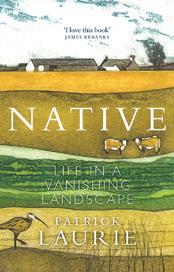
Concluding our series of extracts from his award-winning book, Patrick Laurie learns how to bid successfully at the ‘masterclass in suppressed emotion’ that is the Castle Douglas cattle sale
By Patrick LaurieIt’s easy to see meat when your beast is dead and skinless, but I challenge you to pick out ‘good’ from ‘less good’ when it’s standing upright in a thick, baggy skin. Some of the butchers in Castle Douglas can measure up a walking beast without breaking step. They’ll give you a scarily accurate stab at value and cost off the back of a fag packet as the auctioneer drones on and pigeons clatter in the rafters.
A few breeds attract more money because they’re famous
and customers are willing to pay a little more for the kudos. There’s always a market for Galloway beef, but nobody mentions Riggits on their marketing bumf. The name is too obscure to add value, but it’s not too much to hope that’ll change. It’s lucky that the farmers who worked so hard to rescue Riggit Galloways from extinction had their heads screwed on. They know that markings don’t matter when the skin’s off and the frame is hanging from a hook. Riggits are
traditional, stocky animals, but they have good flesh in all the right places. That’s where live animals start to be recognised as joints and are measured on meat yield. Butchers count the number of steaks they can slice out of a long back; they peer at the legs and hunt for the rump that is square and plump.
I didn’t know any of this when I began to look at Galloways. I saw nothing but uniformity, and the fine details went far over my head. Back when I was dithering about

cattle, I went to a stock-judging competition laid on for young farmers by the Galloway Cattle Society. I was baffled by a relentless procession of identical black animals. That was one of the reasons why I took to Riggit Galloways in the early days; it’s easy to tell them apart.
My beasts became so familiar that I began to memorise their shapes. It didn’t take me long to home in on conformation, and soon I was conjuring up fine details of length and girth. I thought one of my calves was the most stunning beast I’d ever seen, but she grew into a cow with many failings; she was skinny at the back and narrow along the spine. Meanwhile, one of the ugliest heifers filled into beefy perfection. Her markings were all wrong, but she made a stunning silhouette. I was learning to balance beauty with function. If I wanted to produce good cattle, I’d have to bring both together in a single beast. And I’d got the very one in mind.
The Annual Show and Sale of Belted and White Galloway Cattle is a landmark in the Galloway year. People come from all over the world to see our cattle sold, and the brickyards hum with excitement on the Market Hill in Castle Douglas. Most of this buzz wells up around Belted Galloways, the
most famous black-and-white beasts in Scotland. The finest Belted Galloway bull might sell for less than a tenth of what you’d pay for a high-octane commercial breed at Perth, but there’s nothing part-time or hobbyish at Castle Douglas. Big exports go across the world, and the bulls are polished to a glassy sheen of perfection.
Speak to some of the breeders at Castle Douglas and they’ll list the many virtues of Galloway cattle. Some are working towards top-notch beef; others need hardy livestock for conservation projects like mine with Riggit Galloways. There are all kinds of reasons to take the day seriously, but it’s surprising how many folk lean on a vague feeling that native breeds are fundamentally important. You find the same words and ideas when people gather to play folk music or take part in old dances. Maybe it’s helpful to abandon yourself and be part of an old tradition sometimes, even if you can’t put your finger on why that continuity and repetition is so valuable.
White Galloways are often tacked on to the end of the Belted Galloway sale, and a few beasts are sold once the main roar of excitement has passed. It seems unfair to relegate the white beasts to play second fiddle behind their belted cousins, but these are the quirks of fancy and taste.
In a bid to raise their profile, the farmer whose Riggit heifer I wanted to buy had lobbied to sell his trio of the beasts as the first pedigree Riggits ever sold at Castle Douglas. The Riggit Galloway Cattle Society hoped that this would generate some much-needed publicity and interest. The farmer was granted his wish, but the heifers were tacked on after the White Galloways like an afterthought. It was a telling reminder that Riggits occupy a small corner of a very marginal world, and their presence is often merely tolerated.
I went to see the heifer in her pen on the morning of the sale. She stood quietly with her sisters and I chatted to the farmer as I wrung my sale catalogue into a mush of nervousness. He knew I was bound to bid, so I didn’t even try to hide my anxiety. They would come on last, shortly before the store cattle and the commercial beasts.
Any fool can buy a cow, but the experience is meaningless without fine attention to protocol. After several centuries of determined Presbyterianism in Galloway, this is a masterclass in suppressed emotion. It’s forbidden to show any expression as the bids are made. You shrug and suck your teeth. If you can attract the auctioneer’s attention by throbbing a vein on your forehead, then you’re starting to get the idea. Tradition dictates that all faces around the ring should be left utterly blank; allowances are sometimes made for expressions of despair and boredom. In this game, triumph and defeat run in screaming riot behind a screen of pessimistic indifference.
I worked hard to wipe every crease of expression from my face. Deep breaths. I stared at the
sawdust as the first Riggit came in and jogged in a wobbling trot around the ring. The auctioneer reminded us that these were the first pedigree Riggit Galloways ever to be sold through the ring in Castle Douglas. I fought the rush and wondered how many Riggits have passed through this ring over the last century without any official recognition or endorsement. They would have been bizarre throwback store cattle, sold with a shrug of confusion. But yesterday’s freak had become today’s pedigree. The first heifer sold, and not for big money. She was my least favourite of the three, but I’d just seen Belted Galloway heifers sell for almost three times as much simply because their stripe was around the middle rather than along the back. So much for logic.
Then my darling entered the ring. I tried to count backwards. Nobody wants to jump in too soon, and the auctioneer began to lower the starting price. I stared at the ground and pretended not to care as my pulse roared in my ears. A child laughed and the crowd continued to dribble away through the open doors.

Then bidding began. Somebody started us off, but I
couldn’t look. I only knew that they were behind me and to the right. I ignored it and caught the auctioneer’s eye with sheer willpower; he must have felt the fury coming off me. His hair would’ve been sizzling with it. I’d set a budget, but that was exceeded in a short titfor-tat exchange of 100 guineas a time. I strove to focus my roaring nerves into a single, gentle nod of my head as if nothing could matter less and I was already thinking about what I would have for lunch. The hammer fell at 900 guineas. The auctioneer announced my name to a clerk without having asked it. I’d never seen either of those men before, but they knew me because they knew my father. A tall, smiling guy from Connemara was standing beside me and he turned to shake my hand and said, ‘That’s a grand wee beast.’ He hadn’t even realised I was bidding until the gavel fell. I’d won.
Picture: Sharon TIngeyNative: Life in a Vanishing Landscape by Patrick Laurie is published by Birlinn (£9.99, pbk) www.birlinn.co.uk
Your name, and a little background about yourself (e.g where you live/grew-up, what you do for work/a little about the company/farm)
Ellie Louise Sinclair, I live and work on our family farm, Sinclair Agricultural & Recycling Services in Aberdeenshire. We are agricultural contractors and we also have a large haulage business. Originally we were dairy farmers, but in 2007 we sold all the cows and focused on agricultural contracting. We are now heavily involved in renewable energy. On the farm where the dairy was based, we have now made use of those buildings and surrounds by building our own Anaerobic Digester. Our farm land now
solely supplies our own AD Plant with all the feedstock it requires, all coming from a 1 mile radius of the plant.
Within the family business,
I am the Digestate Manager. We currently have a contract with Aberdeen City Council to supply feedstock, haulage and waste removal and disposal for their own Anaerobic Digester that they have built next to their brand new event complex (TECA)! My role is to organise and coordinate the removal and spreading of the liquid and fibre digestate from the TECA site.
How are you involved in agriculture?
I live and work on our family farm. I was once a keen member
of Inverurie Young Farmers Club, I was very much into the social aspect of SAYFC. Throughout my time at young farmers, I won a couple of rosettes for the odd lemon drizzle and the odd batch of fudge, however I was more likely to be found prancing around a dancefloor with a drink in hand!
In your opinion, what are the biggest issue/s (and possible solutions – if any!) facing agriculture?
Attracting people into the industry is a nightmare. Agriculture is hard work and long hours, and there aren’t a lot of people who are willing to do that anymore. I completely stand by the fact that there should be
a work / life balance, but there are times in agriculture where that has to take a step to the side. There are times throughout the year within agriculture that are unavoidably busy.
Another issue that agriculture is facing, like every other industry, is the rising costs. Fuel, fertiliser and retaining staff are a constant drain on the industry!
What advice would you give to your younger self when starting out in the industry?
Be CONFIDENT. There is very much an underlying gender issue, I don’t want to use the word ‘discrimination’, within agriculture. Women really do have to push hard to be heard and a lot of the time. I found, and



still do in fact, there is a certain level of expectation that differs to a male counterpart. So I would definitely tell my younger self to not be embarrassed when the yard is full of men, don’t let anyone tell you that you can’t do something and always make sure you take pride in what you do.

There are a lot of misconceptions as to what agriculture is or what you have to be or do to be classed as a farmer! You can still work within agriculture and not have ever driven a tractor!!
Also, being the ‘bosses daughter’ or a ‘farmers daughter’ comes with a whole load of other complications! But we won’t go into that!! Ha ha!
Do you have any hobbies?
Yes! I love shooting. I try and get out shooting as much as I can, whether that be clay grounds, simulated game days or the real thing! I also love travelling. Of course in the last few years it’s definitely just been around the UK, but that has been great. I’ve ventured to lots of new places throughout the country, and in fact next week I’ll have been in all four nations of the UK within about 9 days! Including the Republic of Ireland, as I’m being treated to a trip to Dublin for my birthday!
Why did you decide to join WiAS?
I initially decided to join WiAS as I wanted to be part of a group of like minded people. I really feel like I’ve found my tribe within WiAS. I really wanted to meet other women across Scotland that were in a similar position to me!
What standout moments have there been for you since joining the group?
I have a few standout moments actually.
Firstly, how welcome I was made to feel within the group when I joined the committee. I was completed shocked when my name was announced to be part of the committee. I was incredibly nervous, but the girls put me straight at ease!
Secondly, I was given the opportunity to host a WiAS event in March of 2022! I love organising events, so I definitely took that in my stride. Alongside the help and contribution from the rest of the committee, the event was a great success! You can’t normally boast about beautiful sunshine and 17 degrees in the middle of March in Scotland, that’s for sure!
Lastly, what really stood out for me recently was the reception we received when we hosted a breakfast at the Royal Highland Show! The turnout for that event was fantastic and it was a hugely successful event that I am sure everyone that participated enjoyed thoroughly! It was great to see so many like minded people in one room!
Why, in your opinion, is WiAS important?
WiAS is important as it provides a platform for women in agriculture to find a space where they can relate to a lot of their fellow members! It’s a space where stories can be shared, good or bad, experiences, tips and tricks of the trade!
What would you say to someone thinking of joining the group?
I would encourage anyone thinking about joining to do so! There is no pressure and to sign up is free! The group is for absolutely everyone! It is really a great way to network, as well as learn new skills with plenty of opportunities for farm visits across Scotland!
How can someone get involved in WiAS?
You can become involved by becoming a member through our website! From there, you will get invites to any upcoming events!
Our next event is the WiAS AGM on the 9th of November at the Royal Highland Showground. We will have a range of speakers, opportunity to catch up with friends and meet new people, as well as lunch and refreshments!
The swallows have gone and have been replaced by the Barnacle geese flying in from their Norwegian homeland. They are accompanied by the arrival of the wildfowlers and the daily greeting on our darkening early morning dog walks, switches to the booms from the shooters, from the clucking from the nearby pheasant rearing pens, now mothballed for the winter.
My Bird Nerd ap on my phone, which has all summer identified the birds you can hear but not see, doesn’t recognise geese of any kind and despite being told by the local RSPB warden that you can identify them by their call, which is either “winkers, wonkers or wankers” – they still all sound like geese to me, albeit with a Scandinavian accent.
Harvest thanksgiving too has arrived and we are very grateful in D & G for the marvellous summer we’ve enjoyed and the bulging hay barns due to spells of more than three days without rain!
Last week we had a visit at the church from Hugh Pym, of BBC Health Editor fame, who, with a group of friends from St Columba’s
Church, in London (next to Harrods) were visiting some of the significant historic sites in the area, including The Ruthwell Cross. Lovely normal people! They enjoyed the chat during the “finger buffet” after the service and in particular that country churchgoers combine walking their dogs with the Sunday service, earning my dog pride of place on the front page of the next St Columba’s newsletter, much to the disappointment of our local politicians, who don’t normally come to the church but had turned up for a photo opportunity!
Having rung the church bell with tears in my eyes 96 times, (it’s a very small bell) only two weeks before, to mark the passing of HM The Queen, it was lovely to celebrate the joys of our village with visitors.
The spectacular autumn sunsets have returned and I’m wakened by the sound of the geese coming off the Solway to graze on the fields. Late summer evenings on the patio with neighbours, are now sausage casserole nights in but the company and fun remain the same and it will be no time until the swallows arrive again …
The brother of the founder of the Field Marshall Club shares the family story that inspired its creation.
The Marshall Club – once known as the Field Marshall Club – only exists today because of a very special tractor, bought by a mother for her two boys.


Brothers, Ross and Peter Anderson sadly lost their father Fred when Ross was 14 months old and Peter was still two months off being born. Their uncle Ted Pullen, who moved next door and played a prominent role in their lives growing up, later encouraged their interest in tractors and steam engines. On one fateful day when Ross was nine and Paul eight, he took them see a Field Marshall Series 2 that was for sale.
The boys were enraptured. “Mum (Jean Anderson) bought her for us for £35 and she came to us on November the 9th 1968,” remembers Ross. “We
got her delivered on the train and then drove her the rest of the way home, and then stored her on the farm next door.”
“She was only 20 years old when we bought her, but we still rubbed her down all by hand with a wire brush, repaired a frayed decompression cable and a broken clutch cable. She was hand painted by my uncle Harry Pullen who was a coach painter. She’s still got that paint – you can’t even see the brush strokes.
“Mum encouraged us a lot, and we took the Field Marshall to rallies and shows all over the country. I was into it, but Peter became a real fountain of knowledge about it.”
Founding the club Inspired by their Field Marshall, Peter and his friend Wally Hawkins, later founded the Field Marshall Club in 1988.
“We thought it would just get 50 members, but it grew to over 500,” says Ross. “So the most important thing about our tractor is that it led to the foundation of the club.”
Peter even befriended Henry Marshall himself, who became a great supporter of the club, says Ross.
As part of the club, Peter wrote a newsletter, but he really struggled with his writing and spelling, and so eventually went back to night school. He improved so much that he went on to write two books about Field Marshalls, says Ross.
Life-changing tractor
“Peter was told he would never amount to anything, but this tractor changed everything,” says Ross. “Without her we could have become football
hooligans or something, but instead we spent our time repairing and recycling with her.”
“She’s a very special tractor and she means a lot to us. I’ve had people come round and try to buy her, and one guy who even slammed down a blank cheque. I tore it up and said ‘you’ve not got enough money to buy this tractor’.”
‘Bub’ as she’s affectionately named now, after Ross’s nickname for Peter, who died five years ago, will hopefully be making an appearance at the Newark Vintage Tractor and Heritage Show on 5-6 November.
“It’s the 75 year anniversary of the Field Marshall Series II, so I’m planning to rub her down and take her out,” says Ross. “It feels fitting that I’m there to represent Peter, too.”

Professional engine remapping is an increasingly common way for farmers to enhance tractor power, but owners should be aware of the potential pitfalls and consequences that could occur if a tractor’s health isn’t considered before engine remapping software is installed.
Long wait times for new machinery and high purchase or trade-in costs are forcing farmers to consider machinery upgrades more carefully, and being able to increase power of existing machinery can be seen as a more cost-effective option.
Professional engine remapping edits the engine ECU at source within the parameters of the tractor and can safely tailor power to application, but should only be carried out by a professional and qualified person, that advises on understanding the tractor’s health before installing any software.
Gareth Jones, director at Avon Tuning, who offer an ECU remapping service for agricultural
machines, says that testing tractors on a dynamometer, before deciding on power increases, will offer a clear indication about the condition of a tractor.

“Exerting varying loads on the engine will highlight if there are any concerns about how the tractor is operating. We would never advise installing a remap on a tractor that isn’t mechanically sound, as the consequences in doing so could be detrimental.
“If you are being recommended that your tractor, sprayer, forager or combine can have an increase in power way beyond its current level, you should be questioning how safe this is. Power increases might seem like a cheap way to boost output, but they must be done professionally so that reliability and machine health isn’t compromised.”
There is growing demand for professional remapping software, that edits many of the engine’s characteristics to increase power and torque, but
Engine remapping can be seen as a cheap way to increase tractor power, but understanding the condition of a machine before a remap is installed is vital, says Gareth Jones
also lower fuel consumption in a safe and reliable way. Avon operate a trained network of authorised agents installing remaps nationwide and import specialist Dimsport dynamometers to provide accurate tests on machinery.
Not only is establishing if the tractor is in good condition essential, but being advised by an authorised agent on safe
power increases that work within the limits of the machine will maintain reliability following a remap.
“Our Dimsport dyno tests allow us to fully understand the health of a machine and what impact any power increases may have. A lot of our initial work is advice and making sure the customer is aware of the safe increases open to them.”
The plough still plays a major role in modern arable farming for controlling weeds and managing crop health. Due to the wide variety of soil types around the world, no machine needs to comply with such a wide range of site-specific conditions as the plough. Pöttinger, the arable specialist, is kitted out for the future with the new generation of hitch-mounted reversible ploughs, the SERVO 4000: a simple and intuitive control centre, an extremely robust turnover mechanism and a high-strength frame as well as
optimised mounting geometry. Together with the proven mouldboards, the SERVO 4000 is equipped for many years of professional use.
The new hitch-mounted reversible ploughs are offered in Standard, NOVA, PLUS and PLUS NOVA versions with four to six furrows. NOVA and PLUS NOVA ploughs feature hydraulic stone protection with an adjustable triggering pressure of up to 1,400 kg. This prevents damage to the plough and enables ploughing without interruption. The SERVO 4000 series is available with a pointto-point spacing of 95 or 102 cm and an underbeam clearance of 80 cm, or 90 cm as an option.
The TRACTION CONTROL system actively transfers weight from the plough to the rear axle of the tractor. The resulting increase in traction ensures efficient ploughing with reduced wheel slip while minimising harmful compaction of the soil. Preventing compaction promotes
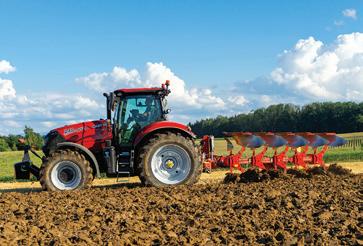
plant growth, soil life, and access to water and nutrients. In addition, fuel consumption can be reduced by up to 10 percent. That is pure cost efficiency.
The SERVO 4000 has greasing points that are easily accessible to minimise maintenance requirements as far as possible. Moreover, all reversible points are DURASTAR quality with a tungsten carbide armoured layer as standard. This contributes to a significantly longer service life.
Fendt has developed a new front loader with a dedicated valve block, new weighing function, greater flexibility of movement, and heavier load carrying capacity. The Cargo 6 will be available on the new Gen7 700 Vario tractors and is the first Fendt loader to be fully independent, making it possible to use all the tractor valves with the loader attached.
“It is a function that will help in so many situations. Having a loader with three independent functions (lift, tip and a third valve) without using valves needed for other implements will save operators time and enable tractors fitted with this loader to be more versatile,” explains Fendt’s Ed Dennett.
A clever new hydraulic locking function enables tools to


be changed in any position with the added benefit of an easy-touse mechanical lock and without having to crowd back the loader fully. Maintenance time has also been considered by positioning all hydraulic components in the cross beam to reduce dirt and mechanical damage.
The loader has a continuous lift capacity of 3,500 kilos and a maximum lift capacity of 4,150 kilos. This combined with a 4.85 metre lift height and a loader frame width of 1,140 mm offers greater loading stability and flexibility, especially with the new 2.55-metre-wide bucket.
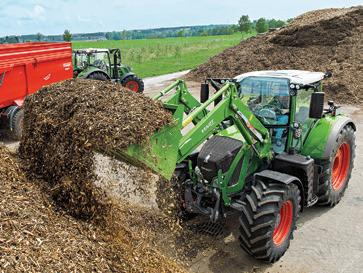
The top CargoProfi model features an integrated weighing function offering both individual and total weight in each position. The button activated weighing function is also fully integrated into the Varioterminal, so operators can access loading data such as the counter and target weight.
A new ‘memo’ function will also store boom and tool positions
which will be especially popular on machines used by multiple operators. Operators can limit the lifting height and tilt angle, and store these as pre-sets, which will help to reduce the risk of catching low buildings or when loading very high trailers.
End position and speeddependent damping ensures the front loader is raised gently and smoothly and will help to minimise losses, whilst a shake function has been introduced to help deposit stubborn materials. Hydraulic accumulators act as shock absorbers to prevent vibrations and a built-in cushioning system, together with front axle suspension and cab suspension to improve ride comfort.
“This is a great example of honing a rudimentary piece of machinery to improve operational efficiencies and make life easier for the operators spending hours in the driving seat,” concludes Mr Dennett.
The McHale Fusion Integrated Baler Wrapper has been the machine of choice for farmers and contractors around the world. McHale are proud to present the new McHale Fusion 4 Range of Integrated Baler Wrappers comprising of the McHale Fusion 4, the McHale Fusion 4 Pro and the McHale Fusion 4 Plus with film binding technology.
In designing the Fusion 4, operator comfort and friendliness were at the forefront of the machine’s development. All machines in the Fusion 4 range deliver a number of new features with the higher end Fusion 4 Pro and Fusion 4 Plus being ISOBUS compatible allowing the operator to experience the highest level
of customisation and machine performance.
The new Fusion 4 range introduces our most advanced pick-up featuring enhanced throughput, increased bale density and faster wrapping speeds. A focus has also been placed on operator comfort whilst still ensuring the reliability and heavy-duty build quality that McHale is renowned for remains. Building on this reputation, McHale has added the following new features:
McHale have created their highest output pick-up for the Fusion 4 range. The new ProfiFlo pick-up has been designed to increase crop intake through more efficient crop flow and has been engineered to ensure
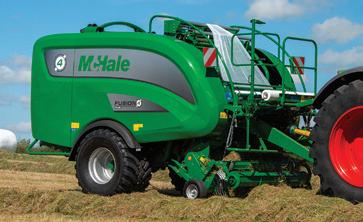
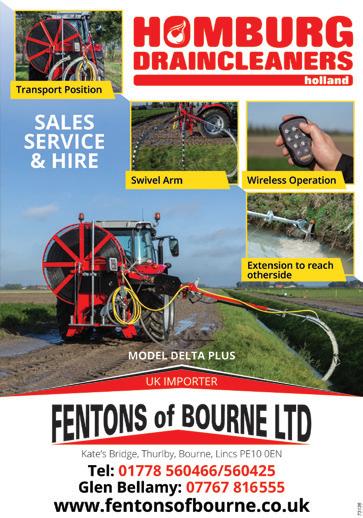
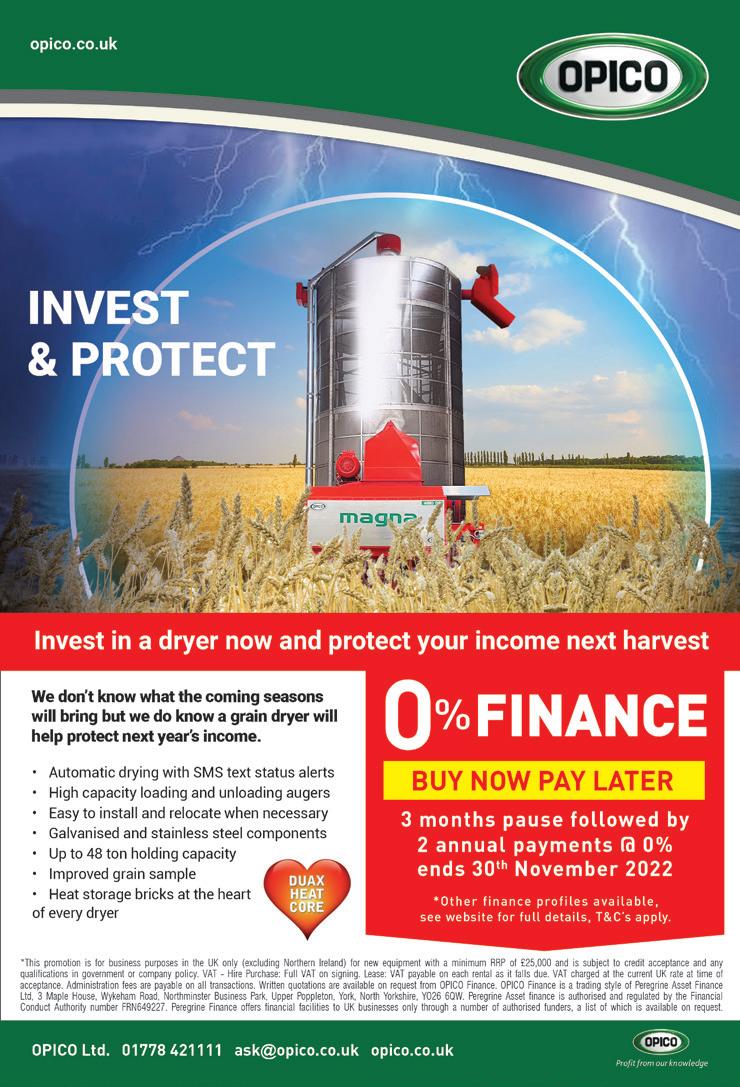
end users are operating with a high-performance pick-up that is designed to suit various working conditions.

The new tapered feed channel encourages the crop to flow from the pick-up, towards the rotor and into the bale chamber, maximising throughput. To reduce maintenance, all ProfiFlo pick-ups are fitted with a heavier driveline which reduces chain load and increases chain life.
Customers can choose between a 5-tine bar cam track pick-up or, the optional, 6-tine bar camless pick-up which has increased in width. Behind the tines, customers will notice a number of changes to improve the flow of crop into the chamber.

McHale have also introduced the Adaptive Intake which has been specifically designed to allow the intake area to automatically adjust up and down to changes in material flow.

For the 2023 model year, the SCORPION telehandlers from CLAAS will receive a comprehensive facelift. In addition to improvements in operator comfort, the smaller models also have new engines with more engine power.
CLAAS has had telehandlers in its product range since 1994 and from 2019, the machines have been developed and built in cooperation
with Liebherr. Six models with 143 and 156 hp engines currently cover a range from 7.5 to 11.7 t operating weight, 7.0 to almost 9.0 m stacking height and 3,200 to 6,000 kg lifting capacity.
The entire SCORPION model series from CLAAS is equipped with efficient, powerful four-cylinder engines from Deutz. For the 2023 model year, the 3.6 l Stage V engine in the SCORPION 732, 736, 741 and 746 models has been optimised for greater efficiency and performance in cooperation with LIEBHERR. As a result, the SCORPION 732, 736, 741 and 746 models each have 50 Nm more torque and an increase in power output of 6 hp. The compact engines remain economical in operation and maintenance, as usual, and are characterized by low maintenance requirements.
The SCORPION 741, 736 and 732 models have been fitted with the hydrostatic VARIPOWER 2
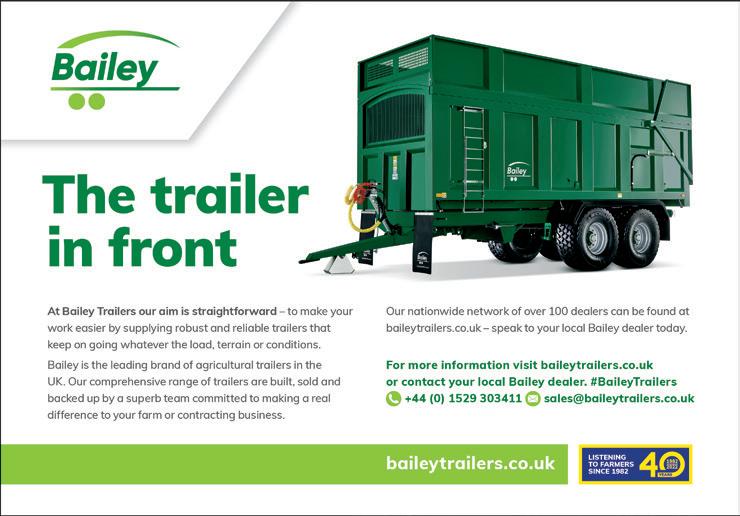
drive from the CLAAS JAGUAR since 2021. The compact drive unit with its highly efficient, hightorque twin motor ensures a long service life, further improved drive efficiency and a lower noise level on the road. The driver has three driving ranges available – 0 to 20 km/h, 0 to 30 km/h and 0 to 40 km/h – which can be preselected with the press of a thumb, with a maximum speed of 40 km/h. The final speed is reached at a reduced, fuel-saving engine speed. The braking behaviour of all SCORPION has been further optimised by new components such as the brake valve and brake pedal along with new software tuning. An automatic parking brake is standard as a braking assistant for uphill and downhill gradients, which prevents the machine from rolling away.
Revised cab with new air conditioning
The cab on the SCORPION has also been further developed.
A new air conditioning system with increased air volume improves driving comfort, especially on hot days. A new, angle- and height-adjustable steering column with automatic indicator reset optimises
ergonomics and ensures greater safety when driving on the road. In addition, the steering mode switchover has been optimised so that the four steering modes can be set even more reliably and precisely.
Krone has launched two new high-end forage harvesters, the BiG X 980 and BiG X 1080, in direct response to an increasing global demand in the 900hp to 1100hp segment. Only the BiG X 980 will be available for the 2022/23 season in the UK.
Like the 1156hp BiG X 1180 in the range, the two new models will also be powered by a Liebherr V12 engine, boasting an extended 1000-hour oil change and service intervals for filters and valves. All models in the range are naturally
compliant with Stage
4f standards (the
only
and
Both models feature a modified PowerSplit that allows the operator to customise engine power to current requirements at the touch of a button. They have the option of economical EcoPower mode, and in situations requiring full engine output, the operator selects X-Power. The advantage of this technology is to boost efficiency and give greater fuel economy.
Other pioneering developments that make the high-end BiG X unique in the forage harvester market is the innovative crop flow assembly that consists of six pre-compression rollers, a massive chopping drum and the OptiMaxx 305 and CornConditioner. Its huge conditioning surface area ensures intensive grain and stalk processing.

VariStream, that consists of a spring-loaded floor beneath the
chopping cylinder and a springloaded plate behind the crop accelerator, is also included to minimise blockages and ensure smooth crop flow.
Another unique versatility improvement is VariLOC – a gearbox inside the pulley that drives the chopping drum – that enables the drum speed to be reduced from 1250 to 800rpm, while increasing cut length by up to 50%.
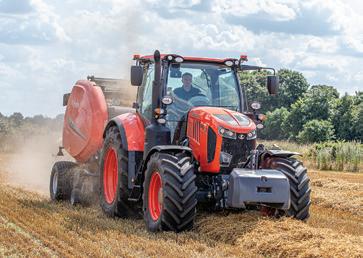
Kubota (UK) Ltd has extended its range of Kubota Care tractor warranty packages to include a five-year term that now offers up to 6,000-hours of protection.
This latest option provides an additional 1,000 hours of cover

over and above the previous maximum Kubota Care term of five years/5,000 hours, making it one of the best warranty packages in the industry.
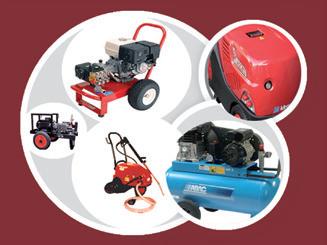
Available on M6-002 and M7003 models, this latest warranty extension can be selected up to 30 days following the installation date of the new tractor purchase, creating a competitive fixed cost of ownership and peace of mind for up to five years and 6,000 hours.
“Reliability and durability are synonymous with the Kubota brand, and this extension of our Kubota Care packages adds yet more assurance to the quality of Kubota tractors,” explains Tim Yates, Kubota (UK)’s agricultural and ground care sales manager.
“We’ve offered a five year/5,000-hour warranty option across the M-series for a few
years, but we’ve recognised that M6-002 and M7-003 models are those that are likely to be worked longer and harder,” adds Tim Yates. “And this has led to the extension of our existing five year/5,000-hour package to a five year/6,000-hour option.”
Kubota Care is an extended warranty scheme that is backed by Kubota, and is not a thirdparty insurance policy. As such, Kubota Care does not require customers to pay an excess for any warranty claims that may arise.
In addition, any unused Kubota Care warranty is also transferable with the tractor when supported by a full service history from the Kubota dealer network. Such flexibility increases saleability and can contribute to a higher residual value.

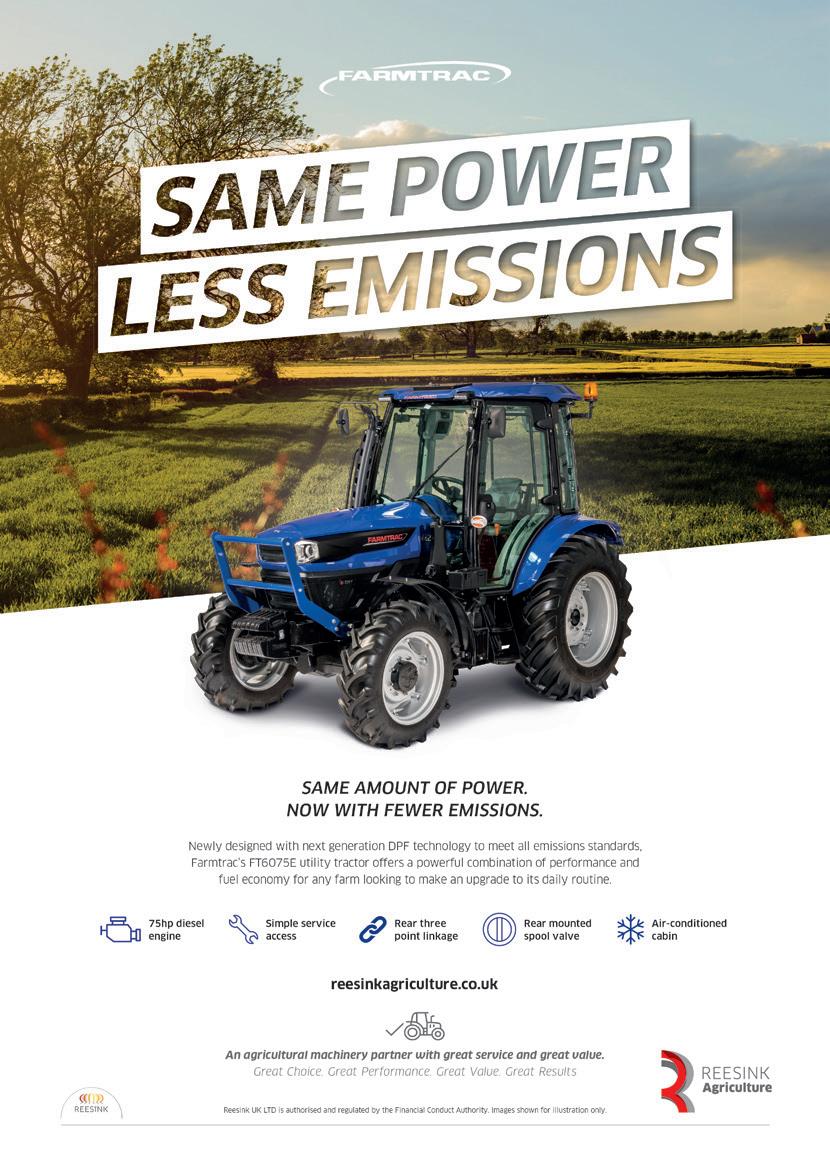

It was way back in 1969 when the first Amazone sprayer made its debut onto the market. Designated the S range, those original 400 and 600 litre mounted sprayers started a journey towards the unbelievably comprehensive Amazone sprayer programme that we see today. That range includes UF mounted sprayers from 900 – 2000 litres (plus front tanks for up to a 3,500 litre wraparound combination), UG and UX trailed sprayers from 2,200 litres through to 11,200 litres, including the new UX 01-L in 8,000 and 9,000 litre tank capacities, plus, of course,
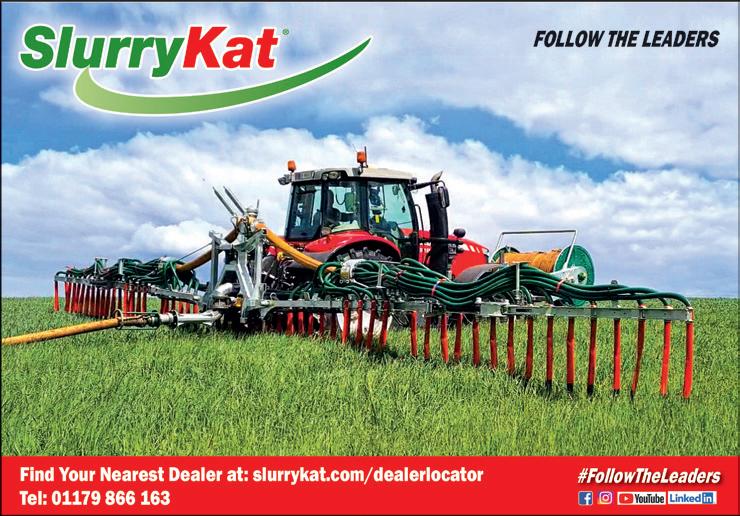
the flagship self-propelled, the all-new Pantera 4504.
Today, the Amazone family business, and the two owners Christian and Dr. Justus Dreyer, see it as their task to continually increase precision through innovative crop protection technology in order to further protect the environment and to reduce costs. But as the machine was taking shape on the drawing board back then, the design team could not have comprehended the complexity and level of technology that would be found on an Amazone sprayer those 50-
odd years later - a case of from little acorns then major oak trees grow.
And it was that unique technology that first drew farmers and contractors, Robert Davidson & Son Ltd, to the Amazone sprayer range when they heard about AmaSelect, the unique electric individual nozzle control system that not only reduces chemical usage by the GPS actuation of 50 cm boom sections in short work, but also automatically enables the operator to have the correct nozzle size always in use as well as being able to select the appropriate nozzle type from the cab.
Robert Davidson & Son Ltd has been farming in Essex since the 1920’s and settled in Peldon in 1946. The farm has grown exponentially since then with the current acreage at around 1350 ha with a mix of cropping that includes continuous winter wheat on the home farm plus,
elsewhere, some marrowfat peas and then increasingly crops for energy, with rye on the lighter land and then maize grown for both foraging as well as for the combine. On top of this area, another 800 -1200 ha of maize and rye are foraged for neighbours as well.
At Robert Davidson & Son Ltd, different spray rates are utilised for different operations as well as an increased use of liquid fertiliser so the ability to select the right nozzle from the seat was going to be extremely
useful. Having loaned a machine while they waited a year for the AmaSelect system to become a reality, September 2015 saw the new 40m-boomed, Pantera 4502 arrive at Brickhouse Farm, Peldon, Colchester. Now with 5,000 hours on the clock and 7 years later, that original machine has now made way to its improved successor, a brand new Pantera 4504 and, remarkably, the 75,000th sprayer to have rolled off the Amazone sprayer production line and thus a major milestone in Amazone history.
The Kramer telehandler series from 3-5.5 tons payload is receiving a facelift, which will be presented to the agricultural
audience in November. The visibility of the work area is a crucial consideration for telehandlers. Combined with
the focus on safety, Kramer can score points with its new engine bonnet design, which has been put into use for the KT356,
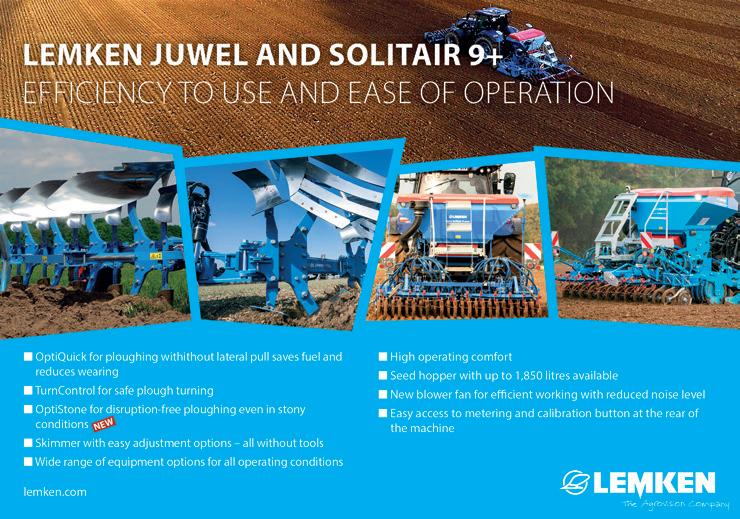
KT307, KT357, KT407, KT3610 and KT457 machines. The result is a best-possible view to the right. In addition, new features like the differential lock and load stabiliser have been subject to an update. The functionality of the machines is therefore optimal for
agricultural applications such as in biogas plants and stables.
Zero emission In 2016, as the first manufacturer, Kramer presented the first allwheel-steer, fully electric, wheel loader. This year, Kramer is
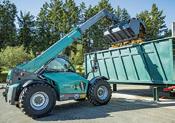

showing the future successor of today’s success model KL25.5e. Alongside the electric wheel loader, Kramer will also present an eTelehandler for the first time. Both machines have the most up-to-date lithium-ion battery technology, which provides more performance, reliability and safety.
Smart Attach Kramer presents the innovative enhancement of its well-known quick change plate. The new, patented and fully-hydraulic quickhitch system “Smart Attach” will ensure greater productivity, efficiency and safety. Customer requirements have been a key focus here, resulting in the achievement of fundamental and sustainable benefits. Kramer’s well-known quick change plate has been a standard piece of equipment for wheel loaders since 1963 and is still a fully effective system. Widespread approval continues to form the basis for further development, which has now resulted in the fully hydraulic quickhitch system, “Smart Attach”. The dimensions of both quickhitch systems are identical, so existing attachments can continue to be used. Increased safety for the operator, no leakage oil discharge and above all, time saved during attachment changes are just a few of the benefits available to the operator with the system.
Find Reesink Agriculture at the Midlands Machinery Show where it will have its own stand and demo area to showcase some innovative, productive and efficient products from FARMTRAC. The show takes place in Newark in November and is free to visitors ¬–so don’t miss out on seeing some crowd-pleasing machines.

At the show with Reesink Agriculture will be the awardwinning, TV-star, the FT25G. Farmtrac’s revolutionary allelectric tractor has made quite the splash since its launch in 2019, impressing the industry’s electric vehicles and technology enthusiasts in person and on TV where it was showcased on BBC’s Country File and Fully Charged TV.
Already this year, the FT25G has wowed audiences at LAMMA and Fully Charged Live and is ready
to do the same at the Midlands Machinery Show, showing businesses how they can benefit from greener technology without compromising on productivity.
Along with the FT25G, Reesink will also be bringing the crowd favourite, the FT26 tractor, known for its ability to get results in a compact package. Earlier this year Farmtrac revealed the FT26 along with its duo partner the FT26H as its best-seller for getting results in tighter areas without compromising on performance. Its light and narrow body makes it perfect for indoor spaces, while its 750kg capacity means that is suitable for a host of jobs around the yard.
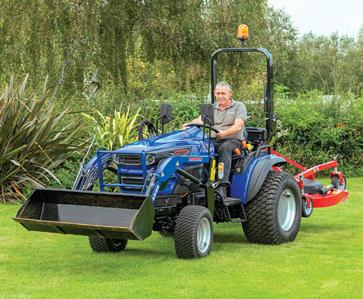
Rounding out the crew will be the 75 horsepower diesel-powered FT6075 model, and the powerful 47hp diesel engine FT6050 tractor. See first-hand the versatility,
compactness and durability of these productive Farmtrac models.
The show which is on the 16th and 17th November 2022
is a great opportunity to see what Reesink Agriculture has to offer on stand D3 and is free to visitors.
The Danish company DALBO A/S, which is among Europe’s leaders in the production of Rollers has been sold to Persefone S.r.l., which is owned by the Italian capital fund Alcedo sgr. Within the Alcedo organisation they own a company called Demetra, which has the BreviAgri and AgriMaster brands, meaning that DALBO will now become a sister company to Demetra.
The takeover does not entail changes in DALBO’s organization, and DALBO will continue as an independent
company with production in Denmark. The current management will continue unchanged, and the head office will still be in Denmark.

Nor will the change of ownership affect DALBO’s existing collaboration agreements and customer relationships.
We look forward to continuing our growth journey with the support of our new owner, who has significant resources at their disposal. The new ownership gives us the opportunity to continue and increase our investments in development, production, and digitization, so that we can continue to provide our customers with the best products at competitive prices.
So, Business as usual.



In the continuing expansion of their dealer network, Boss ORV has appointed two new Corvus dealers. David Taylor Garages and Campey Turf Care are the latest dealers who will be selling the European manufactured Corvus range of 4x4 utility vehicles.


Both dealers will be stocking the Corvus Terrain range of side-
by-side 4x4 utility vehicles, including the exciting new 100% electric Terrain EX4 UTV. Corvus is the first European manufacturer of off-road and homologated 4x4 UTVs vehicles. For more information about the Corvus Terrain range, you can call 01597 810188 E-mail: sales@bossorv.co.uk Web: www.bossorv.co.uk
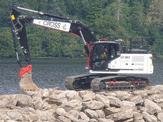
THEIR
THEIR FIRST NEW
DEMO SPEC TO THEIR FLEET
OF THREE HIDROMEK WORKING FOR CROSS CIVILS IN ABERFELDY
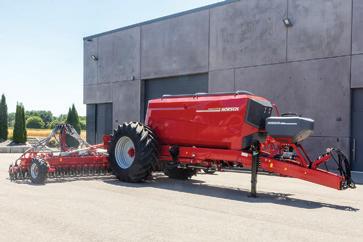

HORSCH is adding 8m, 9m and 10m working width models to its Avatar SD range of direct drills. The new models feature the same 25cm row spacing and specifications of the 12m Avatar 12.25 SD model launched last year, allowing the Avatar SD to meet a wider set of customer requirements regarding farm or tractor size.
The Avatar 8.25 SD, Avatar 9.25 SD and Avatar 10.25 SD as well as the Avatar 12.25 SD disc drills offer the popular 25cm row spacing. The 3m to 8m Avatar SD models are available with 16.7cm row spacing, with the 8m available in both.
“The 25cm row spacing is proving popular with the very successful 12m model. Customers are reporting little to no detriment
in yield in most crops, particularly in winter crops, yet lower input costs. The new models offer these benefits to customers wanting a smaller working width,” highlights Stephen Burcham, General Manager at Horsch UK.
The new models feature a versatile triple tank system with a capacity of 6400 litres. The triple tank offers a 60:10:30 split in capacity while a double-tank option with a 60:40 split is also available. Specifying the MiniDrill allows up to four components to be applied via the SingleDisc seed coulter, providing huge flexibility when drilling and reducing the number of filling stops required.
As an option, trash wheels can be mounted in front of the SingleDisc seed coulters and
remove organic matter, as well as stones and clods, from the row. The settings can be adjusted infinitely to the soil conditions by means of a hydraulic cylinder. In situations of high organic matter, the trash
wheels significantly reduce the ‘hair pinning’ effect, where the disc coulter could press harvest residues into the seed furrow. This effect can lead to insufficient grain and soil contact.
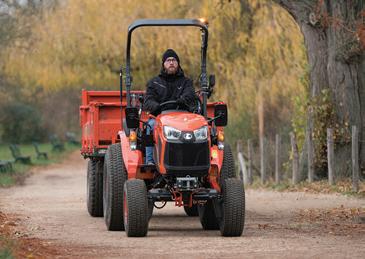
Kubota has released the LXe-261 electrically powered compact tractor. Designed to meet current environmental standards, the battery-powered tractor will be showcased at several key events around Europe over the coming months, before being made available for rental from 2023.
With an increasing number of European markets tightening regulations and implementing bans on diesel vehicles, many local authorities and other public bodies are actively seeking alternatives - such as electric vehicles (EVs) and fuel-cell vehicles (FCVs). In light of this, and in line with Kubota’s Environmental Vision published in 2021 to achieve carbon neutrality by 2050, they have been researching, developing and trialling electric tractors.
One of the major challenges when developing electric tractors is range and operational time. For that reason, the new LXe-261 is equipped with a large capacity battery that can provide rapid one-hour charging and three to four hours of continuous run-time. This means operators will be able to quickly charge the batteries during lunch and continue working in the afternoon for optimal efficiency.
The LXe-261 also includes key features suitable for mowing, hauling, and other green space management tasks, including an independent PTO, HST transmission and multiple hydraulic outlets. The specification of the LXe-261 is contained in a compact size, making this model well-suited to a wide range of applications

Kubota’s new LXe-261 will soon be displayed at several shows including Europe’s largest turf management show SALTEX, at the NEC, Birmingham in November; Salonvert in France and EIMA in Italy. The electric compact tractor
will then be available for rental in the UK from April 2023. After its release, customer feedback will be sought, to shape future development and expansion of Kubota’s eco-friendly product line-up.
Kubota Corporation is the first Japanese manufacturer* to release a limited number of LXe261 electric compact tractors in Europe, with the company actively striving towards carbon neutrality. For that reason, Kubota has been transitioning to electric, hybrid, and fuel-cell drives in an effort to decarbonise power sources and reduce CO2 emissions.
These developments represent an important strategic step for Kubota in the UK and Europe, as it aims to fulfil the requirements of core customer segments who have long invested in Kubota’s range of compact tractors, utility vehicles and ride-on mowers for park maintenance and other groundcare tasks.
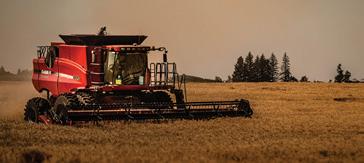
Increasing numbers of farmers and operators of agricultural machinery are turning to fuel additives for improved economy amid the rising cost of energy.
Research carried out by Aberdeenshire-based fuel additives developer Fueltone Pro, revealed that additive chemistry can deliver up to a five percent increase in the fuel efficiency of passenger vehicles – but this technology is cascading to the agricultural industry, where the increase over higher fuel usage is delivering larger gains in efficiency.
Robbie Gray, chairman of Fueltone Pro, said: “Particularly
over the summer months and into the harvesting time of year we see more demand from farms for fuel additive products for their agricultural machinery. This has been compounded by the cost of fuel, and with fuel additives
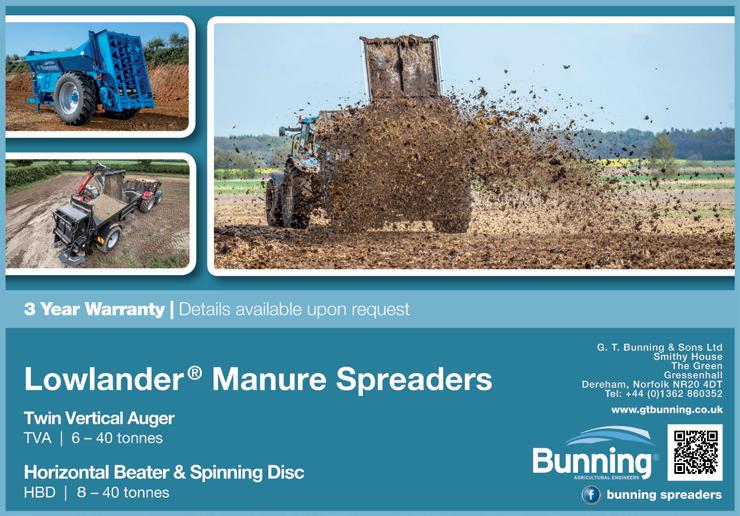
improving fuel efficiency there’s considerable cost savings to be made.”
With farms storing bulk tanks of fuel, it is easy for the user to treat the bulk tank so that each and every fill of a machine gets
the benefits. Additive technology can deliver significant savings by improving machinery fuel consumption, and make tractors, combines and harvesters run smoother by preventing carbon build up, on both fuel injectors and on the diesel particulate filter (DPF).
In the late summer months and looking ahead to winter, it’s crucial that farming machinery can function at full performance. Treated fuel can improve fuel combustion, preventing sootloaded engine oil and excessive fuel injection system wear. Incorporating a fuel additive
to the tank can improve cold weather performance.
Additive formulations will keep an engine clean, meaning the engine will burn the fuel for longer and at a higher temperature, resulting in an increase in power for every millilitre of fuel that the vehicle consumes.
Fueltone’s range of fuel additive and engine flush products sit alongside DPF solutions, that in independent and field tests yielded up to a 14 percent increase in fuel efficiency and up to an 86 percent reduction in particulate emissions.
Designed for use in poultry and livestock houses, Bailey Blower Trailers are one of the most versatile and robust indoor feed trailers on the market.
Bailey Blower Trailers feature a conversion unit manufactured by Priden Engineering which is available as a factory fitted option on new Bailey TB trailers from 16tonne upwards. Bailey only fit the Blower Kit to trailers above 16tonne to maintain the correct drawbar weight.
Bailey Blower Trailers feature a 6” auger which offers farmers the versatility of distributing either cake, granules or pellets efficiently and evenly. The blower is operated from the tractor cab via the PTO shaft. An internal partition is available as an option.
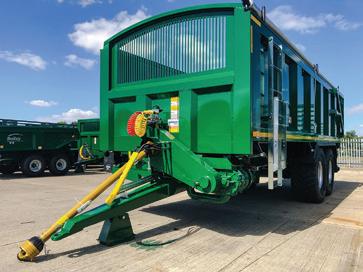
In order for farmers to monitor feed loads Onboard Weighing Systems offer the ideal solution. Bailey specify the ‘Cropweigh’ Onboard Weighing System. ‘Cropweigh’ is manufactured in the UK by Vehicle Weighing Solutions (VWS) and is available as a ‘factory fit’ option on new Bailey hydraulic tipping trailers.
Delighted with upgrade T.D Jones and Co have recently taken delivery of a new 18tonne Bailey Blower Trailer, Mike Jones explains… “We blow wheat and barley into bins for local estates and corn into lofts on dairy farms. Previously we used a converted 8 wheeled truck, we’ve upgraded to a Bailey Blower Trailer and are
The new Fortis AS is a cultivator from HORSCH developed to take advantage of increased tractor power up to 600hp and provide more flexibility in working depth and adjustment options. Fortis 6 and 7 AS, with 6m and 7m working widths, can operate with a working depth between 4cm and 30cm, ideal for a deep loosening and primary tillage. Depending on the conditions, the operator can decide to manoeuvre on the packer or on the chassis, and the changeover is carried out simply by means of a 3-way valve.
The design of the packer focuses on flexibility. The customer can not only select the type of packer but can also decide if the packer is to be connected rigidly to the frame or pretensioned hydraulically. In the pretensioned option, the weight of the front packer roller can be transferred to the rear roller preventing sinking on light soils.
To ensure a consistent levelling quality in this wide working range, the fourth bar was placed further backwards so there is always enough loose earth in
delighted with it. The trailer is easy to use, switching feeds is no problem and the build quality is excellent. In my opinion
Bailey are the best trailer on the market.”
For more information visit bailey trailers.co.uk
front of the levelling discs to get an excellent result. The 27cm tine spacing on the 4-bar design is ideal for shallow tillage and an all-over cutting in all conditions, but also meets the requirements for a lower horsepower tractor performing deep primary tillage.
The option of single or double front support wheels offers precise soil adaption, ranging
from a simple depth control to supporting the machine in case of high working depths. The depth adjustment can either be carried out by the proven clip system or fully hydraulically from the cabin. The Fortis is equipped with an integrated traction reinforcement system which transfers up to 1.2 tons to the rear axle of the tractor to help prevent slippage.



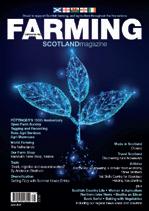
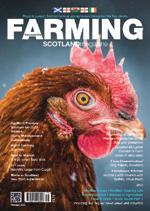


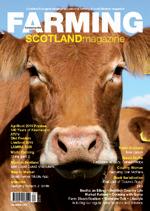
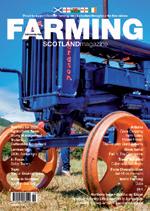
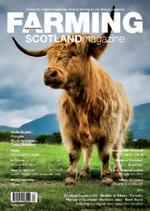
The finance sector is in danger of a surge in cyber-attacks due to a sharp rise in staff using unsecured networks for work, experts have warned.
Employees are increasingly using unsecured public WiFi hotspots while working, leaving businesses “extremely vulnerable” to hackers, they fear.
Leading national business group The Federation of Small Business (FSB) and UK cyber security specialist Linten Technologies said the emergence of remote working and the convenience of public networks made cyber-breaches “incredibly simple” to achieve.
“You are never far from an unsecured network - whether
at a hotel, café, train station or airport,” says Robert Downes, FSB development manager for Greater Manchester.
“Combine that with remote working pushing more financial service employees onto unsecured networks, and the concern is businesses across the UK are leaving themselves wide open to cybercrime.
“Many employees just don’t realise just how risky public WiFi access points are, but they are very easily hacked and make using them a no-no. The simple analogy I’ve heard from experts before is that if you found an open bottle of beer on the bar on a night out, you wouldn’t dream of drinking it just because it’s
there. The same goes for free Wi-Fi.”
PwC’s Remote Work Survey revealed 61% of CFOs in the financial sector were planning to make remote working “permanent for roles that allow it”, while the number of worldwide public Wi-Fi hotspots is expected to reach 628 million in 2023.
The financial services industry is one of the most vulnerable - and targeted - industries for cybercrime through unsecured networks.
In 2018, financial services industry incurred the most cybercrime costs at £16million ($18.3 m).
On average, a financial services employee has access to nearly 11m files the day they walk in the door.
For large organisations, employees have access to 20m files.
In 2020, IBM published a report stating that the average cost of a financial services data breach is now £5m ($5.85m).
“The risk to financial services companies is huge,” says Steven Allan, CEO and founder of Manchester-headquartered IT services provider Linten Technologies.
“With 44% of UK adults believing that public Wi-Fi is ‘safe’, the use of unsecured networks is literally giving cybercriminals the keys to the kingdom.
For more information on cyber security advice, contact www. linten.co.uk
Carlisle-based H&H Insurance Brokers has been named as a finalist in the 2022 Insurance Times Awards in the Independent Broker of the Year category.
The winner will be announced at an awards ceremony held at London’s Grosvenor House on Thursday, December 8.
Paul Graham, Managing Director of H&H Insurance Brokers, said: “We’re absolutely
delighted to have been shortlisted for such a prestigious industry award.
“It’s testament to the hard work of our team who go above and beyond to deliver a first class, personal service to our clients.
“As a regional broker, we’re making an impact on a competitive national market by launching new products

and services which benefit our clients and reflect our ongoing commitment to leading the broking sector, not following it.”
H&H Insurance Brokers, which operates across the North of England, the Scottish Borders and Wales, arranges a broad portfolio of insurance for clients in all types of businesses across sectors including agriculture and
rural, commercial, property, and tourism and hospitality.
Over the past year, the firm has launched the market leading H&H Distinction, a bespoke and exclusive brand developed in partnership with insurance giant Aviva, and partnered with financial planning specialists Sage Wealth Management to launch a wealth management service.
On four themed days during Agromek 2022, we will be presenting innovative solutions designed to make the future of agriculture greener.
At Agromek 2022, the future and innovation area Days of Future will be divided into four themed days. Through exhibitions and discussions, we will highlight some of the issues facing agriculture now and in the future.

On Agromek’s opening day, Tuesday 29 November, you are welcome to view the theme Future Food, on Wednesday Future Digital Solutions, on Thursday Future Machinery and on Friday Future Ownership.
The thematic days are the result of last autumn’s broadly supported political decision approving a green transition in Danish agriculture.
“The agreement to reduce emissions by 55–65 per cent by 2030 will present the agricultural sector with some important choices that will move an entire industry closer to reaching the ambitious goal,” says Agromek’s Managing Director, Claus Hermansen.
“At Agromek, we want to use our themed days to highlight four essential areas of this transition. As Northern Europe’s largest agricultural expo, we have a responsibility to showcase specific solutions and discussions that can guide the industry towards a better future,” continues Claus Hermansen.
Visitors will be able to see these real-life solutions in Agromek’s Science Challenge, in which a group of university students tackle real-life cases presented by six different organisations. The students will work together with each organisation ahead of
Agromek, before presenting their exciting case studies on Tuesday, Wednesday and Thursday morning of the expo, when the cases will also be assessed.
RuleStore is one of the six organisations that have submitted a case study:
“We want RuleStore to become an active player in the agricultural industry of the future. The Science Challenge at Agromek will give us increased insight into the agro-industrial sector’s interest, preparedness and need for digital solutions to handle future agricultural customers’ wishes and development opportunities in connection with solution sales,” says Mads Kjærgaard Larsen, Managing Director of RuleStore.
In addition, the exhibition, through key industry players such as SEGES Innovation, the Danish Technological Institute and the Food & Bio Cluster, will present solutions and proposals for the food, digital solutions, machinery and ownership structures of the future.
“The future of agriculture is digital. And farmers are already embracing these developments –not least with the help of digital solutions from SEGES Innovation. Digital technology is constantly evolving, and the digital solutions of the future will provide even more new and innovative opportunities to develop agriculture. So it makes sense for SEGES Innovation to exhibit at the Innovation and Future area at Agromek,” says
SEGES Innovation Director, Ivar Ravn.
Days of Future will also feature an exhibition in the Growth area, where exciting and innovative organisations present proposed solutions for the agricultural challenges of the future.
The area will also contain a stage where the theme of the day will be discussed and relevant topics will be presented.
On Wednesday 30 November, the focus will be firmly on Digital Solutions of the Future, when SqM-Farm, a project between Agrointelli, Conpleks, Fieldsense, the University of Southern Denmark and Aarhus University, will present the results of their work.
During the history of bee research, scientists have peered deep into the inner life of bee colonies and learned much about the behaviour of these insects. Above all, the bee waggle dance has become a famous and extensively discussed phenomenon. Nevertheless, recent insights reveal that while bees are social insects inside the hive, they also communicate very effectively with one another outside the hive. In this book renowned German bee researcher Jürgen Tautz provides an entertaining, fresh and enlightening account for both lay and professional readers, not only about the fascinating dance language but also about additional remarkable phenomena concerning information exchange between bees.
From the author of the bestseller The Buzz about Bees, new book Communication Between Honeybees assembles, for the first time, a complete overview of how bees understand one another. Although communication biology research on bees has so far concentrated largely on events within the hive, this book now also directs attention to how bees communicate in the field outside the hive.
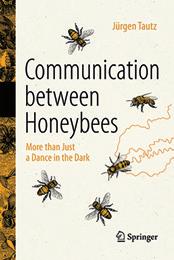
The reader learns which steps new bee recruits take to reach the feeder which a dancing forager has advertised. The book analyses the status of work on the bee dance published over the last 100 years and orders the essential findings as building blocks into a coherent new concept of how bees find their target. In addition, the historical survey of research on the ‘Bee Language’ explains how several contradictory and incomplete hypotheses can still survive.
This is a fresh point of view on one of the most remarkable
behavioural performances in the animal kingdom, leading to previously unknown insights. Such new perspectives clearly reveal both how large the gaps in our knowledge still are in relation to the language of bees, and which direction research must take to complete the picture of one of the most impressive behavioural accomplishments in animals.
Prof. Dr. Jürgen Tautz is a bee expert, sociobiologist, animal behaviourist and emeritus professor at the Biozentrum, University of Würzburg. He is the Chair of the Bee Research Würzburg e.V. and the Head of the interdisciplinary project Honey Bee Online Studies (HOBOS) and the follow-up project we4bee. He is a worldleading, widely-published scientist and a gifted communicator of science. His writing and popular lectures have twice been honoured by the European Molecular Biology Organization (EMBO) who named him among the best scientists in Europe in communicating science to the public. He is passionate about popularising science and making it accessible to all.
Springer | Hardcover | £22.99 | 978-3 030 99483 9
When Sandy Winterbottom embarked on a once-in-a-lifetime adventure to the Antarctic in 2016, she expected to find peace, stillness, and true wilderness. Feeling the effects of mental illness in her family and overworked in her career, Sandy booked a sixweek trip sailing the Southern Ocean in search of much-needed solace and escape. As the only unsettled continent on the planet, Antarctica brings to mind ideas of pristine nature, robust wildlife, and true separation from humanity. Yet, signs of human activity were all around her. The abandoned whaling station overtaken by boisterous fur seals at South Georgia piqued her curiosity, driving what would then become an incredible project exposing the dark history and brutality of Scotland’s twenty-first century whaling industry.
Exploring the whaling station with new crewmates and friends, Sandy stumbled upon something which challenged her staunch view of the callousness the whaling industry and those who perpetuated it¬. A small grave belonging to a 19-year-old boy from Edinburgh who had lost his life here, Anthony Ford, remained with her long after leaving the island. This unique book is at once a travelogue, nature writing, historical exposé, and the compelling, compassionate reconstruction of Anthony’s life and experiences aboard the Southern Venturer, one of the Salvesen Company’s floating factory whaling ships in the 1950’s. Sandy’s and Anthony’s alternating perspectives bring together past and present, connecting two lives and experiences which might have never been united if not for the vast, stunning seascape of the Antarctic.
The Two-Headed Whale is as accessible as it is intriguing, as the
reader discovers new information alongside Sandy and faces both hardship and hope alongside Anthony. The narrative does not shy away from portraying the realities of life for the average labourer aboard a whaling ship and exploitation of both worker and whale is painfully felt. Yet, Anthony is not treated as a mere martyr for environmental justice or worker’s rights– his personality, his relationships, his plans and aspirations are represented with the utmost care and respect.
Themes of the importance of mental health and wellbeing echo throughout this story, as Sandy gains a newfound clarity and motivation from her visit to Antarctica, even if it doesn’t present in the way she had anticipated. Sandy brings light to a vital part of Scotland’s history, one that should be known, and ties it into our overall responsibility to confront the climate crisis. As Sandy faces her own ecological and personal grief, compounded by Anthony’s isolation in South Georgia, we are left with a powerful sense of loss and love for our planet and our home.
The Two-Headed Whale is published by Birlinn. (£14.99, hardback) www.birlinn.co.uk
